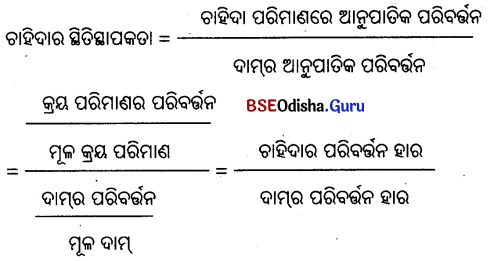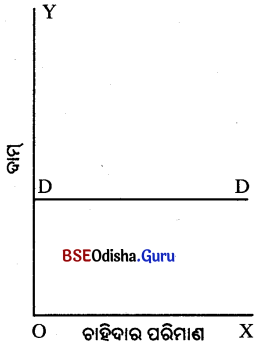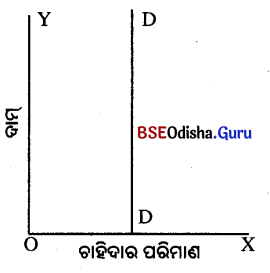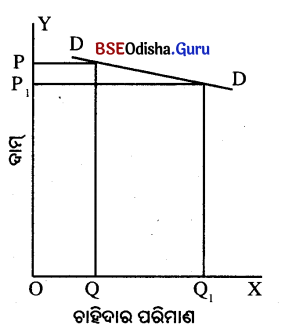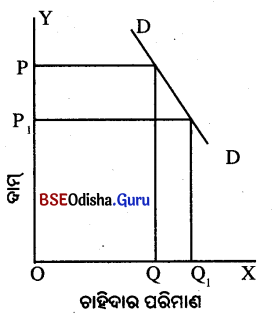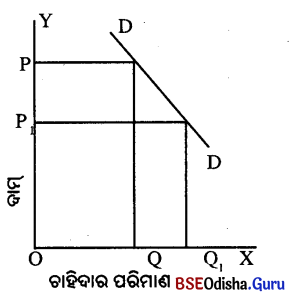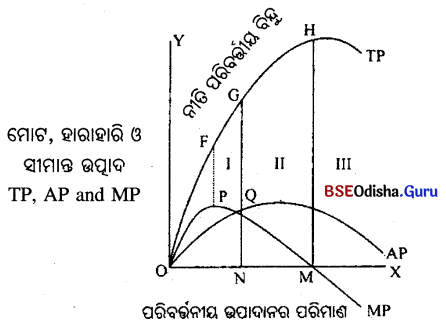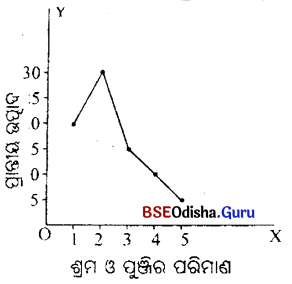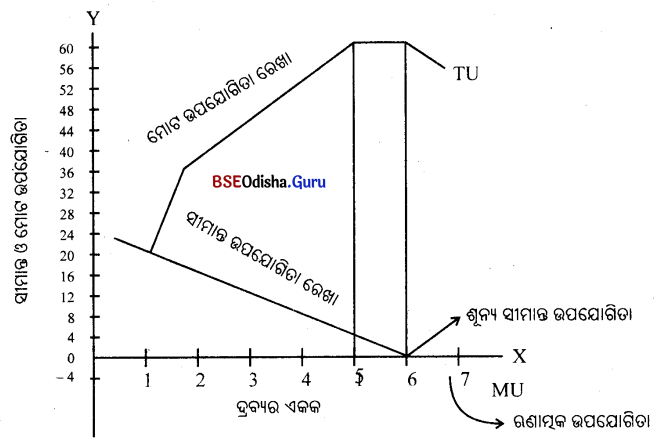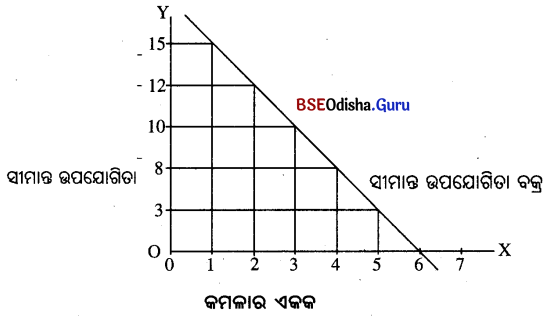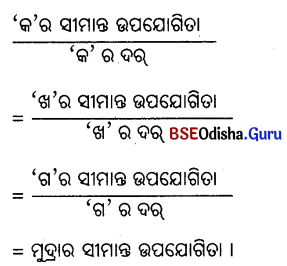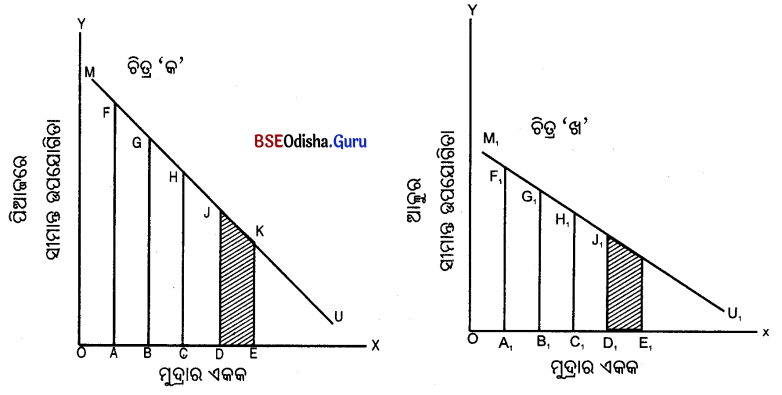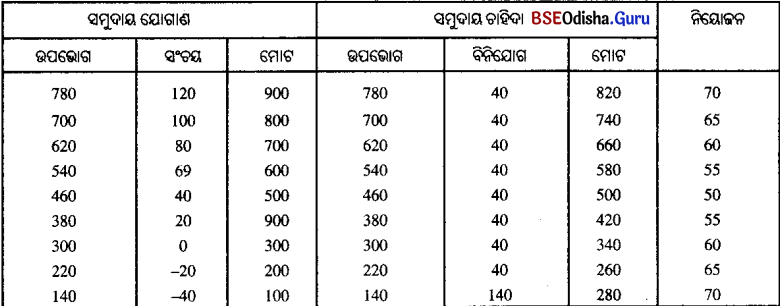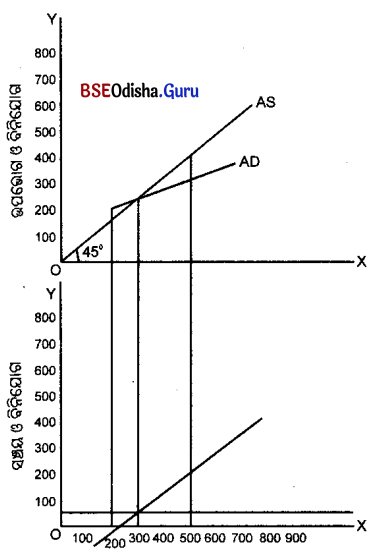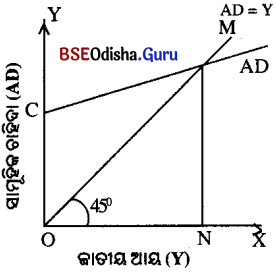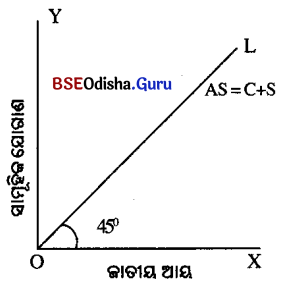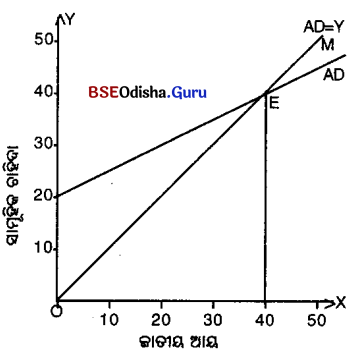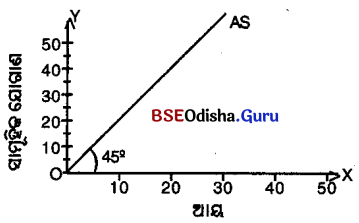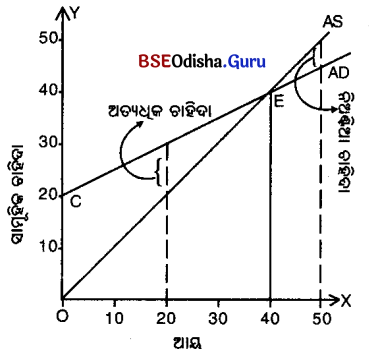Odisha State Board CHSE Odisha Class 12 Political Science Solutions Chapter 6 ଭାରତୀୟ ରାଜନୀତିରେ ସାଂପ୍ରତିକ ପ୍ରସଙ୍ଗ-ଜନପ୍ରିୟ ଆନ୍ଦୋଳନ Long Answer Questions.
CHSE Odisha 12th Class Political Science Chapter 6 Long Answer Questions in Odia Medium
ଦୀର୍ଘ ଉତ୍ତରମୂଳକ ପ୍ରଶ୍ନୋତ୍ତର
୧ | ଭାରତରେ ନାରୀ ଆନ୍ଦୋଳନ (Women Movement) ର ସ୍ବରୂପ, ଭିଭି, ବିକାଶ ଓ ସଫଳତା ଆଲୋଚନା କର । କିମ୍ବା, ଭାରତରେ ସ୍ତ୍ରୀ-ଜାତିବାଦ (Feminism) ର ବିକାଶ ସଂପର୍କରେ ତର୍ଜମା କର ।
Answer:
ସ୍ତ୍ରୀ-ଜାତିବାଦ (Feminism) ନାରୀ ଆନ୍ଦୋଳନକୁ ସାଧାରଣତଃ ଦୁଇ ଭାଗରେ ବିଭକ୍ତ କରିଥାଏ; ଯଥା –
- ନାରୀ ସମାନତା ଆନ୍ଦୋଳନ ଓ
- ନାରୀ ମୁକ୍ତି ଆନ୍ଦୋଳନ
ନାରୀ ସମାନତା ଆନ୍ଦୋଳନ ଲିଙ୍ଗଗତ ପାର୍ଥକ୍ୟ ଦୂର କରି ସାମାଜିକ ସ୍ତରୀକୃତ ବ୍ୟବସ୍ଥାରେ ନାରୀକୁ ପୁରୁଷ ସହ ସମାନ ସ୍ତର ଓ ମର୍ଯ୍ୟାଦା ଦେବାର ଲକ୍ଷ୍ୟ ରଖୁଥାଏ । କିନ୍ତୁ ଅନ୍ୟ ପକ୍ଷରେ ନାରୀ ମୁକ୍ତି ଆନ୍ଦୋଳନ ସ୍ତ୍ରୀ-ଜାତିବାଦର ଏକ ଚରମ ପ୍ରତିଫଳନ ଅଟେ ଓ ନାରୀର ନିରଙ୍କୁଶ ସ୍ଵାଧୀନତା ସପକ୍ଷରେ ଏହା ଯୁକ୍ତି ଉପସ୍ଥାପନ କରିଥାଏ । ଭାରତରେ ସ୍ତ୍ରୀ ଜାତିବାଦ ପାଶ୍ଚାତ୍ୟ ‘ଆମୂଳ ସଂସ୍କାରବାଦୀ ସ୍ତ୍ରୀ ଜାତିବାଦ’ (Radical Feminism)ରେ ବିଶ୍ଵାସ ନକରି ‘ନାରୀ ଜାଗରଣ’, ‘ନାରୀର ମର୍ଯ୍ୟାଦା ବୃଦ୍ଧି’, ‘ନାରୀ ସମାନତା’ ଆଦି ଉପାଦାନ ଉପରେ ଆଧାରିତ ସ୍ତ୍ରୀ ଜାତିଟାକୁ ସମର୍ଥନ କରିଥାଏ । ପୁରୁଷ ପ୍ରାଧାନ୍ୟ ହିନ୍ଦୁ ସମାଜରେ ନାରୀର ସ୍ଥିତିକୁ ସାମାଜିକ, ସାଂସ୍କୃତିକ, ଆଇନଗତ, ଅର୍ଥନୈତିକ ଓ ରାଜନୈତିକ କ୍ଷେତ୍ରରେ ସାବ୍ୟସ୍ତ କରିବାପାଇଁ ଏହା ଲକ୍ଷ୍ୟ ରଖୁଥାଏ ।
ଭାରତରେ ନାରୀ ଆନ୍ଦୋଳନକୁ ନିଜସ୍ଵ ସାମାଜିକ ଓ ସାଂସ୍କୃତିକ ପୃଷ୍ଠଭୂମିରେ ବ୍ୟବଚ୍ଛେଦ କରାଯିବା ଆବଶ୍ୟକ । ଭାରତୀୟ ସମାଜ ରକ୍ଷଣଶୀଳ, ସ୍ତରୀକୃତ, ବହୁବାଦୀ, ଧାର୍ମିକ ମୌଳବାଦୀ ପ୍ରକୃତିଯୁକ୍ତ ଅଟେ ଓ ଏହି ପ୍ରଚ୍ଛଦପଟ୍ଟରେ ନାରୀର ମର୍ଯ୍ୟାଦା ପୁରୁଷମାନଙ୍କ ତୁଳନାରେ ନ୍ୟୁନତର ଅଟେ | ପ୍ରାକ୍-ବୈଦିକ ସମାଜରେ ନାରୀ ପୁରୁଷ ସହ ସମାନ ମର୍ଯ୍ୟାଦା ଉପଭୋଗ କରୁଥିଲା । କିନ୍ତୁ ପରବର୍ତ୍ତୀ ସମୟରେ ସଂପରି ଆଦି କ୍ଷେତ୍ରରେ ନାରୀର ଅଧିକାରକୁ ସ୍ବୀକୃତି ଦିଆଗଲା ନାହିଁ । ବୌଦ୍ଧଧର୍ମର ପ୍ରସାର ସମୟରେ ନାରୀକୁ ଜ୍ଞାନ ଅର୍ଜନର ଅଧିକାର ଦିଆଯାଇଥିଲେ ମଧ୍ୟ ଗୁପ୍ତଯୁଗରେ ନାରୀର ମର୍ଯ୍ୟାଦା କ୍ଷେତ୍ରରେ ଦ୍ରୁତ ଅବନତି ପରିଲକ୍ଷିତ ହୋଇଥିଲା । ବିଧବା ବିବାହ ବନ୍ଦ, ଯୌତୁକପ୍ରଥାର ଗୁରୁତ୍ଵ ବୃଦ୍ଧି, ସତୀପ୍ରଥାର ପ୍ରସାର ଆଦି ନାରୀ ସମାନତା ଓ ମର୍ଯ୍ୟାଦା ବିରୋଧୀ ଥିଲା ।
ବାଲ୍ୟ ବିବାହ, ସତୀ, ଅନ୍ଧବିଶ୍ଵାସ, ରକ୍ଷଣଶୀଳତା, ପରଦାପ୍ରଥା ଆଦି ପ୍ରାଚୀନ ଓ ମଧ୍ୟଯୁଗୀୟ ଭାରତୀୟ ସମାଜରେ ନାରୀର ସ୍ଵତନ୍ତ୍ରତା ଓ ସ୍ଥିତିକୁ ସଙ୍କୁଚିତ ଓ ଅମର୍ଯ୍ୟାଦାଯୁକ୍ତ କରିଥିଲା । କିନ୍ତୁ ଉନବିଂଶ ଶତାବ୍ଦୀରେ ବିଭିନ୍ନ ସଂସ୍କାର ଆନ୍ଦୋଳନ କରାଯାଇ ଭାରତୀୟ ସମାଜରେ ନାରୀର ମର୍ଯ୍ୟାଦା ବୃଦ୍ଧି ପାଇଁ ପଦକ୍ଷେପ ନିଆଯାଇଥିଲା । ରାଜା ରାମମୋହନ ରାୟ 1828 ମସିହାରେ ସତୀ ନିରୋଧ ଆଇନକୁ ସମର୍ଥନ କରିଥିଲେ । ଈଶ୍ବର ଚନ୍ଦ୍ର ବିଦ୍ୟାସାଗର ବିଧବା ବିବାହ ସପକ୍ଷରେ ଆନ୍ଦୋଳନ କରି 1856 ମସିହାରେ ହିନ୍ଦୁ ବିଧବା ବିବାହ ଆଇନ ଗୃହୀତ କରିବାରେ ସକ୍ଷମ ହୋଇଥିଲେ । 1861 ମସିହାରେ ବମ୍ବେଠାରେ ଗୋଟିଏ ବିଧବା ବିବାହ ସଂଘ ଗଠିତ ହୋଇଥିଲା। ଆର୍ଯ୍ୟସମାଜ ନାରୀ ସ୍ଵାଧୀନତା ଓ ମର୍ଯ୍ୟାଦା ସପକ୍ଷରେ କାର୍ଯ୍ୟ କରିଥିଲା ।
1927 ମସିହାରେ ସର୍ବଭାରତୀୟ ମହିଳା ସମ୍ମିଳନୀ ପ୍ରତିଷ୍ଠିତ ହୋଇଥିଲା । 1930- 1940 ମସିହାରେ ମଧ୍ୟବିତ୍ତ ଶ୍ରେଣୀର ମହିଳାମାନେ ଚାକିରିରେ ଯୋଗଦାନ କରିବା ଆରମ୍ଭ କଲେ | ବ୍ରିଟିଶ୍ ସରକାର 1829 ମସିହାରେ ସତୀନିରୋଧ ଆଇନ, 1856 ମସିହାରେ ବିଧବା ବିବାହ ଆଇନ, 1870 ମସିହାରେ ମହିଳା ଦୁଗ୍ଧପୋଷ୍ୟ ଶିଶୁ ହତ୍ୟା ନିରୋଧ ଆଇନ, 1872 ମସିହାରେ ଆନ୍ତଃ-ସଂପ୍ରଦାୟ ବିବାହ ଆଇନ, 1929 ମସିହାରେ ଶାରଦା ଆଇନ ବା ବାଲ୍ୟ ବିବାହ ନିରୋଧ ଆଇନ, ମାଡ୍ରାସ୍ ପ୍ରଦେଶରେ 1921 ମସିହାରେ ନାରୀ ଭୋଟଦାନ ଆଇନଗତ ବ୍ୟବସ୍ଥା ଗ୍ରହଣ କରିଥିଲେ । ସ୍ଵାଧୀନତା ପରେ ଭାରତ ସରକାର ନିମ୍ନଲିଖତ ବିବିଧ ପଦକ୍ଷେପ ନେଇ ନାରୀ ସ୍ଵାଧୀନତା ପାଇଁ ଅନୁକୂଳ ପରିବେଶ ସୃଷି କରିଛଜି ।

- 1954 ମସିହାରେ ସ୍ଵତନ୍ତ୍ର ବିବାହ ଆଇନ ବଳରେ ଦେୱାନୀ ଆଦଲତରେ ବିବାହ ସମାପନ କରାଯିବା ସହ ଆନ୍ତଃ- ଜାତି ଓ ଆନ୍ତଃ-ସଂପ୍ରଦାୟ ବିବାହକୁ ଆଇନଗତ ସ୍ବୀକୃତି ଦିଆଯାଇଛି ।
- 1955 ମସିହାରେ ହିନ୍ଦୁ ବିବାହ ଆଇନ ଛାଡ଼ପତ୍ର ଓ ଜୀବନଧାରଣ ଭତ୍ତା ପାଇବା କ୍ଷେତ୍ରରେ ନାରୀକୁ ପୁରୁଷ ସହ ସମାନ ସୁଯୋଗ ପ୍ରଦାନ କରିଛି ।
- 1956 ମସିହା ହିନ୍ଦୁ ପୋଷ୍ୟ ସନ୍ତାନ ଗ୍ରହଣ ଆଇନକୁ ସୁସୁ ମସ୍ତିଷ୍କଯୁକ୍ତ ମହିଳା ନିଜର ପୁତ୍ର ଓ କନ୍ୟାରୂପେ ଜଣେ ବାଳକ ଓ ବାଳିକାକୁ ପୋଷ୍ୟସନ୍ତାନ ହିସାବରେ ଗ୍ରହଣ କରିପାରିବାର ଅଧିକାର ଦେଇଛି ।
- 1956 ମସିହାରେ ହିନ୍ଦୁ ନାବାଳକ ଓ ଅଭିଭାବକ ଆଇନ ଜଣେ ମହିଳାଙ୍କୁ ତାଙ୍କର ନାବାଳକ ସନ୍ତାନର ପ୍ରାକୃତିକ ଅଭିଭାବକ ହେବାର ଅଧୁକାର ପ୍ରଦାନ କରିଛି ।
- 1956 ମସିହାର ହିନ୍ଦୁ ଉତ୍ତରାଧ୍ୟାକାର ସଂପରି ଗ୍ରହଣ ଆଇନ ପାରିବାରିକ ସଂପରି ଉତ୍ତରାଧୁକାର କ୍ଷେତ୍ରରେ ନାରୀକୁ ସମାନ ଅଧିକାର ଦେଇଛି ।
- 1961 ମସିହାର ଯୌତୁକ ନିରୋଧ ଆଇନ ନାରୀ ମର୍ଯ୍ୟାଦା ବୃଦ୍ଧିରେ ସହାୟକ ହେଉଛି ।
- 2001 ମସିହାରେ ନାରୀ ସଶକ୍ତିକରଣ ପାଇଁ ଜାତୀୟ ଯୋଜନା ପ୍ରଣୟନ କରାଯାଇଛି ।
ଭାରତରେ ଉନବିଂଶ ଶତାବ୍ଦୀରେ ସଂସ୍କାରବାଦୀ ଆନ୍ଦୋଳନଠାରୁ 2003 ମସିହାର ତାମିଲନାଡୁରେ ଜୟଲଳିତାଙ୍କ ନାରୀର ସ୍ଥିତିକୁ ଜାହିର କରିବାର ପ୍ରୟାସ ପର୍ଯ୍ୟନ୍ତ ଅଧିକାଂଶ କ୍ଷେତ୍ରରେ ବ୍ୟାପକ ନାରୀ ଅଂଶଗ୍ରହଣ ଅନୁପସ୍ଥିତି ଦେଖିବାକୁ ମିଳିଥାଏ । ସଂସ୍କାରବାଦୀ ଆନ୍ଦୋଳନଗୁଡ଼ିକ ପୁରୁଷମାନଙ୍କ ନେତୃତ୍ଵରେ ପରିଚାଳିତ ହେଉଥିଲା । ସଚେତନଶୀଳତା, ଶିକ୍ଷା ଆଦିର ଅଭାବ ଓ ରକ୍ଷଣଶୀଳ ସମାଜର ପ୍ରଚ୍ଛଦପଟ୍ଟ ନାରୀ ନେତୃତ୍ଵ ଓ ନାରୀ ଅଂଶଗ୍ରହଣଦ୍ଵାରା ନାରୀ ଆନ୍ଦୋଳନକୁ ସଫଳ କରିବାରେ ବାଧା ସୃଷ୍ଟି କରୁଛି । ତଥାପି ସ୍ଵାଧୀନତା ଆନ୍ଦୋଳନ ସମୟରେ ଆନିବେସାନ୍ତ, ମୋହିନୀ, ଡେରାବାଈ ଟାଟା, ସରୋଜିନୀ ନାଇଡୁ ଆଦି ନାରୀ ନେତୃତ୍ଵ ମାଧ୍ୟମରେ ସମାନ ରାଜନୈତିକ ଅଧିକାରପାଇଁ ନାରୀ ଆନ୍ଦୋଳନ ମୁଣ୍ଡ ଟେକିଥିଲା ।
ସେ ସମୟରେ ନାରୀ ଆନ୍ଦୋଳନ ଜାତୀୟ ଆନ୍ଦୋଳନ ସହ ମିଶିଯାଇ ସ୍ଵାଧୀନତା ହାସଲ ଲକ୍ଷ୍ୟରେ କାର୍ଯ୍ୟ କରୁଥିଲା । ଏହା ଭାରତରେ ନାରୀ ନେତୃତ୍ଵ ସୃଷ୍ଟିର ପ୍ରାଥମିକ ପର୍ଯ୍ୟାୟ ଥିଲା । କିନ୍ତୁ ସ୍ଵାଧୀନତା ହାସଲ ପରେ ରାଷ୍ଟ୍ର ଓ ଜାତି ଗଠନର ସମସ୍ୟା ଭିତରେ ନାରୀ ଆନ୍ଦୋଳନର ସଫଳ ବିନ୍ୟାସ ଭାରତ ମାଟିରେ ସମ୍ଭବ ହୋଇପାରି ନଥିଲା । ତଥାପି ମହିଳାମାନଙ୍କର ସାମାଜିକ ଉନ୍ନତି ପାଇଁ ଉପରୋକ୍ତ ବିଭିନ୍ନ ଆଇନ ପ୍ରଣୟନ କରାଯାଇଥିଲା ।
1970 ମସିହାର ଆଦ୍ୟଭାଗରେ ସମସ୍ୟା ଜର୍ଜରିତ ବିହାରରେ ଜୟପ୍ରକାଶ ନାରାୟଣଙ୍କ ଛାତ୍ର ଯୁବ ସଂଘର୍ଷ ବାହିନୀ (CYSV) ମାଧ୍ୟମରେ ‘ସଂପୂର୍ଣ୍ଣ କ୍ରାନ୍ତି’ (Total Revolution) କାର୍ଯ୍ୟକ୍ରମର ରୂପାୟନ କରାଯାଇଥିଲା ଯାହା ବିଧ୍ଵବଦ୍ଧଭାବେ ମହିଳାମାନଙ୍କର ପ୍ରତ୍ୟକ୍ଷ ଅଂଶଗ୍ରହଣ ଉପରେ ଗୁରୁତ୍ଵ ଦେଇ ପରିବାରରେ ଶ୍ରମ ବିଭାଜନ, ମହିଳାମାନଙ୍କ ପ୍ରତି ହିଂସା ଆଚରଣ, ସମ୍ବଳର ଉପଯୋଗ କ୍ଷେତ୍ରରେ ମହିଳାମାନଙ୍କ ପାଇଁ ଅସାମ୍ୟ ନୀତି, ପୁରୁଷ-ମହିଳା ସଂପର୍କ ଆଦି ବିବିଧ ନାରୀ- ସଂପର୍କିତ ବିଷୟରେ ତର୍କ ଓ ସଚେତନଶୀଳତା ସୃଷ୍ଟି କଲା । ‘ବୋଧଗୟା ମଠ ଆନ୍ଦୋଳନ’ରେ ଗ୍ରାମ୍ୟ ମହିଳାମାନଙ୍କର ଯୋଗଦାନ ଭବିଷ୍ୟତ ଆନ୍ଦୋଳନ ପାଇଁ ଏକ ଅନୁକରଣୀୟ ଛାଞ୍ଚ ତିଆରି କଲା ।
1975 ମସିହା ବେଳକୁ ସହରାଞ୍ଚଳର ଅନେକ ଶିକ୍ଷିତ ଛାତ୍ରୀ ଓ ମହିଳା ରାଜନୈତିକ ଅସ୍ଥିରତା ଓ ଜରୁରୀ ପରିସ୍ଥିତିର ବିରୋଧରେ ସଂଗଠିତ ଆନ୍ଦୋଳନ କଲେ ।ମହିଳାମାନଙ୍କର ପ୍ରତ୍ୟକ୍ଷ ଅଂଶଗ୍ରହଣ ଉପରେ ଗୁରୁତ୍ଵ ଦେଇ ପରିବାରରେ ଶ୍ରମ ବିଭାଜନ, ମହିଳାମାନଙ୍କ ପ୍ରତି ହିଂସା ଆଚରଣ, ସମ୍ବଳର ଉପଯୋଗ କ୍ଷେତ୍ରରେ ମହିଳାମାନଙ୍କ ପାଇଁ ଅସାମ୍ୟ ନୀତି, ପୁରୁଷ-ମହିଳା ସଂପର୍କ ଆଦି ବିବିଧ ନାରୀ- ସଂପର୍କିତ ବିଷୟରେ ତର୍କ ଓ ସଚେତନଶୀଳତା ସୃଷ୍ଟି କଲା । ‘ବୋଧଗୟା ମଠ ଆନ୍ଦୋଳନ’ରେ ଗ୍ରାମ୍ୟ ମହିଳାମାନଙ୍କର ଯୋଗଦାନ ଭବିଷ୍ୟତ ଆନ୍ଦୋଳନ ପାଇଁ ଏକ ଅନୁକରଣୀୟ ଛାଞ୍ଚ ତିଆରି କଲା । 1975 ମସିହା ବେଳକୁ ସହରାଞ୍ଚଳର ଅନେକ ଶିକ୍ଷିତ ଛାତ୍ରୀ ଓ ମହିଳା ରାଜନୈତିକ ଅସ୍ଥିରତା ଓ ଜରୁରୀ ପରିସ୍ଥିତିର ବିରୋଧରେ ସଂଗଠିତ ଆନ୍ଦୋଳନ କଲେ ।
ଗରଓ୍ବାଲ ଅଞ୍ଚଳରେ ସଂଘଟିତ ‘ଟିପ୍ ଆନ୍ଦୋଳନ’ ପରିବେଶ ଅବକ୍ଷୟ କ୍ଷେତ୍ରରେ ଏକ ଉଲ୍ଲେଖନୀୟ ମାଇଲଖୁଣ୍ଟ । ଜଙ୍ଗଲ ସଂରକ୍ଷଣ ପାଇଁ ନାରୀମାନଙ୍କର ଭୂମିକାକୁ ଏହା ପ୍ରତିପାଦିତ କରିବା ସଙ୍ଗେ ସଙ୍ଗେ ସ୍ନେହୀ ପ୍ରକୃତିଧାରୀ ନାରୀକୁ ‘ପ୍ରକୃତି-ସ୍ନେହୀ’ ର ସ୍ଵରୂପ ମଧ୍ୟ ପ୍ରଦାନ କଲା । ଏହି ସମୟରେ ‘ସ୍ଵୟଂ-ନିଯୁକ୍ତି ନାରୀ ସଂଘ’ (Self-Employed Women’s Association – SEWA)ର ସ୍ଥାପନା ପ୍ରାଥମିକ ସ୍ତରରେ ଅହମ୍ମଦାବାଦର ବୟନଶିଳ୍ପ କ୍ଷେତ୍ରରେ ଘଟି ସମବାୟିକ ବ୍ୟବସ୍ଥା ମାଧ୍ୟମରେ ଗ୍ରାମ୍ୟ ମହିଳାମାନଙ୍କର ସାମାଜିକ ଓ ଆର୍ଥିକ ଅଭିବୃଦ୍ଧିର କାର୍ଯ୍ୟକ୍ରମକୁ ତ୍ଵରାନ୍ଵିତ କରାଗଲା । କାରଣ ମହିଳାମାନେ ଆର୍ଥିକ ସ୍ଵାବଲମ୍ବନଶୀଳ ନହେଲେ ସମାନତା ଓ ମର୍ଯ୍ୟାଦାର ପରିସର ବୃଦ୍ଧି ଦାବିର କିଛିଭୂମି ଦୁର୍ବଳ ହୋଇଥାଏ ।
ମହିଳା ସଶକ୍ତିକରଣ ଦିଗରେ ଅସଙ୍ଗଠିତ କ୍ଷେତ୍ରରେ କାର୍ଯ୍ୟ କରୁଥିବା ମହିଳାମାନଙ୍କୁ ସଂଗଠିତ କରିବାର ଲକ୍ଷ୍ୟନେଇ ସୃଷ୍ଟ ଏହି ଆନ୍ଦୋଳନର ପ୍ରଭାବ ଅତ୍ୟନ୍ତ ଗଭୀର ଥିଲା । 1977 ମସିହାରେ ଛତିଶଗଡ଼ ଖଣି ଶ୍ରମିକ ସଂଘ (Chhatisgarh Mines Shramik Sangh – CMSS) ନାମରେ ଏକ ବିପ୍ଳବୀ ଶ୍ରମିକ ସଂଗଠନ ସ୍ଥାପିତ ହୋଇ ‘ ମହିଳାମାନଙ୍କର ସମାନ କାମପାଇଁ ସମାନ ମଜୁରି’ ଅଧିକାରକୁ ସ୍ବୀକୃତି ଦେଇଥିଲା । ଏହାପରଠାରୁ ପ୍ରତ୍ୟେକ ସଙ୍ଗଠନରେ ଏକ ‘ ସ୍ଵତନ୍ତ୍ର ମହିଳା କକ୍ଷ’ ସୃଷ୍ଟି ହେଲା ଯାହା ମୁଖ୍ୟ ସଂଗଠନ ସହ ତାଳଦେଇ ମହିଳା-ସ୍ଵାର୍ଥ ହାସଲପାଇଁ କାର୍ଯ୍ୟକ୍ରମ ଗ୍ରହଣ କରିଆସୁଛି । ମହାରାଷ୍ଟ୍ରରେ ‘ସମଗ୍ର ମହିଳା ଅଗଦି’ (SMA) ନାମକ ଏକ ସଂଗଠନ 1990 ମସିହାରେ ସ୍ଥାପିତ ହୋଇ ସଂପୃକ୍ତ ରାଜ୍ୟ ରାଜନୀତିରେ ମହିଳାମାନଙ୍କର ଅଂଶଗ୍ରହଣ ଓ ଭୂମିକାର ଗୁରୁତ୍ଵ ପ୍ରତିପାଦନ କରିଛି ।
‘ବମ୍ବେ ଫୋରମ୍’ ନାମରେ ଏକ ସଂଗଠନ 1981 ମସିହାରେ ସ୍ଥାପିତ ହୋଇ ମହିଳାମାନଙ୍କର ଧର୍ଷଣ, ବାଳିକା ଭ୍ରୂଣର ହତ୍ୟା ଆଦି ମାଧ୍ୟମରେ ହେଉଥିବା ବିଭିନ୍ନ ଅତ୍ୟାଚାର ବିରୋଧରେ ଜନଆନ୍ଦୋଳନ ଗଢ଼ି ଜନସଚେତନଶୀଳତା ସୃଷ୍ଟି କରିଥିଲା । ‘ମାନୁଷୀ’ ନାମକ ଏକ ଇଂରାଜୀ ପତ୍ରିକା ଦିଲ୍ଲୀଠାରୁ 1979 ମସିହାଠାରୁ ପ୍ରକାଶିତ ହୋଇ ମହିଳା ସମ୍ବଳ, ଆଇନଗତ ପରାମର୍ଶ, ବିଭିନ୍ନ ମହିଳା ସମସ୍ୟା ଆଦି ସଂପର୍କରେ ତଥ୍ୟଗତ ସମ୍ବାଦ ପ୍ରଦାନ କରିଆସୁଛି । ଏହାଛଡ଼ା ‘ ବଙ୍ଗଳା ଭାଷାରେ ‘ ଅହଲ୍ୟା’, ଇଂରାଜୀ ଭାଷାରେ, ‘ନାରୀସ୍ଵର’ (Women’s Voice), ହିନ୍ଦୀ ଭାଷାରେ ‘ସ୍ତ୍ରୀ ସଂଘର୍ଷ’ ଆଦି ପତ୍ରିକା ପ୍ରକାଶିତ ହୋଇ ନାରୀ ଆନ୍ଦୋଳନକୁ ଏକ ନୂତନ ଦିଗ୍ଦର୍ଶନ ପ୍ରଦାନ କରୁଛି ।
1980 ମସିହାର ମଧ୍ୟଭାଗରେ ରୂପ କନ୍ର ନାମକ ଏକ 17 ବର୍ଷିୟା ରାଜପୁତ୍ ମହିଳା ‘ସତୀ ବ୍ୟବସ୍ଥା’ର କ୍ରୂର ଶିକାର ହେବା ଜନିତ ପରିସ୍ଥିତିରେ ସଂଗଠିତ ମହିଳା ଆନ୍ଦୋଳନ ନାରୀ ସମାନତା, ମର୍ଯ୍ୟାଦା ପାଇଁ ଜନମତ ଜାଗରିତ କରିଥିଲା । ବିଭିନ୍ନ ସ୍ଵୟଂଶାସିତ ସଂଗଠନ ସାଧାରଣ ଦେୱାନୀ ଆଇନ (Uniform Civil Code) ପ୍ରଚଳନ ପାଇଁ ଦାବି କରିବା ମାଧ୍ୟମରେ ନାରୀ ଆନ୍ଦୋଳନକୁ ପ୍ରୋତ୍ସାହନ ଦେଇଆସୁଛନ୍ତି । ବିଭିନ୍ନ ଧାର୍ମିକ ବ୍ୟକ୍ତିଗତ ଆଇନ ନାରୀ ମର୍ଯ୍ୟାଦାର ଅବନତି ପାଇଁ ଦାୟୀ ହୋଇଥିବାରୁ ଏହା ବିରୋଧରେ ଜନସଚେତନଶୀଳତା ସୃଷ୍ଟି କରାଯାଉଛି । ଶାହାବାନୁ ମକଦ୍ଦମାରେ ସମ୍ବାଦ ସଂସ୍ଥାର ବ୍ୟାପକ ସମର୍ଥନ ସତ୍ତ୍ଵେ ମହିଳାମାନଙ୍କର ମର୍ଯ୍ୟାଦା ରକ୍ଷା ପରିପ୍ରେକ୍ଷୀରେ ବ୍ୟକ୍ତିଗତ ଆଇନକୁ ନୂତନ ଦିଗନ୍ତ ପ୍ରଦାନ କରାଯାଇ ପାରିନଥିଲା ।
ହାଇଦ୍ରାବାଦରେ ପ୍ରଗତିଶୀଳ ମହିଳା ସଂଗଠନ (Progressive Women’s Organisation – PWO) ଓସ୍ମାନିଆ ବିଶ୍ଵବିଦ୍ୟାଳୟ ପରିସରରେ 1970 ମସିହାର ଆଦ୍ୟ ଭାଗରେ ସ୍ଥାପିତ ହୋଇ ଖଟିଖୂଆ ସଂଖ୍ୟାତ୍ମକ ଶ୍ରମିକ ଆନ୍ଦୋଳନର ଦୃଢ଼ଭିଭି ଉପରେ ନାରୀ ମୁକ୍ତି ଆନ୍ଦୋଳନକୁ ପ୍ରତିଷ୍ଠିତ କରିବା ଉପରେ ଗୁରୁତ୍ବ ଆରୋପ କରିଥିଲା । ଦରଦାମ୍ ବୃଦ୍ଧି,ଯୌତୁକପ୍ରଥା, ଯୌନ ବ୍ୟଭିଚାର, ପ୍ରଚାରରେ ନାରୀର ବ୍ୟାପକ କୁ-ଉପଯୋଗ ଆଦି ନାରୀ ସ୍ଵାର୍ଥବିରୋଧୀ ବିଭିନ୍ନ ବିଷୟ ସଂପର୍କରେ, ଜନମତ ସଂଗଠିତ କରିବା ଏହାର ମୁଖ୍ୟ ଲକ୍ଷ୍ୟ ଥିଲା । ‘ସ୍ତ୍ରୀ ଶକ୍ତି ସଂଗଠନ’ (SSS) ଓ ‘ଅନ୍ଵେଷୀ’ ନାମକ ସଂଗଠନ ମାଧ୍ୟମରେ ଉଭୟ ଜାତୀୟ ଓ ଆନ୍ତର୍ଜାତୀୟ ବ୍ୟବସ୍ଥା ଉପରେ ଚାପ ପକାଇ ମହିଳା ସ୍ଵାର୍ଥ ସଂପର୍କିତ ବିଷୟକୁ ସ୍ବୀକୃତି ଦିଆଯିବା କ୍ଷେତ୍ରରେ ଅନୁକୂଳ ପରିବେଶ ସୃଷ୍ଟି କରାଯାଇଛି ।

ବିଭିନ୍ନ ରାଜନୈତିକ ଦଳ ନିଜସ୍ଵ ମହିଳା ସଂଗଠନ ମାଧ୍ୟମରେ ‘ମହିଳା ଭୋଟ’ ସଂଚାଳନର ବ୍ୟବସ୍ଥା କରିଛନ୍ତି ସରକାରଙ୍କ ମହିଳା ନୀତିକୁ ସମର୍ଥନ, ପ୍ରତିଫଳନ, ପ୍ରଭାବିତ ଓ ସମାଲୋଚନା କରିବା କ୍ଷେତ୍ରରେ ଏହି ସଂଗଠନଗୁଡ଼ିକ ଗୁରୁତ୍ଵପୂର୍ଣ୍ଣ ଭୂମିକା ଗ୍ରହଣ କରୁଛନ୍ତି । ମହିଳା-ବିରୋଧୀ ବିଭିନ୍ନ କୁ-ସାମାଜିକ ବ୍ୟବସ୍ଥା ବିରୋଧରେ ବିଭିନ୍ନ ସମୟରେ ଆନ୍ଦୋଳନମାନ ସଂଗଠିତ କରିବା କ୍ଷେତ୍ରରେ ଏହାର ଭୂମିକା ସ୍ଵୀକାର୍ଯ୍ୟ | ସାଂପ୍ରଦାୟିକ ଦଙ୍ଗା ସମୟରେ ଉଦାହରଣସ୍ୱରୂପ ଦିଲ୍ଲୀରେ 1984 ମସିହାରେ ସଂଗଠିତ ଦଙ୍ଗା ସମୟରେ ସାଂପ୍ରଦାୟିକ ହିଂସା ବିରୋଧରେ ଆନ୍ଦୋଳନ ପାଇଁ ମହିଳା ଆନ୍ଦୋଳନ ସଫଳତାର ସହ କାର୍ଯ୍ୟ କରିଛି । କେନ୍ଦ୍ର ଓ ରାଜ୍ୟ ସ୍ତରରେ ପ୍ରତିଷ୍ଠତ ‘ ମହିଳା କମିଶନ’ ଏହି ଆନ୍ଦୋଳନଗୁଡ଼ିକୁ ପ୍ରୋତ୍ସାହନ ଦେଇ ଅଧିକ ସମନ୍ବିତ କରୁଛି । 1975-1985 ମସିହାରେ ଜାତିସଂଘଦ୍ଵାରା ମହିଳା ଦଶନ୍ଧିରୂପେ ଘୋଷିତ ହୋଇ ପ୍ରଚୁର ଅର୍ଥ ଆଗମନ ଫଳରେ ବିଭିନ୍ନ ବେସରକାରୀ ସଂଗଠନଦ୍ଵାରା ଲିଙ୍ଗଗତ ପାର୍ଥକ୍ୟ ଦୂରୀକରଣ, ରାଜନୈତିକ ସଶକ୍ତିକରଣ ଆଦି କାର୍ଯ୍ୟକ୍ରମ ଗ୍ରହଣ କରାଯାଇ ରୂପାୟନ କରାଯାଇଛି ।
ଭାରତରେ ନାରୀ ଆନ୍ଦୋଳନ ସମ୍ମୁଖରେ ମୁଖ୍ୟ ବିଷୟ ଓ କାର୍ଯ୍ୟକ୍ଷେତ୍ର :
ଜାତିସଂଘ ମହିଳା ଦଶନ୍ଧି ଓ ଆନ୍ତର୍ଜାତିକ ମହିଳା ବର୍ଷ ସମୟରେ ଭାରତରେ ସର୍ବପ୍ରଥମ ଥରପାଇଁ ଭାରତୀୟ ମହିଳାମାନଙ୍କର ସମସ୍ୟା ସଂପର୍କରେ ସାମାଜିକ ସଂଗଠନ, ବେସରକାରୀ ସଂଗଠନ ଆଦି ବ୍ୟାପକ ଆଲୋଚନା କଲେ ଏବଂ ନିମ୍ନଲିଖତ ବିଭିନ୍ନ ବିଷୟ କ୍ଷେତ୍ରରେ ଏହି ଆନ୍ଦୋଳନ ସଂଗଠିତ ହେବା ଉଚିତ ବୋଲି ସ୍ପଷ୍ଟଭାବେ ସୂଚିତ ହେଲା :
- ଜନସଂଖ୍ୟାରେ ନାରୀ ଅନୁପାତ ହ୍ରାସ ଯୋଗୁଁ ନାରୀ-ଭ୍ରୂଣ ହତ୍ୟା ନିରୋଧ ପାଇଁ ଆଇନଗତ ବ୍ୟବସ୍ଥା ସହ ସାମାଜିକ ସଚେତନଶୀଳତା ସୃଷ୍ଟି ପାଇଁ ବିଭିନ୍ନ କାର୍ଯ୍ୟକ୍ରମ ଗ୍ରହଣ କରାଯିବା ଆବଶ୍ୟକ ।
- ଧାର୍ମିକ ମୌଳବାଦ ନାରୀ ସ୍ଵାଧୀନତା ଓ ମର୍ଯ୍ୟାଦା ବୃଦ୍ଧି କ୍ଷେତ୍ରରେ ପ୍ରତିବନ୍ଧକ ସୃଷ୍ଟି କରୁଥିବାରୁ ଏହି ବ୍ୟବସ୍ଥାର ସଂସ୍କାର ପାଇଁ ଜନସଚେତନଶୀଳତା ସୃଷ୍ଟି କ୍ଷେତ୍ରରେ କାର୍ଯ୍ୟହେବା ଉଚିତ । ବାସ୍ତବରେ ହିନ୍ଦୁ ଧର୍ମର ପ୍ରକୃତ ବ୍ୟାଖ୍ୟା କଲେ ଏହା ସ୍ପଷ୍ଟ ହୁଏ ଯେ, ‘ଶିବ’ ଓ ‘ଶକ୍ତି’ ପ୍ରକୃତିର ଆଧାର ଅଟନ୍ତି ଏବଂ ଏହି ଦୃଷ୍ଟିରୁ ସମାଜରେ ପୁରୁଷ ଓ ସ୍ତ୍ରୀ ସମାନତାର ସୂତ୍ରରେ ଆବଦ୍ଧ ହେବା ଉଚିତ ।
- ନାରୀ ଶିକ୍ଷାର ବିକାଶ, ନାରୀ ପାଇଁ ସୁଷମ ଖାଦ୍ୟ ଓ ଉତ୍ତମ ସ୍ଵାସ୍ଥ୍ୟରକ୍ଷାର କାର୍ଯ୍ୟକ୍ରମ ଗ୍ରହଣ କରାଯିବା ଆବଶ୍ୟକ ।
- ମହିଳାମାନଙ୍କ ବିରୋଧରେ ହିଂସା ଓ ଅପରାଧର ମାତ୍ରା କ୍ରମାଗତ ଓ ବିପଦଜନକଭାବେ ବୃଦ୍ଧି ପାଉଥିବାରୁ ଏହା ନିୟନ୍ତ୍ରିତ ହେବା ଉଚିତ ।
- ଅଜ୍ଞତା ଓ ସାମାଜିକ ପ୍ରଥା ହେତୁ ମହିଳାମାନେ ସମାଜରେ ସଂପରିବିହୀନ ପ୍ରାଣୀରୂପେ ବର୍ଦ୍ଧିତ ହେଉଛନ୍ତି । ଏହି ଦୁର୍ବଳ ଆର୍ଥିକ ସ୍ଥିତି ବିରୋଧରେ ମହିଳା ଆନ୍ଦୋଳନ ସଂଘଟିତ ହେବା ଉଚିତ ।
- ନାରୀଦ୍ଵାରା ସଂପାଦିତ ଗୃହକାର୍ଯ୍ୟର ଆର୍ଥିକ ମୂଲ୍ୟ ପ୍ରତିପାଦିତ ହେବା ଆବଶ୍ୟକ । ବେଜିଂରେ 1995 ମସିହାରେ ଭାରତ ସରକାର ସ୍ଵୀକାର କରିଛନ୍ତି ଯେ, ଶତକଡ଼ା 35 ଭାଗ ଗ୍ରାମ୍ୟ ଶିଳ୍ପ ମହିଳାମାନଙ୍କଦ୍ଵାରା ପରିଚାଳିତ ହେଉଥିଲେ ମଧ୍ୟ ସେମାନଙ୍କର ଆର୍ଥିକ ସ୍ଵାବଲମ୍ବନଶୀଳତା ଆଜିପର୍ଯ୍ୟନ୍ତ ହାସଲ ହୋଇପାରିନାହିଁ, କିମ୍ବା ଆର୍ଥିକ ବ୍ୟବସ୍ଥାକୁ ସେମାନଙ୍କର ଦାନ ସ୍ଵୀକୃତ ନୁହେଁ |
- 1992 ମସିହାର 73 ତମ ସମ୍ବିଧାନ ସଂଶୋଧନ ଆଇନଦ୍ଵାରା ସ୍ଵାୟତ୍ତଶାସନ ସଂସ୍ଥାରେ ମହିଳାମାନଙ୍କ ପାଇଁ ସ୍ଥାନ ସଂରକ୍ଷଣ ହେବା ଫଳରେ ମହିଳାମାନଙ୍କର ରାଜନୈତିକ ଅଂଶଗ୍ରହଣର ମାତ୍ରା ବୃଦ୍ଧି ପାଉଛି ସତ; କିନ୍ତୁ ପୁରୁଷ ପ୍ରାଧାନ୍ୟ ସମାଜରେ ଏହାର ସଫଳ ପ୍ରୟୋଗ ସମ୍ଭବ ହେଉନାହିଁ ବୋଲି ଅଭିଯୋଗ ହେଉଛି । ଏଣୁ ମହିଳା ସଶକ୍ତିକରଣ ପ୍ରକ୍ରିୟାକୁ ଅଧିକ ବାସ୍ତବମୁଖୀ କରାଯିବା ଆବଶ୍ୟକ ।
1980–1990 ମସିହାରେ ସଂଘଟିତ ବିଭିନ୍ନ ନାରୀ ଆନ୍ଦୋଳନ ନାରୀର ସାମାଜିକ ଓ ଆର୍ଥିକ ନିରାପତ୍ତା ଉପରେ ଗୁରୁତ୍ଵ ଦେଉଥିଲା । ଏହା ସତୀ, ଧର୍ଷଣ, ଯୌତୁକ ନିର୍ଯାତନା, ବଧୂହତ୍ୟା, ନାରୀ-ଭୃଣ ହତ୍ୟା, ସଂପରିଗତ ଅଧିକାରପ୍ରାପ୍ତି, ନିଯୁକ୍ତି କ୍ଷେତ୍ରରେ ସମାନତା ଆଦି ବିବିଧ ବିଷୟ ଉପରେ ଆଧାରିତ ଥିଲା । ସରକାର ବିଭିନ୍ନ ଆଇନ ପ୍ରଣୟନ ଏବଂ ଜାତୀୟ ମହିଳା ଆୟୋଗ ଓ ରାଜ୍ୟ ମହିଳା ଆୟୋଗ ସ୍ଥାପନଦ୍ଵାରା ବିଭିନ୍ନ ମହିଳା-ସ୍ଵାର୍ଥ ବ୍ୟବସ୍ଥାକୁ ସ୍ବୀକୃତି ପ୍ରଦାନ କରି କାର୍ଯ୍ୟକାରୀ କରୁଛନ୍ତି । କେନ୍ଦ୍ରର ଏନ୍.ଡି.ଏ. ସରକାର ବାରମ୍ବାର ମହିଳା ।
ବିଧେୟକକୁ ସଂସଦରେ ଗୃହୀତ କରିବାର ପ୍ରୟାସ କରି ବିଫଳ ହେଉଛନ୍ତି । ବର୍ତ୍ତମାନ ଭାରତରେ ନାରୀ ଆନ୍ଦୋଳନଗୁଡ଼ିକ ସଂଗଠନ ଓ କାର୍ଯ୍ୟକ୍ରମ ଦୃଷ୍ଟିରୁ ପୂର୍ବାପେକ୍ଷା ଅଧ୍ବକ ସୁସଂଯତ ଓ ସୁବ୍ୟବସ୍ଥିତ । ଏହା ଭୂମିକା ସମ୍ମିଶ୍ରଣ (Role Integration) ର ବ୍ୟାପକ କାର୍ଯ୍ୟକ୍ରମ ଗ୍ରହଣ କରିଛି | ନାରୀମାନଙ୍କର ସାମାଜିକ ଓ ଅର୍ଥନୈତିକ ସଶକ୍ତିକରଣ ପାଇଁ 2001 ମସିହାର ଜାତୀୟ ଯୋଜନାର ଲକ୍ଷ୍ୟ ପୋଷଣ କରାଯାଇଛି । ଉଭୟ ଆଇନଗତ ଓ ବାସ୍ତବ ସ୍ଵାଧୀନତା ଉପଭୋଗ ମାଧ୍ୟମରେ ସମସ୍ତ ଅସମାନତାର ବିଲୋପ ଓ ମର୍ଯ୍ୟାଦା ପ୍ରତିଷ୍ଠା ସମ୍ଭବ ହୋଇପାରିବ ।
୨। ଉନବିଂଶ ଶତାବ୍ଦୀ ଓ ବିଂଶ ଶତାବ୍ଦୀର ଆରମ୍ଭରେ ନାରୀମାନଙ୍କ ପାଇଁ ସଂସ୍କାର ସମ୍ବନ୍ଧରେ ଆଲୋଚନା କର ।
Answer:
ଉନବିଂଶ ଶତାବ୍ଦୀକୁ ‘ନାରୀମାନଙ୍କ ପାଇଁ ଏକ ଯୁଗ’’ ରୂପେ କୁହାଯାଇପାରେ । ସେମାନଙ୍କ ପ୍ରତି କରାଯାଇଥିବା ଉଚିତ ଓ ଅନୁଚିତ ତଥା ସେମାନଙ୍କର କ୍ଷମତା ଓ ସାମର୍ଥ୍ୟ ଇଉରୋପ ଓ ଏପରିକି ଉପନିବେଶଗୁଡ଼ିକରେ ଉତ୍ତପ୍ତ ଆଲୋଚନାର ବିଷୟ ହେବାକୁ ଲାଗିଥିଲା । ଶତାବ୍ଦୀର ଶେଷ ବେଳକୁ ଇଂଲଣ୍ଡ, ଫ୍ରାନ୍ସ, ଜର୍ମାନୀ ଓ ଏପରିକି ରୁଷିଆରେ ବୈପ୍ଳବିକ ସମ୍ପର୍କରେ ସାମାଜିକ ସଂସ୍କାରକମାନେ ଦଃଖ ପ୍ରକାଶ କରିବାକୁ ଲାଗିଲେ । ନାରୀ ନିମିତ୍ତ ନାରୀମାନଙ୍କଦ୍ୱାରା ଉକ୍ତ ଆନ୍ଦୋଳନ ବଙ୍ଗ ଓ ମହାରାଷ୍ଟ୍ରରେ ଉତ୍ପତ୍ତିଲାଭ କରିଥିଲା ।
ସତୀପ୍ରଥା ବିରୋଧରେ ଅଭିଯାନ:
ପାଶ୍ଚାତ୍ୟକରଣରୁ ଜନ୍ମଲାଭ କରିଥିବା ଭାରତୀୟ ମଧ୍ୟବିତ୍ତ ଶ୍ରେଣୀୟ (ବୁର୍ଜୁଆ) ଗୋଷ୍ଠୀ ସମାଜକୁ ସୁଧାରିବାକୁ (ଉନ୍ନତି ପଥରେ ନେବାକୁ) ଜାତି, ଏକେଶ୍ବରବାଦ, ମୂର୍ତ୍ତିପୂଜା, ଚୈତନ୍ୟବାଦ, ପରଦାପ୍ରଥା, ବାଲ୍ୟବିବାହ, ସତୀ ଏବଂ ଏହିପରି ଅନ୍ୟାନ୍ୟ କୁସଂସ୍କାର ବିରୋଧରେ ଅଭିଯାନ ଆରମ୍ଭ କରି ସମାଜକୁ ଉନ୍ନତି ପଥରେ ସୁଧାରିବାକୁ ଚେଷ୍ଟା କଲେ । ସେମାନଙ୍କ ପାଇଁ ଏହି ଉପାଦାନ ପ୍ରାକ୍-ଆଧୁନିକ ବା ଆଦିମ ସମାଜର ବିଦେଶୀ ଖ୍ରୀଷ୍ଟଧର୍ମ ପ୍ରଚାରକମାନେ ବିଭିନ୍ନ କୁସଂସ୍କାରକୁ ‘‘ହିନ୍ଦୁ ବର୍ବରବାଦ’’ର ଉଦାହରଣ ରୂପେ ଆରୋପିତ କରି ଯୋଗାଇ ଦେଇଥିଲେ ।
ତେଣୁ ସେମାନେ ଉପନିବେଶ ଶକ୍ତିମାନଙ୍କ ପାଇଁ ଶାସନ କରିବାକୁ ଯଥେଷ୍ଟ କାରଣ ସୃଷ୍ଟି କଲେ । ଏହି କାରଣ ଯୋଗୁଁ ରାମମୋହନ ରାୟ ଓ ବିଦ୍ୟାସାଗର ଆବଶ୍ୟକୀୟ ପ୍ରଶାସନିକ ତଥା ଆଇନଗତ ସମର୍ଥନ ପାଇବାକୁ ପ୍ରୟାସ କଲେ । ୧୮୧୭ରେ ପଣ୍ଡିତ ମୃତ୍ୟୁଞ୍ଜୟ ବିଦ୍ୟାଳଙ୍କାର ଘୋଷଣା କଲେ ଯେ, ସତୀପ୍ରଥାର କୌଣସି ‘ଶାସ୍ତ୍ରୀୟ ଅନୁମୋଦନ’ ନାହିଁ । ଏହାର ଏକ ବର୍ଷ ପରେ ଗଭର୍ଣ୍ଣର ବେଣ୍ଟିକ୍ ତାଙ୍କ ପ୍ରଦେଶ ବଙ୍ଗଳାରେ ସତୀପ୍ରଥା ନିଷେଧ କଲେ । ଏହା ସତୀ ଉଚ୍ଛେଦ ଆଇନ ୧୯୨୯ ରୂପେ ଭାରତରେ ଅନ୍ୟ ଅଂଶକୁ ପ୍ରସାରିତ ହେବାପାଇଁ ୧୧ ବର୍ଷ ସମୟ ଲାଗିଥିଲା ।

ବିଧବା ପୁନବିବାହ:
ପଣ୍ଡିତ ମୃତ୍ୟୁଞ୍ଜୟ ବିଦ୍ୟାଳଙ୍କାରଙ୍କ ପରି ପଣ୍ଡିତ ଈଶ୍ଵରଚନ୍ଦ୍ର ବିଦ୍ୟାସାଗର ୧୮୫୦ ଦଶକରେ ଶାସ୍ତ୍ରଗୁଡ଼ିକୁ ଅଧ୍ୟୟନ କରି ପ୍ରମାଣ କଲେ ଯେ, ବିଧବାମାନଙ୍କର ପୁନଃ ବିବାହ ଗ୍ରହଣଯୋଗ୍ୟ । ତାଙ୍କର ଏହି ମତ ଥିଲା ଏକ ଦୀର୍ଘ କଷ୍ଟକର ଯାତ୍ରା, ଧର୍ମାନ୍ଧ, ପଣ୍ଡିତମାନଙ୍କ ସହିତ ବିତର୍କ ମାଧ୍ୟମରେ ଏବଂ ତତ୍କାଳୀନ ହିନ୍ଦୁ ସମାଜର କେତେକ ସ୍ତମ୍ଭରୂପେ ବିଦ୍ୟମାନ ହୋଇଥିବା ବ୍ୟକ୍ତିମାନଙ୍କଠାରୁ ବିଦୂପ । ଦେଶୀୟ ଭାଷା (ବଙ୍ଗଳା) ସମ୍ବାଦପତ୍ର ଏହାକୁ ଉଭୟ ସପକ୍ଷ କରି ଅନେକ କବିତା ଓ ବ୍ୟଙ୍ଗାତ୍ମକ ରଚନାରେ ପୂର୍ଣ କଲେ । ଉକ୍ତ ପଦଂଶ ରଚନାଗୁଡ଼ିକ ବୁଣା ହେଉଥିବା ଲୁଗାର ଅଙ୍କନଗୁଡ଼ିକରେ ଦେଖାଦେଲା । ସେଗୁଡ଼ିକ ସମାଜରେ ଆଲୋଡ଼ନ ସୃଷ୍ଟି କଲା ।
୧୮୫୫ରେ ତତ୍କାଳୀନ ଗଭର୍ଣ୍ଣରଙ୍କ ନିକଟରେ ବିଦ୍ୟାସାଗର ଏକ ଆବେଦନପତ୍ର ଉପସ୍ଥାପନ କଲେ ।୧୮୭୧ରେ ମାଡ୍ରାସ୍ରେ ଏକ ବିଧବା ପୁନର୍ବିବାହ ସଙ୍ଗଠନ ଗଢ଼ି ଉଠିଥିଲା, ମାତ୍ର ତାହା ଥିଲା କ୍ଷଣସ୍ଥାୟୀ । ୧୮୭୮ରେ ବିଧବା ପୁନର୍ବିବାହକୁ ମୁଖ୍ୟ ଆଧାର କରି ବିରେସାଲିଙ୍ଗମ୍ ‘ରାଜମହେନ୍ଦ୍ର ସାମାଜିକ ସଂସ୍କାର ସଂଘ’’ ଗଠନ କଲେ । ୧୮୯୨ରେ ୟଙ୍ଗ ମାଡ୍ରାସ୍ ପାର୍ଟି ବା ହିନ୍ଦୁ ସମାଜ ସଂସ୍କାର ସଙ୍ଗଠନ ଗଠିତ ହେଲା । ଆର୍ଯ୍ୟ ଭ୍ରାତୃତ୍ଵ ସମ୍ମିଳନୀ, ଯେଉଁଥରେ ରାନାଡ଼େ ଏବଂ ଏନ୍. ଏମ୍. ଜୋଷୀ ସଦସ୍ୟ ଥିଲେ, ଥରେ ଏହାର ଏକ ସଭାରେ ଘୋଷଣା କଲା ଯେ, ‘ଆସନ୍ତୁ, ଆମ୍ଭେମାନେ ଆଉ ଏକ ନିର୍ବୋଧର ସ୍ଵର୍ଗରେ ସେହି ବିଶ୍ଵାସକୁ ଭଲପାଇ ବାସ କରିବା ନାହିଁ କାରଣ ଅନେକ କାଳଧରି ଆମେ ସେଥୁରେ ତିଷ୍ଠି ରହିଅଛନ୍ତି ।
ଆମର ବର୍ତ୍ତମାନର ସାମାଜିକ ଆୟୋଜନ ଅନୁଯାୟୀ ସବୁଦିନ ପାଇଁ ଆମ୍ଭେମାନେ ତିଷ୍ଠି ରହିବାକୁ ସକ୍ଷମ ହେବା ।’’ ଆଇନ ପ୍ରଣୟନର ୪୦ରୁ ଊର୍ଦ୍ଧ୍ବ ବର୍ଷ ମଧ୍ୟରେ ଯଦିଓ ସମାଜ ସଂସ୍କାର ସଙ୍ଗଠନଗୁଡ଼ିକ ଏହି କାରଣକୁ ଏକ ମୁଖ୍ୟ ପ୍ରସଙ୍ଗ ରୂପେ ପ୍ରଚାର କରି ସମଗ୍ର ଭାରତବର୍ଷରେ ଛତୁ ଫୁଟିଲା ପରି ଗଢ଼ି ଉଠିଥିଲେ, ତଥାପି କେବଳ ମାତ୍ର ୫୦୦ ବିଧବା ପୁନର୍ବିବାହ ହୋଇଥିଲା । ସେମାନଙ୍କ ମଧ୍ୟରୁ ବହୁସଂଖ୍ୟକ ଥିଲେ ବାଲ୍ୟ ବା କୁମାରୀ ବିଧବା । କୁମାରୀ ବିଧବା ପୁନର୍ବିବାହ କରିପାରିଲେ ନାହିଁ କି କଲେ ନାହିଁ ।
ରୂପଜୀବୀମାନଙ୍କ ଥଇଥାନ:
ନାରୀମାନଙ୍କ ଧର୍ମଗତ ପ୍ରଥା ବିରୋଧରେ ସଂସ୍କାର ପାଇଁ ଲଢ଼େଇ କରୁଥିବା ଅନ୍ୟ ଉଲ୍ଲେଖନୀୟ ବ୍ୟକ୍ତିତ୍ଵମାନେ ଥିଲେ ଜ୍ୟୋତିବା ଫୁଲେ, ଦୟାନନ୍ଦ ସରସ୍ଵତୀ, କାର୍ଭେ ଏବଂ ପଣ୍ଡିତ ରମାବାଈ, ଭଗିନୀ ନିବେଦିତା ଓ ଟାଗୋରଙ୍କ ଭଉଣୀ ସ୍ଵର୍ଣ୍ଣକୁମାରୀ ଦେବୀମାନଙ୍କ ପରି ମହିଳାମାନେ I ମଧୁସୂଦନ ଦତ୍ତ ଓ ହେନେରୀ ବେରେଜୀଙ୍କ ପରି ବିଦ୍ରୋହାତ୍ମକ ତେଜର ସାକ୍ଷୀ ଥିଲା ବଙ୍ଗ ପ୍ରଦେଶ । ସେ ଉଭୟ ଶକ୍ତିଶାଳୀ କବି ମଧ୍ୟ ଥିଲେ । ଏପରିକି ପୁରୁଷ ନୈତିକତାକୁ ଦମନ କରିବାଦ୍ଵାରା ସେମାନେ ସଂସ୍କାରକମାନଙ୍କର ପ୍ରକୋପକୁ ଆମନ୍ତ୍ରଣ କରିଥିଲେ । ମଧୁସୂଦନ ରୂପଜୀବୀମାନଙ୍କୁ ସଙ୍ଗଠିତ କରି ପ୍ରତିବଦଳରେ ଅଭିନୟକୁ ପେସା ରୂପେ ଗ୍ରହଣ କରିବାକୁ ସେମାନଙ୍କୁ ଅନୁପ୍ରେରିତ କରିଥିଲେ ।
୧୮୬୯ର ଅମୃତବଜାର ପତ୍ରିକାରେ ଏକ ବିବରଣୀ ଅନୁଯାୟୀ, କଲିକତାର ୯୦% ରୂପଜୀବୀ ଥିଲେ ବିଧବା, ଯେଉଁମାନଙ୍କ ମଧ୍ୟରୁ ବହୁସଂଖ୍ୟକ କଳୀନ ‘ବ୍ରାହ୍ମଣ’ ପରିବାରରୁ ଆସିଥିଲେ । ‘‘କୁଳୀନମାନେ’ ଥିଲେ ବ୍ରାହ୍ମଣମାନଙ୍କ ଗୋଷ୍ଠୀ ମଧ୍ୟରେ ଅତ୍ୟଧିକ ଘୃଣ୍ୟ, ଯେଉଁମାନଙ୍କର ସମାଜଗତ ଅନୁମୋଦିତ ଜୀବିକା ନିର୍ବାହ ଥିଲା ବିବାହ କରିବା ଓ ଯୌତୁକ ସଂଗ୍ରହ କରିବା । ସେମାନଙ୍କର ଦୈନନ୍ଦିନ ଜୀବନ ମଧ୍ୟ ଏପରି ସମ୍ପୂର୍ଣ୍ଣ ମୁକ୍ତ ଥିଲା ଯେ ସେମାନେ ସେମାନଙ୍କ ପତ୍ନୀମାନଙ୍କ ପୈତୃକ ଗୃହକୁ ଯାଇ ପତ୍ନୀଗ୍ରହଣ କରୁଥିଲେ । ଏହି ‘ବିବାହିତ’’ ନାରୀମାନେ ସେମାନଙ୍କ ପିତାଙ୍କ ଗୃହରେ ହିଁ ରହୁଥିଲେ । ଉକ୍ତ ସ୍ତ୍ରୀମାନଙ୍କ ସଂଖ୍ୟା ଭଲରୂପେ ୧୦୦ରୁ ଅତ୍ୟଧ୍ଵ ଥିଲା । ଜଣେ ସ୍ଵାମୀଙ୍କର ମୃତ୍ୟୁ ଫଳରେ ନିହାତି କମ୍ରେ ୧୦୦ ଜଣ ବିଧବା ବଜାରରେ ରୂପଜୀବୀ ଭାବେ ଉପଲବ୍ଧ ହେଉଥିଲେ ।
ଏଠାରେ ଉଲ୍ଲେଖଯୋଗ୍ୟ ଯେ ବିଧବା ପୁନର୍ବିବାହର ପ୍ରଥମ ଓ ପ୍ରଧାନ ସମର୍ଥକ ବିଦ୍ୟାସାଗର ରୂପଜୀବୀମାନଙ୍କର ଥଇଥାନରେ ଏହି ପରିକଳ୍ପନା ପ୍ରତି ନୈତିକ ବିରୋଧ ପ୍ରକଟ କଲେ । ମାତ୍ର ବହୁ ବିବାହର ଘୃଣ୍ୟପ୍ରଥାକୁ ବନ୍ଦ କରିବାକୁ ଚିନ୍ତା କଲେ ନାହିଁ । ସେ ଅନୁଭବ କରିପାରିଲେ ନାହିଁ ଯେ ଏତଦ୍ବାର ବିଧବାମାନଙ୍କର ସଂଖ୍ୟା ସମ୍ପୂର୍ଣ୍ଣ ଭାବେ ହ୍ରାସ ପାଇଯିବ ଏବଂ ଯଦି ବହୁ ବିବାହକୁ ବନ୍ଦ କରି ଦିଆଯାଏ, ତେବେ ସମସ୍ୟା କମ୍ ଭୟାବହ ହେବ ।
ଆଯ୍ୟ ସମାଜ:
ସ୍ଵାମୀ ଦୟାନନ୍ଦ ଥିଲେ ତାଙ୍କ ସମୟର ଜଣେ କ୍ରାନ୍ତିକାରୀ । ସେ ଜାତିପ୍ରଥାକୁ ଅସ୍ବୀକାର କଲେ ଏବଂ ଶାସ୍ତ୍ର ଅନୁଯାୟୀ ନାରୀମାନଙ୍କୁ ସମାନ ଆଚରଣ ପ୍ରଦର୍ଶନ କରିବାକୁ ଉପଦେଶ ଦେଲେ । ତାଙ୍କ ଆର୍ଯ୍ୟ ସମାଜ ନାରୀମାନଙ୍କ ଉପରେ କୌଣସି କର୍ତ୍ତବ୍ୟ ଓ ଦାୟିତ୍ଵ ନ୍ୟସ୍ତ କଲେ ନାହିଁ, ଯାହାକି ହିନ୍ଦୁ ଆଇନ ପ୍ରଣେତାମାନଙ୍କ ଅନୁସାରେ ପୁରୁଷମାନଙ୍କ ପ୍ରତି ପ୍ରୟୋଗ ହୋଇନପାରେ । ତାଙ୍କ ବର୍ଣ୍ଣନାମୂଳକ ପୁସ୍ତକ ‘ସତ୍ୟାର୍ଥ ପ୍ରକାଶ’ରେ ଦୟାନନ୍ଦ ଦୃଢ଼ଭାବେ କହିଛନ୍ତି ଯେ ଆର୍ଯ୍ୟ ଭାରତରେ ବହୁବିବାହ, ବାଲ୍ୟବିବାହ ଏବଂ ନାରୀର ନିର୍ଜନବାସ ଇତ୍ୟାଦି ନ ଥିଲା। ସେ ଉଭୟ ବାଳକ ଓ ବାଳିକାମାନଙ୍କ ପାଇଁ ବାଧ୍ୟତାମୂଳକ ଶିକ୍ଷା, ସଂସ୍କୃତ ଓ ଇଂରାଜୀର ବାଧ୍ୟତାମୂଳକ ଶିକ୍ଷା ମାଧ୍ୟମରେ ଆଧୁନିକତା ଓ ପରିସର ଉପରେ ସମାନ ଗୁରୁତ୍ଵ ରହିବା ଉଚିତ ବୋଲି ଆହ୍ଵାନ ଦେଇଥିଲେ ।
ସେ ବାଳିକା ଓ ବାଳକମାନଙ୍କ ପାଇଁ ବିବାହର ବୟସ ଯଥାକ୍ରମେ ୧୬ ଓ ୨୫ ବର୍ଷକୁ ବୃଦ୍ଧି କରିଥିଲେ । ମାତ୍ର ଲଜପତ୍ର ରାୟ ଓ ଲାଲଚାନ୍ଦଙ୍କ ପରି ଆର୍ଯ୍ୟସମାଜୀମାନେ ନାରୀମାନଙ୍କ ପାଇଁ ଉଚ୍ଚଶିକ୍ଷାର ବିରୋଧ କରିଥିଲେ ସେମାନେ ବିଶ୍ଵାସ କଲେ ଯେ ସର୍ବୋପରି ବାଳିକାମାନଙ୍କ ଶିକ୍ଷାର ସ୍ବରୂପ ଭିନ୍ନ ହେବା ଉଚିତ, କାରଣ ବାଳିକାମାନଙ୍କୁ ଆମେ ଦେଉଥିବା ଶିକ୍ଷା ସେମାନଙ୍କୁ ଯୌନବର୍ଜିତ ନ କରାଉ । ମୌଳିକ ସାକ୍ଷରତା ପାଇଁ ଅଙ୍କ ଏବଂ କେତେକ ପଦ୍ୟ ବ୍ୟତୀତ ଆର୍ଯ୍ୟ ସମାଜର ଧର୍ମଗତ ସାହିତ୍ୟ, ସିଲାଇ, ସୂଚୀକାର୍ଯ୍ୟ, ରନ୍ଧନ, ସ୍ଵାସ୍ଥ୍ୟରକ୍ଷା, ଚିତ୍ରାଙ୍କନ ଓ ସଙ୍ଗୀତ ବିଷୟ ଇତ୍ୟାଦି ପଢ଼ାଯାଉଥିଲା ।
ପ୍ରତିମାପୂଜା ଓ ବ୍ରାହ୍ମଣ ହିନ୍ଦୁତ୍ୱର ପଛଟଣା ରୀତି ଓ କ୍ରିୟାକର୍ମ ଇତ୍ୟାଦିର ବିରୋଧରେ ଏକ ପ୍ରତିବାଦ ରୂପେ ଗଢ଼ି ଉଠିଥିବା ବ୍ରାହ୍ମ ସମାଜ, ବାଳିକା ଓ ନାରୀମାନଙ୍କ ବିଷୟରେ ଏହି ଧରାବନ୍ଧା ରୀତିରୁ ମୁକ୍ତ ନ ଥିଲା । ଏହି ରୀତି ଆମର ପରବର୍ତ୍ତୀ ପର୍ଯ୍ୟାୟରେ ସ୍ଵାଧୀନତା ଆନ୍ଦୋଳନ ପର୍ଯ୍ୟନ୍ତ ଲାଗି ରହିଥିଲା । କେବଳ ସୁଭାଷଚନ୍ଦ୍ର ବୋଷଙ୍କର ଏକମାତ୍ର ଅସନ୍ତୋଷର ସ୍ଵର ଥିଲା । ନାରୀମାନଙ୍କଦ୍ୱାରା ଓ ନାରୀମାନଙ୍କ ପାଇଁ ଯୁଗର ବିଭାଜନ ପଛରେ ଯଥାର୍ଥତା ଏହିଠାରେ ରହିଛି । ସେ ସମୟରେ ପୁରୁଷମାନଙ୍କ ପ୍ରତି ପ୍ରଦତ୍ତ ବା ଅନୁମୋଦିତ ହୋଇଥିବା ସବୁକିଛି ଦାବି କରିବାକୁ ନାରୀମାନଙ୍କର ସମ୍ବେଦନଶୀଳତା ନ ଥିଲା କି ସଚେତନତା ନ ଥିଲା ।
ବାଲ୍ୟବିବାହ ନିଷେଧ:
ଏହାକୁ ସ୍ବୀକୃତି ଦେବାପାଇଁ ୧୦ ବର୍ଷ ବୟସକୁ କନ୍ୟାମାନଙ୍କ ବିବାହ ନିମନ୍ତେ ସ୍ଥିର କରି ୧୮୬୦ରେ ଏକ ଆଇନ ପ୍ରଣୀତ ହେଲା । ଶତାବ୍ଦୀର ଶେଷ ଭାଗରେ ନିଜେ ଜଣେ ହିନ୍ଦୁ ନ ଥିବା ବେହରମ ମାଦାରୀ (ଜଣେ ପାର୍ଶୀ) ଏହି ଆଇନକୁ ସମର୍ଥନ କରି ଏକ ପ୍ରଚାର ଯାତ୍ରା ଆରମ୍ଭ କଲେ । ସେ ବହୁସଂଖ୍ୟକ ଓକିଲ, ଠାକୁର, ଶିକ୍ଷକ ତଥା ସରକାରୀ କର୍ମଚାରୀଙ୍କୁ ପ୍ରବର୍ତ୍ତାଇବାରେ କୃତକାର୍ଯ୍ୟ ହୋଇ ପାରିଥିଲେ । ସେମାନେ ବିଶ୍ଵାସ କରୁଥିଲେ, ଯାହାକି ଜେସୋର୍ ଭାରତୀୟ ସଙ୍ଗଠନଦ୍ଵାରା ବକ୍ତବ୍ୟରେ ପ୍ରତିଧ୍ଵନିତ ହୋଇଥିଲା ଯେ, ଶୀଘ୍ର ବିବାହ ଏକ ରାଷ୍ଟ୍ରର ଶାରୀରିକ କ୍ଷମତାକୁ ଦୁର୍ବଳ କରାଏ । ଏହା ପୂର୍ଣ୍ଣ ବୃଦ୍ଧି ଓ ବିକାଶରେ ବାଧାଦିଏ । ଏହା ବ୍ୟକ୍ତିମାନଙ୍କ ଶକ୍ତି ଓ ସାହସକୁ କ୍ଷୁଣ୍ଣ କରେ ଓ ଏକ ଦୁର୍ବଳ କ୍ଷମତା ଓ ସଙ୍କଳ୍ପସମ୍ପନ୍ନ ଲୋକମାନଙ୍କର ଜାତିକୁ ଜନ୍ମଦିଏ। ୧୮୯୧ରେ ବାଲ୍ ଗଙ୍ଗାଧର ତିଲକ୍ ଏହି ଆଇନ ବିରୋଧରେ ଏକ ଆନ୍ଦୋଳନର ନେତୃତ୍ଵ ନେଇଥିଲେ ଏବଂ ଟାଗୋରଙ୍କ ଭଳି ଜଣେ ଆଧୁନିକ ଦିବ୍ୟଦ୍ରଷ୍ଟା ଏହାକୁ କଥା ଓ କର୍ମରେ ବିରୋଧ କଲେ।
ସଂସ୍କାର ଆନ୍ଦୋଳନଗୁଡ଼ିକ ବମ୍ବେ-ପୁନା ସାଂସ୍କୃତିକ ଅଞ୍ଚଳରେ ଏତେ ଶକ୍ତିଶାଳୀ ଥିଲା ଯେ, ଏପରିକି ହିନ୍ଦୁ ଧର୍ମର ଅସଲ ଭିଭି ବ୍ରାହ୍ମଣବାଦ ପ୍ରତି ପ୍ରଶ୍ନ କରିବାକୁ କିଛି ଲୋକଙ୍କର ସାହସ ଥିଲା । ଉଦାହରଣସ୍ୱରୂପ ଜି.ଏଚ୍. ଦେଶମୁଖ୍ୟଙ୍କ ପରି ଜଣେ ସମାଜ-ଧର୍ମୀୟ-ସଂସ୍କାରକ ୧୮୪୦ ଦଶକରେ ଯୁକ୍ତି ବାଢ଼ିଥିଲେ ଯେ ‘ବ୍ରାହ୍ମଣମାନେ ସେମାନଙ୍କ ମୂର୍ଖ ଧାରଣାକୁ ପରିତ୍ୟାଗ କରିବା ଉଚିତ । ସବୁ ମଣିଷ ସମାନ ଏବଂ ପ୍ରତ୍ୟେକ ବ୍ୟକ୍ତିର ଜ୍ଞାନ ଆହରଣ କରିବାକୁ ଏକ ଅଧିକାର ଅଛି ବୋଲି ସେମାନେ ଗ୍ରହଣ କରିବା ଉଚିତ । ମାତ୍ର ୧୮୭୧ରେ ତାଙ୍କୁ ଜାତିରୁ ବାସନ୍ଦ କରିଦେବା ଭୟରେ ସେ ମ୍ରିୟମାଣ ହୋଇପଡ଼ିଲେ । ଫଳସ୍ବରୂପ ଧୀରେ ଧୀରେ ସେ ନରମ ହୋଇପଡ଼ିଲେ ।

୩ । ନାରୀମାନଙ୍କ ପାଇଁ ଶିକ୍ଷା ଏବଂ ଆତ୍ମପରିଚୟ ସୃଷ୍ଟି ତଥା ଉତ୍ଥାନ ପ୍ରସଙ୍ଗରେ ଭାରତରେ ସଂଘଟିତ ଆନ୍ଦୋଳନରେ ସମୀକ୍ଷା କର ।
Answer:
ସାହିତ୍ୟରେ ନାରୀ ଓ ନାରୀମାନଙ୍କଦ୍ବାରା ସାହିତ୍ୟ:
ଉନବିଂଶ ଶତାବ୍ଦୀର ଶେଷ ଭାଗରେ କେତେକ ନାରୀଙ୍କ କାର୍ଯ୍ୟ ଓ ଜୀବନରେ ଦୃଢ଼ ସଂକଳ୍ପ, ଆତ୍ମବିଶ୍ଵାସ ଓ ପ୍ରଭାବ ପ୍ରଦର୍ଶନ କରିବାକୁ ସମାଜ-ସଂସ୍କାର ଆନ୍ଦୋଳନଗୁଡ଼ିକ ଆରମ୍ଭ କରାଯାଇଥିଲା । ନିରୁପମା ଦେବୀ ଓ ଅନୁରୂପା ଦେବୀଙ୍କ ପରି ଔପନ୍ୟାସିକାମାନେ ବଙ୍ଗଳା ସାହିତ୍ୟିକ ମହଲରେ ପରିଚିତ ହେବାକୁ ଲାଗିଲେ ଏବଂ ସେମାନେ ପୁରୁଷମାନଙ୍କଦ୍ୱାରା ପ୍ରାଧାନ୍ୟ ଲାଭ କରିଥିବା ସାହିତ୍ୟିକ ଅନୁଷ୍ଠାନର ସଦସ୍ୟତା ପ୍ରଦତ୍ତ ହେଲେ । ନାରୀ ଚରିତ୍ରରେ ପରିପୂର୍ଣ୍ଣ ଟାଗୋରଙ୍କର ଉପନ୍ୟାସ ଓ କ୍ଷୁଦ୍ରଗଳ୍ପଗୁଡ଼ିକରେ ନାରୀମାନେ ସେମାନଙ୍କର ସ୍ଵାମୀ ତଥା ଅନ୍ୟ ପୁରୁଷ ପ୍ରଶଂସକ ଉପରେ ପ୍ରତିପତ୍ତି ଚଳାଇଥା’ନ୍ତି । କେତେକ ଉଦାହରଣ ହେଉଛି ଟାଗୋରଙ୍କଦ୍ଵାରା ଲିଖୁତ ‘ଗୋରା’ ଓ ‘ଘରେ ବାହାରେ’, ବଙ୍କିମଚନ୍ଦ୍ରଙ୍କଦ୍ବାରା ଲିଖ୍ ‘ଦେବୀ ଚୌଧୁରାଣୀ’ ଓ ‘ଆନନ୍ଦମଠ’ ଏବଂ ଶରତଚନ୍ଦ୍ରଙ୍କ ‘ପାଥେର ଦେବୀ’ ।
ଟାଗୋରଙ୍କର ‘ଚାର ଅଧ୍ୟାୟରେ’ ନିଜର ପରିଚୟ ଖୋଜୁଥିବା ଏକ ଜାତୀୟତାବାଦୀ ମହିଳା, ପୁରୁଷ ନେତୃତ୍ଵଦ୍ଵାରା ସମାଲୋଚିତ ଏପରିକି ଅତ୍ୟାଚାରିତ । ପ୍ରାୟତଃ ସମସ୍ତ ମହିଳା ସକ୍ରିୟବାଦୀମାନେ ଥିଲେ ସାହିତ୍ୟ ଲେଖୁ ! ସାହିତ୍ୟ ଓ ସାହିତ୍ୟିକ ସ୍ଵାଦରେ ଲେଖାଗୁଡ଼ିକ ମଧ୍ୟ ଅଧିକାଂଶ ପୁରୁଷ ସ୍ଵାଧୀନତା ସଂଗ୍ରାମୀମାନଙ୍କ ସହିତ ପାର୍ଶ୍ଵ ଅସ୍ତ୍ର ରୂପରେ ବ୍ୟବହୃତ ହେଉଥିଲା । ନାରୀମାନଙ୍କ ମଧ୍ୟରୁ କେତେକ ପ୍ରଖ୍ୟାତ ନାମ ହେଉଛି – ନଗେନ୍ଦ୍ରକଳା ମୁସ୍ତାଫି, ମନ କୁମାରୀ ବସୁ ଓ କାମିନୀ ରାୟ । କାଶିବାଈ କାନିତକର ଥିଲେ ମହାରାଷ୍ଟ୍ରର ସର୍ବପ୍ରଥମ ନାରୀ ଔପନ୍ୟାସିକ । ଅନ୍ୟମାନେ ହେଲେ ମେରିଭୋରୋ, ଗୋଦାବରୀ ବାଇ ସମାସକର, ପାର୍ବତୀ ବାଈ ଓ ରକ୍ମିଣୀବାଈ । ଦାକ୍ଷିଣାତ୍ୟରେ କମଳା ସାଥୀ ନନ୍ଦନ, ଭାରତୀୟ ମହିଳା ପତ୍ରିକାର ସମ୍ପାଦିକା ମଧ୍ୟ ଜଣେ ଲେଖୁକା ଥିଲେ । ସରଳା ଦେବୀ, କୁମୁଦିନୀ ମିତ୍ର ଏବଂ ମାଡ଼ାମ୍ କାମ ଆଦି ଆନ୍ଦୋଳନର ଘଟଣାକୁ ପ୍ରୋତ୍ସାହନ ଦେବାରେ ସାମ୍ବାଦିକତା କ୍ଷେତ୍ରରେ ସେମାନଙ୍କର ପରିଚୟ ଦେଉଥିଲେ ।
ଅଧିକାର ପାଇଁ ନାରୀ:
ମାଡ଼ାମ୍ କାମ! ‘ସ୍କଟଗାର୍ଡ଼ ଆନ୍ତର୍ଜାତୀୟ ସମାଜବାଦୀ (Socialist International)’’ର ୧୯୦୭ ସମ୍ମିଳନୀରେ ‘ବନ୍ଦେ ମାତରମ୍’’ ପତାକା ଉତ୍ତୋଳନ କରିବାର ସମ୍ମାନ ଲାଭ କରିଥିଲେ ଏବଂ ୧୯୧୩ରେ ଜଣେ ‘ଆତଙ୍କବାଦୀ’ ରୂପେ ଅଧ୍ଵକ ପରିଚିତ କୁମୁଦିନୀ ମିତ୍ର ହଙ୍ଗେରୀର ବୁଦାପେଷ୍ଟଠାରେ ଅନୁଷ୍ଠିତ ଆନ୍ତର୍ଜାତୀୟ ନାରୀ ମତାଧିକାର ସମ୍ମିଳନୀକୁ ଆମନ୍ତ୍ରିତ ହୋଇଥିଲେ । ମଣ୍ଟେଗ ଓ ଲର୍ଡ ଚେମସଫୋର୍ଡଙ୍କ ନିକଟରେ ଭାରତୀୟ ନାରୀମାନଙ୍କ ଅବସ୍ଥାରେ କେତେକ ସଂସ୍କାର ପାଇଁ ଦାବି କରିବାକୁ ସରୋଜିନୀ ନାଇଡୁ ମଣ୍ଟେଗୁ ଓ ଲର୍ଡ଼ ଚେମସ୍ଫୋର୍ଡ଼ଙ୍କ ଅଧ୍ୟକ୍ଷତାରେ ଅନୁଷ୍ଠିତ କମିଟିକୁ ଚାହିଁ ରହିଥିଲେ । ଭାରତ ସ୍ତ୍ରୀ ମହାମଣ୍ଡଳ ତରଫରୁ ସରଳାଦେବୀ ଏହି ସମିତି ସମ୍ମୁଖରେ ନିଜର ମତ ଉପସ୍ଥାପନା କରିଥିଲେ ।
୧୮୯୨ରେ ଷଷ୍ଠ ରାଷ୍ଟ୍ରୀୟ ସାମାଜିକ ସମ୍ମିଳନୀରେ ଭାରତ ଭଗିନୀର ସମ୍ପାଦିକା ହରଦେବୀ ରୋଶନଲାଲ ଦୃଢୋକ୍ତି ପ୍ରକାଶ କଲେ ଯେ, ଏହି ମଞ୍ଚ କଂଗ୍ରେସଠାରୁ ଅଧିକ ତାତ୍ପର୍ଯ୍ୟପୂର୍ଣ୍ଣ କାରଣ ଏହି ମଞ୍ଚ ଅନୁଭବ କରିଛି ଯେ, ‘ନାରୀମାନଙ୍କ ସମସ୍ୟା ହିଁ ପୁରୁଷମାନଙ୍କର । ସେମାନେ ଏକତ୍ର ଉପରକୁ ଉଠିଥା’ନ୍ତି ବା ବୁଡ଼ିଥା’ନ୍ତି, ବାମନ ରୂପେ କିମ୍ବା ଦେବତା ରୂପେ, ବନ୍ଧନଗ୍ରସ୍ତ ଅବା ମୁକ୍ତ ।’’ ଆନନ୍ଦବାଈ ଯୋଶୀ ଥିଲେ ସର୍ବପ୍ରଥମ ମହିଳା ଡାକ୍ତର । ସେ ଓ ଶାନ୍ତିବାଈ ରାସ୍ତାରେ ଛତା ଧରି ଜୋତା ପିନ୍ଧି ଯିବାକୁ ସାହସ କରିବାରୁ ପଥର ମାଡ଼ ଖାଇଥିଲେ । ଏହିଗୁଡ଼ିକ ଥିଲା ପୁରୁଷ ତଥା ଜାତି ପ୍ରାଧାନ୍ୟର ଚିହ୍ନ । କମ୍ ନାରୀମାନଙ୍କର ଅବସ୍ଥା ବା ସ୍ଥିତି ନିମ୍ନ ଶ୍ରେଣୀର ଜାତି ଓ ଅସ୍ପୃଶ୍ୟମାନଙ୍କ ସ୍ଥିତିଠାରୁ ଭଲ ଥିଲା କି ? ୧୮୮୨ରେ ତାରାବାଈ ସିଦ୍ଧଙ୍କ ଲିଖ ପୁସ୍ତକ ‘ସ୍ତ୍ରୀ ପୁରୁଷ ତୁଳନା’ ସର୍ବତ୍ର ଜୋରଦାର୍ ଆଲୋଡ଼ନ ସୃଷ୍ଟି କଲା ।
ସେ ଦୃଢ଼ତାର ସହିତ ମତ ପ୍ରକାଶ କଲେ ଯେ ନାରୀମାନଙ୍କ ପ୍ରତି ସାଧାରଣଭାବେ ଆରୋପ ହୋଇଥିବା – ଅନ୍ଧବିଶ୍ୱାସ, ସନ୍ଦେହ, ବିଶ୍ବାସଘାତକତା ଓ ଉଦ୍ଧତ ପ୍ରକୃତି ପରି ଦୋଷଗୁଡ଼ିକ ମଧ୍ୟ ପୁରୁଷମାନଙ୍କଠାରୁ ମିଳିପାରିଥାଏ । ସେ ନାରୀମାନଙ୍କୁ ପ୍ରସ୍ତାବ ଦେଇଥିଲେ ଯେ, ସେମାନଙ୍କର ଦୃଢ଼ଇଚ୍ଛାର ଶକ୍ତିଦ୍ଵାରା, ବାହ୍ୟ ତଥା ଆଭ୍ୟନ୍ତରୀଣ ଭାବେ କଳଙ୍କଶୂନ୍ୟ ଓ ନିଆଁପରି ପବିତ୍ର ଭାବେ ସେମାନେ ସର୍ବଦା ରହିବେ । ତାରାବାଈ ମଧ୍ୟ ପ୍ରସ୍ତାବ ଦେଇଥିଲେ ଯେ, ପୁରୁଷମାନେ ଲଜ୍ଜାରେ ନିଜର ମଥାକୁ ତଳକୁ ଝୁଲାଇ ରଖିବେ । ଆର୍ଯ୍ୟ ସମାଜର ଜଣେ ‘ଉପଦେଶିକା’ ମାଈ ଭଗବତୀଙ୍କର ଏକ ବିଶାଳ ଜନସମାବେଶରେ ବକ୍ତୃତା ଦେବାକୁ ଆତ୍ମବିଶ୍ଵାସ ଥିଲା । ହରିୟାନାରେ ୧୮୮୧ରେ ନିଜର ସ୍ଵାମୀଙ୍କଦ୍ଵାରା ଘରେ ଶିକ୍ଷାଲାଭ କରିଥିବା ମନୋରମା ମଜୁମଦାରଙ୍କୁ ବରିମାଲ୍ ବ୍ରାହ୍ମ ସମାଜଦ୍ଵାରା ଧର୍ମପ୍ରଚାରକ ରୂପେ ନିଯୁକ୍ତି ଦିଆଯାଇଥିଲା । ଆଶାନୁରୂପେ ନାରୀମାନଙ୍କର ସମାନତାର ବିଷୟ ବହନ କରୁଥିବା ଜ୍ଞାନ ସମ୍ବଳିତ ପ୍ରଶ୍ନଗୁଡ଼ିକ ଜରିଆରେ ପ୍ରବଳ ଜୋରଦାର୍ ବିତର୍କ କିଛି ଦୂର ହୋଇଥିଲା ।
ଜାତୀୟତାବାଦୀ ପ୍ରଚାର ଅଭିଯାନ ଏବଂ ସଙ୍ଗଠନଗୁଡ଼ିକରେ ନିୟମିତ ଭାବେ ଅଂଶଗ୍ରହଣ ଏପରି ଏକ ଶକ୍ତି ସୃଷ୍ଟି କରିଥିଲା ଯେ ବ୍ରାହ୍ମଣ ସମାଜର ଦଳେ ନାରୀ କଲିକତାର ମୁକ୍ତ ରାସ୍ତା ଉପରେ ପରଦା ପ୍ରଥାର ଅସତ୍ଵକର୍ମ ବିରୋଧରେ ଗୀତ ଗାଇ ଏହା କହି କହି ଚାଲିଥିଲେ । ଏହିଗୁଡ଼ିକ ନାରୀମାନଙ୍କଦ୍ୱାରା ଆନ୍ଦୋଳନ ବା ସୂତ୍ରପାତର ନିର୍ବିବାଦ ଦୃଷ୍ଟାନ୍ତ ଅଟେ । ମାତ୍ର ଭାରତୀୟ ଜାତୀୟ କଂଗ୍ରେସ ଏବଂ ଅନ୍ୟ ରାଜନୈତିକ ଦଳଗୁଡ଼ିକ ଏପର୍ଯ୍ୟନ୍ତ ନାରୀମାନଙ୍କ ମଧ୍ୟରେ ଥିବା ଶକ୍ତି ବିଷୟରେ ସ୍ବୀକାର କରିବାକୁ ପ୍ରସ୍ତୁତ ନ ଥିଲେ । ଯଦିଓ ନାରୀ ପ୍ରତିନିଧିମାନେ ଭାଷଣ ମଞ୍ଚରେ ବସିବାକୁ ଗ୍ରହଣୀୟ ହୋଇଥୁଲେ ତଥାପି ସେମାନେ ପ୍ରସ୍ତାବନା ଉପରେ ମତଦାନ କରିବାକୁ ତଥା କହିବାକୁ ଗ୍ରହଣୀୟ ହୋଇ ନଥିଲେ ।
ନାରୀ ପାଇଁ ନାରୀ:
ରବୀନ୍ଦ୍ରନାଥ ଠାକୁରଙ୍କ ଭଉଣୀ ସ୍ଵର୍ଣ୍ଣକୁମାରୀ ଦେବୀ ବିଧବା ନାରୀମାନଙ୍କୁ ଶିକ୍ଷା ଦେବା ଏବଂ ତାଲିମ ଦେବାର ଲକ୍ଷ୍ୟ ରଖ୍ ‘ସାକ୍ଷୀ ସମିତି’ ଗଠନ କରିଥିଲେ ଯାହା ନାରୀମାନଙ୍କ ମଧ୍ୟରେ ଶିକ୍ଷାର ପ୍ରସାର ପାଇଁ ଏକ ପ୍ରଭାବଶାଳୀ ମାଧ୍ୟମ ଥିଲା । ସେ ନାରୀମାନଙ୍କ ମଧ୍ୟରେ ଆତ୍ମଶକ୍ତି ତଥା ଜାତୀୟତାବାଦର ବିକାଶ ପାଇଁ ନାରୀକୈନ୍ଦ୍ରିକ କୁଟୀର ଶିଳ୍ପ ଏବଂ ହସ୍ତଶିଳ୍ପ ମେଳା ଆୟୋଜନ କରିଥିଲେ । କଂଗ୍ରେସ ଏପ୍ରକାର ମେଳାର ମହତ୍ତ୍ଵ ଉପଲବ୍ଧ କଲେ । ମାତ୍ର ପୁରୁଷ ନେତାମାନେ ନାରୀମାନଙ୍କର ଏକ ପୃଥକ୍ ବିଭାଗ ସଙ୍ଗଠିତ କରିବା ବିଷୟରେ କେବେ ମଧ୍ୟ ଚିନ୍ତା କରି ନ ଥିଲେ ।
ସ୍ଵର୍ଣ୍ଣକୁମାରୀ ଦେବୀଙ୍କର କନ୍ୟା ସରଳାଦେବୀ ଜଣେ ଉଚ୍ଚକୋଟୀର ବିଦ୍ରୋହାତ୍ମକ ବ୍ୟକ୍ତି ଥିଲେ । ସେ ଜଣେ ପୁରୁଷ ଭଳି ଏକ ସ୍ଵାଧୀନ ଜୀବିକା ଅର୍ଜନ ପାଇଁ ନିଜର ଅଧିକାର ସ୍ଥାପନ କରିବାକୁ ଏବଂ ଗୃହର ‘ପଞ୍ଜୁରୀ ବା ବନ୍ଦୀଶାଳା’ ଫିଟାଇ ପଳାଇ ଯିବାକୁ ଚାହିଁଥିଲେ । ୧୯୦୨ରେ ସେ ଗୋଟିଏ କୁସ୍ତି ବା ଆଖଡ଼ାଶାଳ ଆରମ୍ଭ କଲେ, ଯେଉଁଠାରେ ନାରୀମାନେ ଖଣ୍ଡା ଏବଂ ଲାଠି ବ୍ୟବହାର କରିବାର ତାଲିମ ପାଇଥିଲେ । ତାଙ୍କୁ ‘ଉଗ୍ର ଜାତୀୟତାବାଦ’ ବା ଏପରିକି ବିପ୍ଳବାତ୍ମକ ସନ୍ତ୍ରାସବାଦର ସ୍ଥପତି ରୂପେ ଆଖ୍ୟା ଦିଆଯାଇପାରେ ।

ଜାତୀୟ ସଂଗ୍ରାମରେ ନାରୀ:
୧୯୦୫-୦୮ର ସ୍ବଦେଶୀ ଆନ୍ଦୋଳନ ବଙ୍ଗଳାରେ ଜାତୀୟତାବାଦୀ କାର୍ଯ୍ୟକଳାପରେ ନାରୀମାନଙ୍କ ଅଂଶଗ୍ରହଣର ଅୟମାରମ୍ଭ ବେଶ୍ ବଡ଼ ଆକାରରେ ପ୍ରତିଫଳିତ ହେଲା । ଅନେକଙ୍କର ସ୍ତ୍ରୀ, ଭଉଣୀ ଏବଂ କନ୍ୟାମାନେ ଏହି ଆନ୍ଦୋଳନ ପାଇଁ ସାମଗ୍ରିକ ଗୋଷ୍ଠୀ ଗଠନ କରିବାକୁ ଆରମ୍ଭ କଲେ । ମଧ୍ଯ ଶ୍ରେଣୀୟ ଜାତୀୟତାବାଦ ଅନୁପ୍ରାଣିତ ନାରୀ ଓ ବାଳିକା ଅଳଙ୍କାର ତଥା ଅର୍ଥ ମୁକ୍ତ ହସ୍ତରେ ଦାନ କଲେ । ଗ୍ରାମଗୁଡ଼ିକରୁ ଆଞ୍ଜୁଳା ଆଞ୍ଜୁଳା ଶସ୍ୟ ଦାନ ରୂପେ ଆସିଲା । ‘ସମିତି’ଗୁଡ଼ିକର ଯୁଦ୍ଧଖୋର ନୀତି ଏପରି ଏକ ବୈଶିଷ୍ଟ୍ୟରେ ପରିଣତ ହେଲା ଯେ ନାରୀମାନେ ସକ୍ରିୟ ଭାବେ ଜଡ଼ିତ ଥିବାରୁ ପୂର୍ବବଙ୍ଗରେ ୫ଟି ଉକ୍ତ ସମିତି ଯଥା ସ୍ଵଦେଶ ବାନ୍ଧବ, ବ୍ରତୀ, ଢାକା ଅନୁଶୀଳନ, ସୁହୃଦ ଓ ସାଧନା ଇତ୍ୟାଦିକୁ ୧୯୦୯ ଜାନୁୟାରୀରେ ନିଷିଦ୍ଧ କରାଗଲା ।
ପୁରାଣୀ ଆଦ୍ୟାବତୀ ନାମ୍ନୀ ହିସାର ଆର୍ଯ୍ୟ ସମାଜର ଜଣେ ସଦସ୍ୟା ପଞ୍ଜାବର ଘରେ ଘରେ ବୁଲି ମାଆମାନଙ୍କୁ ବୁଝାଇଥୁଲେ ଯେ ସେମାନେ ନିଜର ସନ୍ତାନକୁ ସରକାରୀ ଚାକିରି ପାଇଁ ନୁହେଁ ମାତ୍ର ‘ସ୍ବଦେଶୀ’ ଦ୍ରବ୍ୟର ସ୍ଵାଧୀନ ଉତ୍ପାଦନକାରୀ ବା ବାଣିଜ୍ୟକାରୀ ରୂପେ ଲାଳନପାଳନ କରନ୍ତୁ । ସେ ମଧ୍ୟ ବୁଝାଇବାକୁ ଚେଷ୍ଟା କରିଥିଲେ ଯେ, ଜାତି, ରୀତିର କଡ଼ାକଡ଼ି ପାଳନ ମାଆମାନଙ୍କୁ ସେମାନଙ୍କର ମହାନ୍ ପୁତ୍ରଙ୍କୁ ରାଷ୍ଟ୍ର ପ୍ରତି ଅର୍ପଣ କରିବାକୁ ବାଧା ଦେବ । ଦିଲ୍ଲୀରେ ଆଗ୍ୟାବତୀ ବିଧବାମାନଙ୍କ ପ୍ରତି ଅତ୍ୟାଚାର ସେମାନଙ୍କର ଅଧିକାର ବିରୋଧରେ କେବଳ ନୁହେଁ ମାତ୍ର ସେମାନଙ୍କ ଉଗ୍ର ଜାତୀୟତାବାଦରେ ତାଲିମ ଦେବାକୁ ଏକ ବିଧବା ଆଶ୍ରମ ସଙ୍ଗଠିତ କରିଥିଲେ । ସେ ମଧ୍ୟ ସରକାରଙ୍କଦ୍ବାରା ଜଣେ ଅତ୍ୟନ୍ତ ସାହସୀ ନାରୀ ରୂପେ ବର୍ଣ୍ଣିତ ହୋଇଥିଲେ, ତାଙ୍କର କାର୍ଯ୍ୟକଳାପଦ୍ୱାରା ସରକାର ଅଧିକ ରୂପେ ଭୟଭୀତ ହୋଇଥିଲେ ।
ସମାନତା ପାଇଁ ନାରୀ:
୧୯୦୬ରେ କଲିକତାଠାରେ ଭାରତୀୟ ସାମାଜିକ-ସମ୍ମିଳନୀକୁ ଉଦ୍ବୋଧନ ଦେଇ ସରୋଜିନୀ ନାଇଡୁ କହିଲେ, ‘ନିର୍ଦ୍ଦେଶର ଅର୍ଥ ଜ୍ଞାନର ଏକତ୍ରୀକରଣ ହୋଇପାରେ, ମାତ୍ର ଶିକ୍ଷା ହେଉଛି ଏକ ଅପରିମେୟ, ସୁନ୍ଦର ତଥା ଅପରିହାର୍ଯ୍ୟ ପରିବେଶ ଯେଉଁଥରେ ଆମେ ବସବାସ କରୁ, ଚଲାବୁଲା କରୁ, ଜୀବନଧାରଣ କରୁ । ତେବେ ଜଣେ ମଣିଷ ଅନ୍ୟ ଏକ ମାନବ ଆତ୍ମାକୁ ଜୀବନ ଓ ସ୍ଵାଧୀନତାର ଏହାର ସ୍ମରଣାତୀତ ଦାୟାଧ୍ୟାକାରରୁ ବଞ୍ଚିତ କରିବାକୁ ସାହସ କରୁଛି କିପରି ? ତୁମମାନଙ୍କର ପିତାମାନେ ତୁମମାନଙ୍କ ମାଆଙ୍କୁ ତାଙ୍କର ଉକ୍ତ ଜନ୍ମଗତ ଅଧିକାରରୁ ବଞ୍ଚିତ କରି ସେମାନଙ୍କର ସନ୍ତାନ ଭାବେ ତୁମର ନ୍ୟାୟ ଦାୟାଧ୍ଵର ତୁମଠାରୁ ବଳପୂର୍ବକ ନେଇ ଯାଇଛନ୍ତି ।
ମୁଁ ତୁମମାନଙ୍କୁ ଆହ୍ୱାନ କରୁଛି ତୁମେ ତୁମର ନାରୀମାନଙ୍କୁ ସେମାନଙ୍କର ଅଧିକାର ଫେରାଇ ଦିଅ । ବାସ୍ତବ ରାଷ୍ଟ୍ରନିର୍ମାଣକାରୀ ତୁମ୍ଭେମାନେ ନୁହେଁ, ତୁମ ନାରୀମାନଙ୍କୁ ଶିକ୍ଷିତ କରାଅ, ଦେଖୁବ ରାଷ୍ଟ୍ର ତାହାର ନିଜର ଯତ୍ନ ନେବ ।’’ ସେତେବେଳେ ନାରୀମାନଙ୍କ ମଧ୍ୟରେ ଉଲ୍ଲେଖନୀୟ କୃତିତ୍ଵର ଧାରଣ ଏବଂ କେତେକ ସେମାନଙ୍କ ପାଇଁ ଖୋଲା ଯାଇନଥୁବା ଶୂନ୍ୟସ୍ଥାନ ତାମିଲ ଜାତୀୟତାବାଦୀ କବି ସୁବ୍ରମନ୍ୟମ୍ ଭାରତୀଙ୍କଦ୍ଵାରା ୧୯୨୦ରେ ତାଙ୍କ କବିତା ‘ମୁକ୍ତିର ନୃତ୍ୟ’’ରେ ସୁନ୍ଦରଭାବେ ବର୍ଣ୍ଣନା କରାଯାଇଥିଲା ।
‘‘ନୃତ୍ୟ କର, ଉଲ୍ଲସିତ ହୁଅ,
ଯେଉମାନେ କହୁଥ୍ ଲେ
ବହିକୁ ଛୁଇଁବା ନାରୀମାନଙ୍କ ପାଇଁ ଏକ ଅସତ୍ଵକର୍ମ
ସେମାନେ ମୃତ,
ସେମାନେ ପାଗଳ, ଯେଉଁମାନେ କହିଛନ୍ତି
ନାରୀମାନଙ୍କ ସେମାନଙ୍କ ଘର ଭିତରେ
ତାଲା ପକାଇ ରଖିବେ
ବର୍ତ୍ତମାନ ସେମାନେ ନିଜର ମୁଖ ଦେଖାଇ ପାରିବେ ନାହିଁ ।’
୧୯୧୦ ଏବଂ ୧୯୨୦ ଦଶକର ପରବର୍ତ୍ତୀ ସମୟରେ ନାରୀମାନଙ୍କ ମଧ୍ୟରେ ସମାନତା ଉପରେ ଏକ ଆଲୋଚନା ବିକଶିତ ହେବାକୁ ଆରମ୍ଭ ହେଲା । ଜଣେ ଉଗ୍ରବାଦୀ ନାରୀ ଉର୍ମିଳା ଦେବୀ ‘ସ୍ଵରାଜ’କୁ ସ୍ୱାୟତ୍ତ ଶାସନ ରୂପେ ଏବଂ ସ୍ଵାଧୀନତାକୁ ଜଣକ ଉପରେ ଶାସନ କରିବାର କ୍ଷମତା ଏବଂ ଶକ୍ତି ରୂପେ ବର୍ଣ୍ଣନା କଲେ । ଅମିୟ ଦେବୀ ପ୍ରକୃତରେ ଅନୁଭବ କଲେ ଯେ ସ୍ଵାଧୀନତା ଦିଆଯାଇ ନ ପାରେ, ଏହା ବଳପୂର୍ବକ ଆଣିବାକୁ ହୋଇଥାଏ । ଯଦି ଏହା ‘ଉପଯୁକ୍ତ ଚିନ୍ତାଧାରା’ସମ୍ପନ୍ନ ବ୍ୟକ୍ତିଙ୍କ ଉପରେ ଛାଡ଼ି ଦିଆଯାଏ ତେବେ ନାରୀର ଅଧୀନତା (ଅବଲମ୍ବନ) ସେମାନଙ୍କ ମଧ୍ୟରେ ଶକ୍ତିମାନ ହେବ । ରାଷ୍ଟ୍ରୀୟବାଦୀ ନେତାମାନେ ଯେଉଁମାନେ ନାରୀମାନଙ୍କୁ ଗୃହ ଓ ପରିବାର ବାହାରକୁ ପ୍ରଥମେ ଡାକିଥିଲେ ସେମାନେ ପରିପୂରକତାରେ ବିଶ୍ବାସ କରୁଥିଲେ ।
ସଂସ୍କାରକ ଏବଂ ‘ପ୍ରବର୍ତ୍ତକ’ମାନେ ବିଶ୍ଵାସ କଲେ ଯେ ନାରୀମାନଙ୍କର ଅଧିକାରଗୁଡ଼ିକ ସ୍ବୀକୃତି ପାଇବା ଉଚିତ, ଯେହେତୁ ସମାଜରେ ନାରୀମାନଙ୍କର ମାଆ ଭାବରେ ଅତ୍ୟାବଶ୍ୟକ ଭୂମିକା ରହିଛି । ନାରୀମାନେ ସମାଜ ଅଧିକାର ଦାବି କଲେ କାରଣ ପୁରୁଷମାନଙ୍କ ପରି ସେମାନଙ୍କର ସମାନ ଆବଶ୍ୟକତା, ସମାନ କାମନା ଓ ସମାନ କ୍ଷମତା ରହିଛି । ଯୁକ୍ତରାଷ୍ଟ୍ର ଆମେରିକାରେ ‘ଭାରତ ଓ ଆୟଲ୍ୟାଣ୍ଡ ପାଇଁ ସ୍ଵାଧୀନତା’ ନାମରେ ଏକ ଗୋଷ୍ଠୀ ପାଇଁ ପ୍ରଭାବତୀ କାର୍ଯ୍ୟ କରୁଥିଲେ ଏବଂ ରେଣୁକା ରାୟ ଇଂଲଣ୍ଡରେ ‘ଇଂରେଜ ସାମ୍ରାଜ୍ୟବାଦ ବିରୁଦ୍ଧରେ ସଂଘ’’ ସହିତ ସମ୍ପୃକ୍ତ ଥିଲେ । ଭାରତରେ କମ୍ୟୁନିଷ୍ଟ ଆନ୍ଦୋଳନର ଅଗ୍ରଦୂତ ଏମ୍.ଏନ୍. ରାୟଙ୍କୁ ପ୍ରଭାବତୀ ବିବାହ କରିଥିଲେ ଏବଂ କମ୍ୟୁନିଷ୍ଟ ଓ ବିଦ୍ରୋହୀମାନଙ୍କ ସହିତ ସମାନ ରୂପେ ଜଡ଼ିତ ଥିଲେ । ଶ୍ରମିକ ଓ କୃଷକ ଦଳର ସଦସ୍ୟ ଭାବେ ଝାଡ଼ୁଦାର ବା ସଫେଇବାଲାମାନଙ୍କୁ ସଙ୍ଗଠିତ କରିବାକୁ ସେ ମୁଜାଫର ଅହମ୍ମଦ, କବି ନଜରୁଲ ଇସ୍ଲାମ ଏବଂ ହେମନ୍ତ କୁମାର ସରକାରଙ୍କ ସହିତ ହାତ ମିଳାଇଥିଲେ ।

୪ । ନାରୀମାନଙ୍କର ସ୍ଵାଧୀନ ରାଜନୈତିକ ପରିଚୟ ସୃଷ୍ଟି ସମ୍ପର୍କରେ ତର୍ଜମା କର ।
Answer:
ରାଜନୀତିରେ ନାରୀ ବିରୋଧରେ ପକ୍ଷପାତ
ଦାଣ୍ଡି ଯାତ୍ରାରେ ୩୨ ଜଣ ପଦଯାତ୍ରୀଙ୍କର ଦୀର୍ଘ ତାଲିକାରେ ଗାନ୍ଧିଜୀଙ୍କଦ୍ବାରା କୌଣସି ନାରୀଙ୍କୁ ବଛାଯାଇ ନ ଥିଲା । ଖୁର୍ସିଦ୍ ନାରୋଜୀ ଏବଂ ମାର୍ଗାରେଟ୍ କଜିନ୍ସ୍ଙ୍କ ପରି ସୁପରିଚିତା ନାରୀମାନେ ଦୃଢ଼ ଭାବେ ଏହାର ବିରୋଧ କରିଥିଲେ । ମାତ୍ର ନେତା ନିଜର ନିଷ୍ପତ୍ତିରେ ଅଟଳ ରହି ଯୁକ୍ତି ଦର୍ଶାଇଥିଲେ ଯେ ସାଧାରଣ ଲବଣ ଆଇନ ଭଙ୍ଗ ତୁଳନାରେ ନାରୀମାନଙ୍କ ପ୍ରତି ଏକ ବୃହତ୍ତର ଭୂମିକା ବଣ୍ଟନ କରିଅଛନ୍ତି । ମାତ୍ର ସରୋଜିନୀ ନାଇଡୁ ଏକ ଚୂଡ଼ାନ୍ତ ପର୍ଯ୍ୟାୟରେ ଏହାର ଅବଜ୍ଞା କରିଥିଲେ ଏବଂ ଦାଣ୍ଡି ଯାତ୍ରାରେ ଯୋଗ ଦେଇଥିଲେ ଓ ସେହି ଆନ୍ଦୋଳନରେ ଗିରଫ ହୋଇଥିବା ସେ ଥିଲେ ପ୍ରଥମ ମହିଳା । ଥରକର ଅବଜ୍ଞା ରାସ୍ତା ପରିଷ୍କାର କରିଦେଲା ।
ହଜାର ହଜାର ନାରୀ ଲବଣ ସତ୍ୟାଗ୍ରହରେ ଯୋଗ ଦେଲେ । ସ୍ମରଣଯୋଗ୍ୟ ଯେ ପ୍ରଥମ ଥର ପାଇଁ ଭାରତୀୟ ନାରୀମାନେ ସ୍ଵାଧୀନତା ସଂଗ୍ରାମରେ ଝାସ ଦେଇଥିଲେ । ପତିମାନେ ବର୍ତ୍ତମାନ ସେମାନଙ୍କର ସ୍ତ୍ରୀମାନେ ଜେଲ୍ରେ ଥିବାରୁ ଗର୍ବ ଅନୁଭବ କରିବା ଆରମ୍ଭ କଲେ, ମାତ୍ର ସେମାନେ ଅସନ୍ତୋଷ ପ୍ରକାଶ କଲେ ଯେ, ସେମାନଙ୍କର ସ୍ତ୍ରୀମାନେ ପୂର୍ବରୁ ଅନୁମତି ନେଇନଥିଲେ । ଏହି ସ୍ତ୍ରୀମାନଙ୍କ ମଧ୍ୟରୁ ଉଲ୍ଲେଖନୀୟ ଥିଲେ କସ୍ତୁରବା ଗାନ୍ଧି, କମଳାଦେବୀ ଚଟୋପାଧ୍ୟାୟ, ନେଲିସେନ୍ ଗୁପ୍ତା, ବାସନ୍ତୀ ଦେବୀ (ରାୟ), ଦୁର୍ଗାବାଈ ଦେଶମୁଖ ଏବଂ ଅରୁଣା ଆସଫ୍ ଅଲ୍ଲୀ ।
ରାଜନୀତିରେ ନାରୀମାନଙ୍କର ପ୍ରାରମସୂଚକ ପଦଷେପ:
ବିଦ୍ୟାସାଗରଙ୍କୁ ସାହାଯ୍ୟ କରିଥିଲେ । ଇଲ୍ବର୍ଟ ଆଇନ ଆନ୍ଦୋଳନକୁ ସମର୍ଥନ କରି ବ୍ୟାବ୍ ପରିଧାନ କରିବା ଏବଂ ବୈଠକ କରିବାପାଇଁ ବେଥୁନ୍ ବିଦ୍ୟାଳୟଠାରେ ଝିଅମାନଙ୍କୁ ସଙ୍ଗଠିତ କରିବାରେ କାମିନୀ ରାୟ ସକ୍ରିୟ ଥିଲେ । ବଙ୍ଗ ମହିଳା ସମିତି ସହିତ ସେମାନଙ୍କର ସାମାଜିକ ସଂସ୍କାର ଯୋଜନା ଜରିଆରେ ସେ କାର୍ଯ୍ୟ କରୁଥିଲେ । ଚା ଗଛ ରୋପଣକାରୀଙ୍କଦ୍ବାରା ନାରୀ ଶ୍ରମିକମାନଙ୍କ ପ୍ରତି ଅସଦ୍ ଆଚରଣ ବିରୋଧରେ ‘ଅଘୋର କାମିନୀ ନାରୀ ସମିତି’’ ମନ୍ତବ୍ୟ ପ୍ରକାଶ କରିଥିଲେ । ପ୍ରଭାବତୀ ମିର୍ଜା, ଅରବିନ୍ଦଙ୍କର ଆତଙ୍କବାଦଦ୍ଵାରା ଅନୁପ୍ରାଣିତ ହୋଇଥିଲେ । ଦଶବର୍ଷ ବୟସରେ ସେ ଖୁଦିରାମଙ୍କର ଫାଶିଦଣ୍ଡ ବିରୋଧରେ ପ୍ରତିବାଦ କରି ଅନଶନ କରିଥିଲେ ଏବଂ ତା’ପରେ ୧୯୩୦ ଦଶକରେ ସେ ଏକ ଟ୍ରେଡ଼ ୟୁନିୟନ୍ କର୍ମୀ ହେଲେ ।
ନାରୀ ଆତଙ୍କବାଦୀ:
ଗୁପ୍ତରେ ଥିବା ବିପ୍ଳବୀମାନଙ୍କ ମଧ୍ୟରେ ଯୋଗସୂତ୍ର ସ୍ଥାପନ କରୁଥିବା ଏକ ଶିକ୍ଷିତ ବ୍ରାହ୍ମଣ ନାରୀମାନଙ୍କର ଗୋଷ୍ଠୀକୁ କୁମୁଦିନୀ ମିତ୍ର ସଙ୍ଗଠିତ କରିଥିଲେ । ସର୍ବସାଧାରଣରେ ଆତଙ୍କବାଦୀ ଭାବରେ ପରିଚିତ ଏବଂ ସମ୍ମାନିତ ବିପ୍ଳବୀ ଗୋଷ୍ଠୀ ସହିତ ନାରୀମାନେ ବହୁସଂଖ୍ୟାରେ ସମ୍ପୃକ୍ତ ଥିଲେ । ୧୯୩୧ ମସିହା ଡିସେମ୍ବର ମାସରେ ଶାନ୍ତି ଘୋଷ ଏବଂ ସୁନୀତି ଚଉଧୁରୀ ଷ୍ଟିଭେନ୍ସ ନାମକ ଜଣେ ଜିଲ୍ଲା ମାଜିଷ୍ଟ୍ରେଟ୍ଙ୍କୁ ଗୁଳି କଲେ, ଯେକି ନାରୀମାନଙ୍କୁ ଆଇନଗତ ବ୍ୟବସ୍ଥାଠାରୁ ଅନେକ ଅଧ୍ୟକ ପରିମାଣରେ ହଇରାଣ କରିଥିଲେ । ବଙ୍ଗର ଗଭର୍ଣ୍ଣର ଷ୍ଟାନ୍ଲି ଜାକ୍ସଙ୍କୁ ମିନା ଦାଶ ୧୯୨୨ରେ ଗୁଳି କରିବାକୁ ଉଦ୍ୟମ କରିଥିଲେ । ସେମାନେ ସମସ୍ତେ ନିଜ ଇଚ୍ଛା ଅନୁସାରେ ଏହି କାର୍ଯ୍ୟ କରିଥିଲେ ଏବଂ ସର୍ବପ୍ରଥମ ଦୁଇଜଣ ଆଜୀବନ ନିର୍ବାସନ ଦଣ୍ଡରେ ଦଣ୍ଡିତ ହୋଇଥିଲେ ।
ପ୍ରୀତିଲତା ଔଦିନାର୍ ଇଉରୋପୀୟ ସଦସ୍ୟମାନଙ୍କର ଏକ କ୍ଲବ୍ ଉପରେ ଚଢ଼ାଉ କରିଥିଲେ ଓ ବୋମା ନିକ୍ଷେପ କରିଥିଲେ । ବୋମାଟି ଜଣକୁ ନିହତ ଓ ୪ ଜଣଙ୍କୁ ଆହତ କରିଥିଲା । ପ୍ରୀତିଲତା ନିଜେ ପୁରୁଷ ବସ୍ତ୍ର ପରିଧାନ କରି ଗିରଫ ଏଡ଼ାଇବାରୁ ସାଇନାଇଡ୍ ସାଥ୍ରେ ନେଇଥିଲେ । ଏକ ସମ୍ବାଦପତ୍ର ପ୍ରକାଶ କରିଥିଲା ଯେ ଉକ୍ତ ଆକ୍ରମଣ ଥିଲା ଏକ ‘ଯୁଦ୍ଧର ଆହ୍ଵାନ’’ । ସେହିଦିନ ଶିକ୍ଷକ, ଛାତ୍ର ଏବଂ ଜନସାଧାରଣଙ୍କୁ ଇଉରୋପର ବ୍ରିଟିଶ୍ ଶାସନ ବିରୋଧ ଅଭିଯାନରେ ଯୋଗଦାନ କରିବାପାଇଁ ଉଦ୍ବୋଧନ ଦେଇ ପ୍ରଚାରପତ୍ର ବଣ୍ଟନ କରାଯାଇଥିଲା । ସରଳାଦେବୀ ଓ ଭଗିନୀ ନିବେଦିତା ବଙ୍ଗ ଆତଙ୍କବାଦୀମାନଙ୍କଦ୍ଵାରା ଅନୁପ୍ରାଣିତ ହୋଇଥିଲେ ଏବଂ ତାହା ସହିତ ଘନିଷ୍ଠ ଭାବେ ମଧ୍ୟ ଜଡ଼ିତ ଥିଲେ ।

୫ । ନାରୀମାନଙ୍କର ମିଳିତ ଆନ୍ଦୋଳନ ସମ୍ମୁଖୀନ ହୋଇଥିବା ମୁଖ୍ୟ ପ୍ରସଙ୍ଗସମୂହକୁ ଆଲୋଚନା କର ।
Answer:
ସାମ୍ପ୍ରଦାୟିକବାଦ ଓ ଜାତିବାଦ
୧୯୩୦ ଦଶକରେ ଅଶୂଳ ଭାରତୀୟ ନାରୀ ସମ୍ମିଳନୀରେ ସାମ୍ପ୍ରଦାୟିକବାଦ ପ୍ରସଙ୍ଗ ଉଠିଥିଲା । ୧୯୩୨ରେ ସେମାନଙ୍କର ଉଭୟ ଜିଲ୍ଲା ଶାଖାଗୁଡ଼ିକ ଓ ବାର୍ଷିକ ସମ୍ମିଳନୀ ସାମ୍ପ୍ରଦାୟିକତା ଆଧାରରେ ବିଧାନମଣ୍ଡଳଗୁଡ଼ିକରେ ନାରୀମାନଙ୍କ ପାଇଁ ପୃଥକ୍ ଆସନର ସଂରକ୍ଷଣ ବିରୋଧରେ ପ୍ରତିବାଦ କଲା । ଉଦାହରଣସ୍ୱରୂପ, ବମ୍ବେ ଶାଖା ଦଙ୍ଗା ସହାୟତାରେ ସମ୍ପୃକ୍ତ ହେଲା ଏବଂ ଆନ୍ଧ୍ର ଶାଖା ବିଦ୍ୟାଳୟମାନଙ୍କରେ ଧର୍ମଗତ ପ୍ରାର୍ଥନାଗୁଡ଼ିକ ବିରୋଧରେ ଏକ ଅଭିଯାନ ଆରମ୍ଭ କଲା । ଏହି ସଙ୍ଗଠନ ସମ୍ଭବତଃ ପ୍ରଥମ ଥୁଲା ଯିଏ ସମାନ ଆଇନର ପ୍ରଶ୍ନ ଉତ୍ଥାପନ କରିଥିଲା ଯେ ଏହି ନାରୀମାନେ ଯେପରି ଧର୍ମଗତ ଓ ଜାତିଗତ କର୍ତ୍ତବ୍ୟଦ୍ୱାରା ଅତ୍ୟାଚାରିତ ନ ହୁଅନ୍ତି । ସେମାନେ ଜାତି ଓ ଧର୍ମ ନିର୍ବିଶେଷରେ ଭାରତର ନାରୀମାନଙ୍କ ପାଇଁ ବାସ୍ତବରେ ସମାନ ଆଇନ ଦାବି କଲେ ।
ଦୁର୍ଭାଗ୍ୟବଶତଃ, ୧୯୬୦ ଦଶକରେ ମୁସଲିମ୍ ଲିଗ୍ ଓ କଂଗ୍ରେସ ମଧ୍ୟରେ ବଦ୍ଧିତ ଶତ୍ରୁତାପୂର୍ଣ୍ଣ ସମ୍ପର୍କର ଫଳସ୍ଵରୂପ ସାମ୍ପ୍ରଦାୟିକ ଉତ୍ତେଜନା ସଭ୍ୟମାନଙ୍କ ମଧ୍ୟରେ ଦୃଢ଼ୀଭୂତ ହେବାର ଦେଖାଗଲା । ୧୯୪୪ ମସିହା ସୁଦ୍ଧା ଅଧିକାଂଶ ମୁସଲମାନ ନାରୀ ଅଶୂଳ ଭାରତୀୟ ନାରୀ ସମ୍ମିଳନୀ ତ୍ୟାଗ କରିଦେଲେ । ବିଭାଜନ ଓ ପାକିସ୍ତାନକୁ ଦେଶାନ୍ତର ଗମନ ପରେ ସେମାନେ ଅଞ୍ଛଳ ପାକିସ୍ତାନ ନାରୀ ସମ୍ମିଳନୀ ଗଠନ କଲେ । ଫଳତଃ ଏହି ସଙ୍ଗଠନର ମୂଳ ଉଦ୍ଦେଶ୍ୟ ପୂରଣ ହୋଇନପାରି ପଡ଼ି ରହିଲା। ଅଞ୍ଛଳ ଭାରତୀୟ ନାରୀ ସମ୍ମିଳନୀ ଭାରତରେ ସାମ୍ପ୍ରଦାୟିକତା, ଜାତିବାଦ ଓ ପିତୃକୈନ୍ଦ୍ରିକ ଅତ୍ୟାଚାର ବିରୋଧରେ କାର୍ଯ୍ୟ କରି ଚାଲିଲା ଏବଂ ଯଦିଓ ହିନ୍ଦୁ ଓ ଦଳିତମାନଙ୍କର ସଂଖ୍ୟା ଅତ୍ୟଧିକ ଥିଲା ତଥାପି ସମଗ୍ର ଧର୍ମୀୟ ଗୋଷ୍ଠୀ ମଧ୍ୟରୁ ସଭ୍ୟ ପାଇବାକୁ ଲାଗିଲା । ଏପରିକି ସାମ୍ପ୍ରଦାୟିକ ଧାରାରେ ଦେଶ ବିଭକ୍ତ ହେବାଠାରୁ ସାମ୍ପ୍ରଦାୟିକମାନେ ଜାତିଗତ ଏକ ଭୟାବହ, ହିଂସ୍ର ଏବଂ କଦାକାର ରୂପ ଗ୍ରହଣ କରିଅଛି ।
ନିଜ ଶ୍ରେଣୀ, ଜାତି ଏବଂ ଧର୍ମଗତ ଓ ଜାତିଗତ ମଧ୍ୟରେ ପ୍ରସ୍ତୁତି ଅଧିକ ଦୃଢ଼ ଓ ପ୍ରଶସ୍ତ ହେବାରେ ଲାଗିଛି । ଅତ୍ୟାଚାରର ଅନ୍ୟ ପ୍ରଣାଳୀଗୁଡ଼ିକ ପିତୃକୈନ୍ଦ୍ରିକରୁ ସୃଷ୍ଟ ଏବଂ ସମୃଦ୍ଧ ଓ କେତେକ ମୁଷ୍ଟିମେୟ ଲୋକଙ୍କ ହାତରେ କ୍ଷମତା ଏବଂ ଅର୍ଥର ଏକତ୍ରୀକରଣ ଭାରତରେ ନାରୀମାନଙ୍କର ଆନ୍ଦୋଳନକୁ ମଧ୍ୟ ପ୍ରେରଣା ଯୋଗାଇଅଛି । ଉକ୍ତ ସଙ୍ଗଠନର ସଂଖ୍ୟା ଏତେ ବିରାଟ ଏବଂ ସେମାନଙ୍କର କାର୍ଯ୍ୟକଳାପର କ୍ଷେତ୍ର ଏତେ ବିଶାଳ ଯେ ଏହି ଅଧ୍ୟାୟର ଅତ୍ୟନ୍ତ ସୀମିତ ପରିସର ମଧ୍ୟରେ ସେମାନଙ୍କର ଟିପ୍ପଣୀ ସରଳଭାବେ ତିଆରି କରିବା ଅସମ୍ଭବ ଛାତ୍ରମାନେ ସେମାନଙ୍କର ସାଧାରଣ ଜ୍ଞାନ ଏବଂ ପ୍ରତ୍ୟହ ସମ୍ବାଦପତ୍ର ପଠନ ଉପରେ ନିର୍ଭର କରିବା ଉଚିତ ।
ପ୍ରତ୍ୟହ ଅତ୍ୟାଚାର ସହିତ ଲଢ଼େଇ:
(କ) ମଦ୍ୟପାନ ବିରୋଧରେ –
୧୯୭୨ରେ ମଦ୍ୟପାତ୍ରଗୁଡ଼ିକୁ ଭାଙ୍ଗିବାଦ୍ଵାରା ମଦ୍ୟପାନ ବିରୋଧରେ ସ୍ଵର ଉତ୍ତୋଳନ କରିବାପାଇଁ ଭିଲ୍ ଜାତିର ନାରୀମାନେ ସର୍ବପ୍ରଥମ ରୂପେ ଜଣାଶୁଣା । ତା’ପରେ ଆମ୍ଭେମାନେ ସେହି ବିଷୟରେ ଅନେକ ଜାଣିଥୁଲେ ମଧ୍ୟ ଆନ୍ଧ୍ରପ୍ରଦେଶରେ ନେଲୋରରେ ଦେଶୀମଦ ବିରୋଧୀ ଆନ୍ଦୋଳନ ସବୁଠାରୁ ଅଧିକ ଫଳପ୍ରଦ ହୋଇ ଆସିଅଛି । ନାରୀମାନଙ୍କ ସ୍ବାର୍ଥ ପାଇଁ ଲଢ଼େଇ କରୁଥିବା ପୁରୁଷମାନଙ୍କଦ୍ୱାରା କୁହାଯାଏ ଯେ ନାରୀ-ପ୍ରହାର ଏବଂ ପରିବାର ହିଂସା ପଛରେ ଥିବା ମୁଖ୍ୟ କାରଣ ହେଉଛି ମଦ୍ୟପାନ । ଏକ ପରିବାରର ଅସରନ୍ତି ବା ବର୍ଦ୍ଧିତ ଦାରିଦ୍ର୍ୟର କାରଣ ମଧ୍ୟ ଏହ ମଦ୍ୟପାନରେ ନଷ୍ଟ ହେଉଥିବା ଆୟ । ସେଥିପାଇଁ ମହିଳାମାନଙ୍କ ଅନୁଷ୍ଠାନ ଯୌତୁକ ପ୍ରଥା ତଥା ଯୌନ ଅପବ୍ୟବହାର ବ୍ୟତୀତ ମଦ୍ୟପାନକୁ ଏକ ମୁଖ୍ୟ ବିଷୟ ରୂପେ ଗ୍ରହଣ କରିଥିଲେ ।
ବସ୍ତୁତଃ ସମଗ୍ର ମଦ୍ୟନିଶା ବିରୋଧୀ ଆନ୍ଦୋଳନଗୁଡ଼ିକ ଧୀରେ ଧୀରେ ନାରୀମାନେ ସମ୍ମୁଖୀନ ହେଉଥିବା ଅନ୍ୟ ସମସ୍ତ ସମସ୍ୟାଗୁଡ଼ିକ ସହିତ ଜଡ଼ିତ ଥିଲା । ଏପରିକି, ପରିବେଶ ମୂଳକ ସୁରକ୍ଷା ନିମିତ୍ତ ଆନ୍ଦୋଳନଗୁଡ଼ିକ ଯଥା – ଚିପକୋ ଆନ୍ଦୋଳନ, ସମାନ ଭୂ-ଅଧିକାର ପାଇଁ ଆନ୍ଦୋଳନ ଯଥା – ବୁଦ୍ଧଗୟା ଆନ୍ଦୋଳନ, ଉତ୍ତରାଞ୍ଚଳ ଆନ୍ଦୋଳନ ପରି ଏକ ପୃଥକ୍ ରାଜନୈତିକ ସତ୍ତା ପାଇଁ ଆନ୍ଦୋଳନ ଇତ୍ୟାଦି ନିଜକୁ ଚିରାଚରିତ ଦୈନନ୍ଦିନ ସମସ୍ୟାଗୁଡ଼ିକଠାରୁ ପୃଥକ୍ କରିପାରି ନ ଥୁଲା ଯାହାକି ନିର୍ଦ୍ଦିଷ୍ଟ ରୂପେ ସାମାଜିକ ଓ ଅର୍ଥନୈତିକ ଭାବେ ପଛୁଆ ଶ୍ରେଣୀ ନାରୀମାନଙ୍କୁ ସ୍ଵାଧୀନତାର ଆଲୋକ ଦେଖୁବାପାଇଁ ଅନୁମତି ଦେଇ ନାହିଁ ।
(ଖ) ଯୌତୁକ ବିରୋଧରେ – ହାଇଦ୍ରାବାଦର ମହିଳାମାନଙ୍କର ପ୍ରଗତିଶୀଳ ଅନୁଷ୍ଠାନ ୧୯୭୫ରେ ଯୌତୁକ ପ୍ରଥା ବିରୋଧରେ ସର୍ବପ୍ରଥମେ ଶକ୍ତିଶାଳୀ ଆନ୍ଦୋଳନ ସଙ୍ଗଠିତ କରିଥିଲା । ସେମାନଙ୍କର ବିକ୍ଷୋଭ ପ୍ରଦର୍ଶନରେ ଏହା ୨୦୦ରୁ ଅଧିକ ପୁରୁଷ ଓ ନାରୀମାନଙ୍କୁ ଆକୃଷ୍ଟ କରିପାରିଥିଲା ଏବଂ ଏହି କ୍ରୋଧ ମହାରାଷ୍ଟ୍ର, କର୍ଣାଟକ, ମଧ୍ୟପ୍ରଦେଶ, ଗୁଜରାଟ ଏପରିକି ସହର ପଞ୍ଜାବ ଓ ବଙ୍ଗକ ବିସ୍ତୃତ ହୋଇଥିଲା । ମାତ୍ର ଆନ୍ଦୋଳନଟି ଦିଲ୍ଲୀରେ ସର୍ବତ୍ର ବିସ୍ତାର ଲାଭ କରିଥିଲା । କାରଣ ସମସ୍ୟାଟି ଏହି ସାଂସ୍କୃତିକ ଅଞ୍ଚଳରେ ଅତ୍ୟଧିକ ଭାବେ ଉତ୍କଟ ଓ ବୀଭତ୍ସ ଥିଲା ଓ ଅଛି ମଧ୍ୟ । ଏହି ପ୍ରସଙ୍ଗରେ ଦିଲ୍ଲୀର ମହିଳା ଦକ୍ଷତା ସମିତି ଥିଲା ଅଗ୍ରଗାମୀ ଅନୁଷ୍ଠାନ । ଅନ୍ୟାନ୍ୟ ସମଶ୍ରେଣୀୟ ଅନୁଷ୍ଠାନମାନଙ୍କ ପରି ବର୍ତ୍ତମାନ ଏହାର ପରିସର ମହିଳାମାନଙ୍କର ଉପୀଡ଼ନ ଓ ଅତ୍ୟାଚାର ସମ୍ପୃକ୍ତ ଅନ୍ୟାନ୍ୟ କ୍ଷେତ୍ରକୁ ବିସ୍ତାରିତ ହୋଇଛି ।
(ଗ) ଯୌନ ଦୁବ୍ୟବହାର ବିରୋଧରେ – ଧର୍ଷଣ ଓ ଯୌନ ଅପରାଧର ଅନ୍ୟ ରୂପଗୁଡ଼ିକ ନାରୀମାନଙ୍କ ବିରୋଧରେ ଅତ୍ୟନ୍ତ ସାଧାରଣ ତଥା ବାରମ୍ବାର ଘଟୁଥିବା ଅପରାଧ ଏବଂ ତଥାପି ଅଧୂକାଂଶ ଅଣବିବୃତିମୂଳକ । କେବଳମାତ୍ର ନାରୀମାନଙ୍କୁ ପୁରୁଷମାନେ କାବୁ କରିବାକୁ ନୁହେଁ, ମାତ୍ର ଏପରିକି ବଞ୍ଚତ ତଥା ଅବହେଳିତ ଗୋଷ୍ଠୀର ପୁରୁଷମାନଙ୍କୁ କାବୁ କରିବା ନିମିତ୍ତ ପୁରୁଷ ଶକ୍ତି ହାତରେ ଏହା ଏକ ଅତ୍ୟନ୍ତ ସହଜଲବ୍ଧ ଓ ଅହଂ ଚରିତାର୍ଥକାରୀ ଅସ୍ତ୍ର ଅଟେ । ପରିବାର ମଧ୍ୟରେ ଧର୍ଷଣ ବ୍ୟତୀତ ବା ବ୍ୟକ୍ତିଗତ ଲୋଭ ବା ଶତ୍ରୁତାବଶତଃ, ଧର୍ଷଣଗୁଡ଼ିକ ସାମ୍ପ୍ରଦାୟିକ ଓ ଜାତି ଉତ୍ତେଜନାରେ ଓ ପୁଲିସ୍ ହାଜତରେ ପୁରାପୁରି ସାଧାରଣ ଘଟଣା ହୋଇଯାଇଛି । ଧର୍ଷଣ ବିରୋଧରେ ଆନ୍ଦୋଳନ ସର୍ବପ୍ରଥମ ଥର ପାଇଁ ପୁଲିସ୍ ଧଷଣ ବିରୋଧରେ ହୋଇଥିଲା ।
ପୁଲିସ୍ ହାଜତରେ ରଲ୍ମି ଜାବିର ଧର୍ଷଣ ଏହାର ଏକ ପ୍ରତୀକ ହୋଇଥିଲା । ଆନ୍ଦୋଳନଟିର ପରିସର ଓ ସମର୍ଥନ ବୃଦ୍ଧି ପାଇବାରେ ଲାଗିଛି । ଯଦିଓ ଏପରି ଘଟଣାର ଊର୍ଦ୍ଧ୍ୱଗାମୀ ଧାରାରେ ଏ ପର୍ଯ୍ୟନ୍ତ ଗତିରୋଧ ହୋଇପାରି ନାହିଁ । ଶକ୍ତିଶାଳିନୀ ଶସୱାଲା ମହିଳାସଂଘ, ଜନବାଦୀ ମହିଳା ସମିତି ଇତ୍ୟାଦି ଏ କ୍ଷେତ୍ରରେ ଉଲ୍ଲେଖନୀୟ । ଶେଷ ନାମିତ ଅନୁଷ୍ଠାନଟି ନାରୀମାନଙ୍କର ରାଜନୈତିକ ଯୁଦ୍ଧରେ ମଧ୍ୟ ସେମାନଙ୍କୁ ସଙ୍ଗଠିତ କରି ଆସିଅଛି । ସବୁ ବର୍ଗର ମହିଳାମାନଙ୍କ ପାଇଁ ଗୁରୁତ୍ଵପୂର୍ଣ୍ଣ ବିଷୟ ହେଲା, ଦେଶର ଉଚ୍ଚତମ ନିଷ୍ପତ୍ତି ନିର୍ଦ୍ଧାରଣକାରୀ ସଂସ୍ଥାମାନଙ୍କରେ ଆସନର ସଂରକ୍ଷଣ, ସବୁ ପ୍ରକାରର ପୁରୁଷ ପ୍ରାଧାନ୍ୟ ବାସ୍ତବରେ ନାରୀମାନଙ୍କ ଆର୍ଥନୀତିକ ନିର୍ଭରଶୀଳତା ଉପରେ ଆଧାରିତ ଥିଲା । ନାରୀମାନଙ୍କ ଅତ୍ୟାଚାରର ଦୁଇଟି ପ୍ରାଥମିକ ସଂରଚନା
ଏହିଭଳି ଥିଲା, ସମଗ୍ର ଲିଙ୍ଗୀୟ ବିଭାଜନ ଓ ସଂସ୍କୃତି ଏବଂ ରାଜନୀତିଦ୍ଵାରା ଏହାକୁ ତର୍କସଙ୍ଗତ କରିବା । ଅନ୍ୟପକ୍ଷରେ ଅଧିକାଂଶ ଅନ୍ୟ ମହିଳା ସଙ୍ଗଠନଗୁଡ଼ିକ ପରି ମହିଳା ସମତା ସୈନିକ ଦଳ ବିଶ୍ବାସ କଲା ଯେ ଯୌନ ସମ୍ଭୋଗ ପାଇଁ ପୁରୁଷ ଲାଳସା ହିଁ ନାରୀକୁ କ୍ରୀତଦାସ କରିବାକୁ ସେମାନଙ୍କୁ ବାଟ ଦେଖାଉଥିଲା । ସବୁଠାରୁ କୌତୁହଳର ବିଷୟ ହେଉଛି ଯେ, ବିଭିନ୍ନ ପ୍ରକାର ହିଂସା ବିରୋଧରେ ନାରୀ ଆନ୍ଦୋଳନର ଉତ୍ପରି ମୂଳରେ ଅଛି – ନାରୀମାନଙ୍କ ପ୍ରତି ମନୋଭାବ ! ନାରୀ ଅଧିକାରବାଦରୁ ପିତୃକୈନ୍ଦ୍ରିକ, ପୁଞ୍ଜିବାଦୀ ବିରୋଧୀ ମନୋଭାବରୁ ସ୍ଵପ୍ନବାଦୀ ପିତୃକୈନ୍ଦ୍ରିକବାଦ ଜନ୍ମ । ଅଧିକାଂଶ ପୁରୁଷ ଅନୁଭବ କରନ୍ତି ଯେ ନାରୀମାନଙ୍କ ସୁରକ୍ଷା ଓ ଯତ୍ନ ନେବା ସେମାନଙ୍କର କର୍ତ୍ତବ୍ୟ ।
ନାରୀ ଅଧିକାରବାଦୀ ଆନ୍ଦୋଳନରେ ବ୍ୟକ୍ତିଗତ ସମ୍ପର୍କର ଏକ ପୂର୍ଣ୍ଣ ନୂତନ ଶ୍ରେଣୀ ବିକାଶ ଲାଭ କଲା, ଯାହାକି ସମସ୍ତ ଶ୍ରେଣୀ, ଜାତି ଏବଂ ସାଂସ୍କୃତିକ ବାଧାକୁ ଅତିକ୍ରମ କରି ଏପରିକି କେତେକ ମାତ୍ରାରେ ପଦ୍ଧତିଗତ ଅସମାନତା ମଧ୍ୟ ରହିଥିଲା । ସାଧାରଣତଃ ନେତା ବା ସଙ୍ଗଠନ ରୂପେ ଥିବା ମଧ୍ୟ ଶ୍ରେଣୀ ମହିଳାମାନେ ଏବଂ ସାହାଯ୍ୟହୀନତା ଓ କୃତଜ୍ଞତାର ଏକ ସ୍ଥିତିରୁ ଆସିଥିବା ଗରିବ ଶ୍ରେଣୀମାନେ ଏକ କର୍ତ୍ତବ୍ୟବୋଧଠାରୁ ଅଧିକ ମାତ୍ରାରେ କାର୍ଯ୍ୟ କରୁଥିଲେ । ତଥାପି, ‘ବ୍ୟକ୍ତିବାଦ’ର ଏକ ନୂତନ ଅର୍ଥବୋଧ ସ୍ପଷ୍ଟ ଭାବେ ଦୃଶ୍ୟମାନ ଥିଲା ।
ପରିବେଶ ଏବଂ ଜୀବିକା ଅର୍ଜନ:
ଏଞ୍ଜେଲ୍ସ୍ଙ୍କଦ୍ଵାରା ବର୍ଜିତ ହେବାଭଳି, ଭୂମି ଓ ଉତ୍ପାଦନ ପନ୍ଥାର ମାଲିକାନା ସ୍ଵତ୍ଵ ସମଗ୍ର ପ୍ରକାର ମାନବୀୟ ସମ୍ପର୍କକୁ ନିୟନ୍ତ୍ରଣ କରେ ଏବଂ ଅତଏବ ଏହା ପିତୃତନ୍ତ୍ରର ଆଧାର ଅଟେ । ବିଜ୍ଞାନ ଏବଂ ବୈଷୟିକ ବିଦ୍ୟାର ଉନ୍ନତି ସତ୍ତ୍ବେ ଖାଦ୍ୟ ଏବଂ ଅନ୍ୟ ଯାହା ମନୁଷ୍ୟ ଆବଶ୍ୟକ କରେ ଏହା ପ୍ରକୃତି ଓ ପରିବେଶରୁ ଆସିଥାଏ । ଆମେ ସମସ୍ତେ ଜାଣୁଛେ, ମାନବର ଅସ୍ତିତ୍ରର ସର୍ବପ୍ରଥମ ଦିନଠାରୁ ନାରୀମାନେ ଖାଦ୍ୟ ସଂଗ୍ରହକାରୀ ଏବଂ ଖାଦ୍ୟ ପ୍ରଦାନକାରୀ ରୂପେ ବିବେଚିତ ହୋଇ ଆସିଛନ୍ତି ଏବଂ ପ୍ରକୃତିର ବୈଷମ୍ୟହୀନ ଅପହରଣ ଏବଂ ଅବନତିର ଫଳସ୍ଵରୂପ ନାରୀମାନେ ଅତିମାତ୍ରାରେ ପ୍ରଭାବିତ ହୋଇଛନ୍ତି । ସେହି କାରଣରୁ ନାରୀମାନଙ୍କର ଆନ୍ଦୋଳନ ସେମାନଙ୍କର ତଥା ସେମାନଙ୍କ ପରିବାରର ଜୀବିକା ଅର୍ଜନ ଏବଂ ପ୍ରକୃତିର ସଂରକ୍ଷଣ ଦୃଷ୍ଟିରୁ ଅତ୍ୟଧିକ କ୍ଷମତାଶାଳୀ ହୋଇଅଛି ।
ଏହା ପ୍ରାୟ ସ୍ବାଧୀନ ଭାରତରେ ନାରୀମାନଙ୍କ ଜଙ୍ଗଲ ଆଇନର ଅବମାନନା ସହିତ ଆରମ୍ଭ ହୋଇଥିଲା । ଏହି ପ୍ରସଙ୍ଗରେ ଚିପ୍ ଏବଂ ନର୍ମଦା ବଞ୍ଚାଓ ଆନ୍ଦୋଳନଗୁଡ଼ିକ ଉତ୍ତମ ଉଦାହରଣ । ଆତ୍ମନିଯୁକ୍ତ ମହିଳା ସଙ୍ଗଠନ (Self-employed Women’s Association) ଦକ୍ଷିଣ-ପୂର୍ବ ଏସିଆ ଏବଂ ଭାରତରେ ପ୍ରଥମ ଜଣାଶୁଣା ଅନୁଷ୍ଠାନ ଯାହାକି ଅସଙ୍ଗଠିତ କ୍ଷେତ୍ରରେ ଥିବା ନାରୀ ଶ୍ରମିକମାନଙ୍କୁ ଏକତାବଦ୍ଧ କରିଥିଲା । ଏହା ‘ ‘ମହିଳାକୋଷ’’ ବା ମହିଳାମାନଙ୍କ ସହଯୋଗ ବ୍ୟାଙ୍କ ସହିତ ନିବିଡ଼ଭାବେ ନିବନ୍ଧିତ ହେବା ଯୋଗୁଁ ମହିଳା ଆନ୍ଦୋଳନ ଅତ୍ୟଧ୍ଵ କୃତକାର୍ଯ୍ୟ ହୋଇଛି ଏବଂ ତିଷ୍ଠି ରହିଅଛି । ବଙ୍ଗଳାଦେଶ, ନେପାଳ ଏବଂ ସୁଦୂର ଦକ୍ଷିଣ ଏସିଆର ଅନେକ ସମାନ ଧରଣର ଆନ୍ଦୋଳନକୁ ଏହା ଅନୁପ୍ରାଣିତ କରିଛି ।
ଦକ୍ଷିଣ ଆଫ୍ରିକାର ଆତ୍ମନିଯୁକ୍ତିମୂଳକ ମହିଳା ସଂଘ ସମ୍ପୂର୍ଣ ଭାବେ ଏହାର ନକଲ କରିଅଛି ଏବଂ ଏହି ଦୁଇଟି ଏକତ୍ର ଭାବେ ଆନ୍ତର୍ଜାତିକ ଆଇନ ପ୍ରଣୟନ, ସ୍ବୀକୃତି ପ୍ରଦାନ ଏବଂ ଘରୋଇ ଆଧାରିତ କ୍ଷେତ୍ରରେ ଶ୍ରମିକମାନଙ୍କ ସୁରକ୍ଷା ପ୍ରଦାନ ନିମନ୍ତେ ଆନ୍ତର୍ଜାତିକ ଶ୍ରମ ସଙ୍ଗଠନକ ପ୍ରଭାବିତ କରି ପାରିଛନ୍ତି | (ଯେଉଁମାନଙ୍କର ଅଧିକାଂଶ ଏକ ଅର୍ଥ ବ୍ୟବସ୍ଥାର ସବୁଠାରୁ ଅଧିକ ବଞ୍ଚତ ଶ୍ରେଣୀରୁ ଥିବା ନାରୀମାନେ) ବଙ୍ଗଳାଦେଶର ଗ୍ରାମୀଣ ବ୍ୟାଙ୍କ ନାରୀମାନଙ୍କ ଆର୍ଥିକ ସ୍ଵାଧୀନତା ନିମିତ୍ତ ଅନ୍ୟ ଏକ ସୁବିସ୍ତୃତ ସ୍ଵୀକୃତିପ୍ରାପ୍ତ ପ୍ରତିରୂପରେ ପରିଣତ ହୋଇଅଛି ।

୬ । ରାଜନୀତିରେ ନାରୀ ବା ନାରୀମାନଙ୍କଦ୍ବାରା ରାଜନୀତି ପ୍ରସଙ୍ଗର ତର୍ଜମା କର ।
Answer:
ତେଲେଙ୍ଗାନା ଆନ୍ଦୋଳନ:
ଥିଲା । ପୁରୁଷମାନଙ୍କ ହାତରେ ଯଦିଓ ନେତୃତ୍ୱ ଥୁଲା, ନାରୀମାନଙ୍କଠାରୁ ଦୃଢ଼ ଓ ଦୀର୍ଘସ୍ଥାୟୀ ପ୍ରେରଣା ପାଇନଥିଲେ ଆନ୍ଦୋଳନ ପୂର୍ବରୁ ଶେଷ ହୋଇ ଯାଇଥା’ନ୍ତା । ବ୍ରିଟିଶରାଜ (୧୯୪୧)ର ଅନ୍ୟାୟ ବିରୋଧରେ ଏହା ଆରମ୍ଭ ହୋଇଥିଲା ଏବଂ ୧୯୫୨ ପର୍ଯ୍ୟନ୍ତ ସେମାନଙ୍କ ନିଜର ସରକାର ଅଧୀନରେ ଚାଲୁଥିବା ଅନ୍ୟାୟ ବିରୋଧରେ ଚାଲୁ ରହିଥିଲା ।
ବୁଦ୍ଧଗୟା ଆନ୍ଦୋଳନ:
ଭୂମି ପାଇଁ ଅନ୍ୟ ଏକ ବିଶିଷ୍ଟ ଆନ୍ଦୋଳନ ହେଉଛି ନାରୀମାନଙ୍କଦ୍ୱାରା କରାଯାଇଥିବା ଜୀବିକା ନିର୍ବାହ ବା ଅର୍ଥନୈତିକ ଅଧିକାର ନିମନ୍ତେ ଆନ୍ଦୋଳନ । ବୁଦ୍ଧଗୟା ଓ ଏହାର ଚତୁଃପାର୍ଶ୍ଵରେ କୃଷିଜୀବୀ ମହିଳାମାନେ ବଳପୂର୍ବକ ପଟ୍ଟା ସଂଗ୍ରହ କରିଥିଲେ । ମଦ୍ୟପାନ ଓ ଅନ୍ୟାନ୍ୟ ମନ୍ଦ ଅଭ୍ୟାସ ଯୋଗୁଁ ପୁରୁଷମାନେ ଜମିରେ ଅଧିକ ପ୍ରଚେଷ୍ଟା ବା ସମ୍ବଳ ପ୍ରୟୋଗ କରୁନଥିଲେ । ନାରୀମାନଙ୍କଦ୍ୱାରା ସମସ୍ତ ମିଳିତ ପ୍ରଚେଷ୍ଟା ନିମିତ୍ତ ଆଶାତୀତ ସଫଳତା ଏକ ଭୟଙ୍କର ପ୍ରେରଣାରେ ପରିଣତ ହେଲା । ମାତ୍ର ଏହି ସଫଳତା ଥିଲା ଅଦ୍ଵିତୀୟ ଏବଂ ଏକ ବ୍ୟତିକ୍ରମ, ଅଧିକାଂଶ ଅନ୍ୟ ଘଟଣାରେ ସଫଳତା ସେମାନଙ୍କର ଭାଗ୍ୟରେ ନ ଥିଲା ଏବଂ ନାରୀମାନଙ୍କ ପ୍ରତି ଅତ୍ୟାଚାର ଏବଂ ସାମାଜିକ ଅନ୍ୟାୟ ପ୍ରଦର୍ଶନ କରିବାରେ ବିହାର ରାଜ୍ୟ ନିଷ୍ପତ୍ତି ନେଇଥିଲେ ।
ଦଳିତ ନାରୀ ଆନ୍ଦୋଳନ:
ଦଳିତ ନାରୀମାନେ ସର୍ବପ୍ରଥମେ ଏକ ଆତ୍ମ ପ୍ରଶିକ୍ଷିତ ଦଳିତ ଫୁଲେ ଦମ୍ପତିଙ୍କଦ୍ୱାରା ମହାରାଷ୍ଟ୍ରରେ ସଙ୍ଗଠିତ ହୋଇଥିଲା ବୋଲି କହିବା ଭୁଲ୍ ହେବ ନାହିଁ । ସେମାନଙ୍କୁ (ଫୁଲେ ଦମ୍ପତି) ଉନବିଂଶ ଶତାବ୍ଦୀରେ ନାରୀମାନଙ୍କ ଅଧିକାର ସମ୍ପର୍କିତ ଆନ୍ଦୋଳନର ଜନ୍ମଦାତା ଆଖ୍ୟା ଦିଆଯାଇପାରେ । ସମ୍ପ୍ରତି ଜନବାଦୀ ମହିଳା ସମିତି ଏହି ଆନ୍ଦୋଳନର ସବୁଠାରୁ ଶକ୍ତିଶାଳୀ ସମର୍ଥକ । ଦଳିତ ନାରୀମାନେ ସେମାନଙ୍କୁ ପୁରୁଷ ଏବଂ ଅନ୍ୟ ନାରୀମାନଙ୍କଠାରୁ ପୃଥକ୍ ରୂପେ ସଙ୍ଗଠିତ ହେବାର ଆବଶ୍ୟକତା ଅନୁଭବ କଲେ । ମୁଖ୍ୟତଃ ଦୁଇଟି କାରଣ ଯୋଗୁଁ ସେମାନେ ଏପରି ନିଷ୍ପତ୍ତି ନେଇଥିଲେ ।
- ଦଳିତ ପୁରୁଷମାନେ ଯେତେ ଅତ୍ୟାଚାରିତ ହେଉଥିଲେ ମଧ୍ୟ ନିଜ ନାରୀମାନଙ୍କ ପ୍ରତି ଅତ୍ୟାଚାର କରିବା ବନ୍ଦ କଲେ ନାହିଁ ।
- ଅଣ-ଦଳିତ ନାରୀମାନେ ଯେତେ ନିଷ୍ପାବତୀ ହେଲେ ମଧ୍ୟ ଦୁଇପ୍ରକାର ଅତ୍ୟାଚାରର ଅର୍ଥ ବୁଝିପାରିଲେ ନାହିଁ ।
ଆଦିବାସୀ ନାରୀ ଆନ୍ଦୋଳନ:
ନାଗାଲାଣ୍ଡର ପାର୍ବତ୍ୟାଞ୍ଚଳରେ ଆଦରରେ ରାଣୀ ଭାବେ ପରିଚିତ ‘ଗୁଡ଼ିଆଲୋ’’ ଆଇନ ଅମାନ୍ୟ ଆନ୍ଦୋଳନରେ ନିଜର ଭୂମିକା ଯୋଗୁଁ ପ୍ରସିଦ୍ଧି ଲାଭ କରିଥିଲେ । ସେ ନିଜର ସମ୍ପର୍କୀୟ ଭାଇ ଯଦୁନାଙ୍ଗଙ୍କଦ୍ଵାରା ଅନୁପ୍ରାଣିତ ହୋଇ ୧୩ ବର୍ଷ ବୟସରୁ ମଣିପୁରର ଗ୍ରାମବାସୀମାନଙ୍କୁ ସକ୍ରିୟ ଭାବେ ସଜ୍ଜୀକରଣ କରିବାରେ ଜଡ଼ିତ ଥିଲେ । ୧୯୩୧-୩୨ରେ ଗୁଡ଼ିଆଲୋଙ୍କ ସମ୍ପର୍କୀୟ ଭାଇକୁ ଇଂରେଜ ଶାସକ ଫାଶୀ ଦେବାରୁ ତାଙ୍କଠାରୁ ନେତୃତ୍ବର ଦାୟିତ୍ଵ ନିଜ ହାତକୁ ନେଲେ । ଗୁଡ଼ିଆଲୋ ଏକ ଅଣ-ଟିକସ ପ୍ରଚାର ଅଭିଯାନ ଚଳାଇଥିଲେ । ଏହି ଗ୍ରାମବାସୀମାନେ କୁଲିଗିରି ଉପରେ ଧାର୍ଯ୍ୟ ହୋଇଥିବା ବାଧ୍ୟତାମୂଳକ ଟିକସ ଦେବାକୁ ବନ୍ଦ କରିଦେଲେ ଓ ବେଠି ଖଟିବାକୁ ମନା କରିଦେଲେ । ଏହା ଥିଲା ଅନେକଗୁଡ଼ିଏ ସ୍ବଦେଶୀ ଓ ସ୍ଵତଃସ୍ପର୍ଭ ଜନତାଙ୍କ ଆନ୍ଦୋଳନ ମଧ୍ୟରୁ ଗୋଟିଏ ଯାହାକି ଜାତୀୟ ‘ମୁଖ୍ୟସ୍ରୋତ’ଦ୍ଵାରା ଦୃଢ଼ ଭାବେ ନିରୁତ୍ସାହିତ ଓ ଅସ୍ଵୀକୃତ ହୋଇଥିଲା ।
ଅନ୍ୟ ପାଇଁ ବା ଅନ୍ୟମାନଙ୍କ ପାଇଁ କ’ଣ ଭଲ ଓ କ’ଣ ଦରକାର ନିର୍ଦ୍ଧାରଣର ଏହି ପ୍ରବୃତ୍ତି ଓ ମନୋବୃତ୍ତି ହେଉଛି ପିତୃତନ୍ତ୍ର ଓ ପୁଞ୍ଜିବାଦ (ଏବଂ ଅବଶ୍ୟ ସାମ୍ରାଜ୍ୟବାଦ)ର ମୂଳଦୁଆ ଏବଂ ଏପରିକି ସ୍ଵାଧୀନତା ପରେ ଆଜିକାଲି ମଧ୍ୟ ଚାଲୁ ରହିଛି । ଏପରିକି ଭାରତ ତା’ର ସ୍ଵାଧୀନତା ହାସଲ କରିବାର ଅର୍ଦ୍ଧଶତାବ୍ଦୀ ପରେ ମଧ୍ୟ ଏହିସବୁ କାରଣରୁ ଆଦିବାସୀ, ଦଳିତ ଓ ନାରୀମାନେ ସେମାନଙ୍କର ସଂଗ୍ରାମ ଚାଲୁ ରଖୁଛନ୍ତି । ଅଧୁନା, ପରିବେଶଗତ ଅବକ୍ଷୟ ବିରୋଧରେ ଯୁଦ୍ଧ ମୁଖ୍ୟତଃ ଆଦିବାସୀ ବା ପ୍ରକୃତିର ସନ୍ତାନ ଓ ସନ୍ତତିମାନଙ୍କଦ୍ୱାରା ଲଢ଼ାଯାଉଅଛି, କାରଣ ପ୍ରକୃତିକୁ ଲୁଣ୍ଠନ କରିବା ଅର୍ଥ ସେମାନଙ୍କର ଜୀବିକା ଓ ସଂସ୍କୃତିର ଲୁଣ୍ଠନ ! ଆମର ଦେଶ ପୁନଶ୍ଚ ଥରେ ବିଶ୍ଵ ବଜାର ଶକ୍ତିଦ୍ୱାରା ଉପନିବେଶରେ ପରିଣତ ହେଉଥିବା କଥା ସ୍ଵାଧୀନ ଭାରତର ସରକାର ବୁଝି ପାରୁନାହାନ୍ତି ।
ସାହିତ୍ୟ, ରଙ୍ଗମଞ୍ଚ ତଥା ଅଭିବ୍ୟକ୍ତିର ଅନ୍ୟ ରୂପ ମାଧ୍ୟମରେ ଆନ୍ଦୋଳନ:
ପ୍ରାକ୍ ସ୍ଵାଧୀନତା ସମୟର ସାମାଜିକ ସଂସ୍କାର ଓ ରାଜନୈତିକ ଆନ୍ଦୋଳନ କାଳରେ ସାହିତ୍ୟ ମାଧ୍ୟମରେ ସେମାନଙ୍କର ନିଜ ଆନ୍ଦୋଳନ ପ୍ରତି ନାରୀମାନଙ୍କର ଅବଦାନ ବିଷୟରେ ସମସ୍ତେ ଊଣାଅଧ୍ଵ ଜାଣିଛନ୍ତି । ସ୍ଵାଧୀନତା ପରେ ପ୍ରଥମ କେତେକ ଦଶନ୍ଧିରେ କିଛିଟା ଶାନ୍ତ ବାତାବରଣ ଥିଲା । ନାରୀମାନେ ହୃଦ୍ବୋଧ କରିବାକୁ ହୁଏତ କିଛି ସମୟ ନେଇପାରନ୍ତି ଯେ ସେମାନଙ୍କ ପାଇଁ ୧୯୪୭ର ଭାରତ ସ୍ୱାଧୀନତା କୌଣସି ସ୍ଵାଧୀନତା ଆଣିଲା ନାହିଁ । ବିଳମ୍ବରେ ସମାନତା ପାଇଁ ନାରୀ ଆନ୍ଦୋଳନରେ ଉତ୍ଥୁତ ଶକ୍ତି ଯୋଗୁଁ ନାରୀମାନଙ୍କଦ୍ଵାରା ଏବଂ ନାରୀମାନଙ୍କ ଉପରେ ଲେଖନୀ ଚାଳନା କରାଯାଉଛି ।
ନାରୀମାନଙ୍କ ସମ୍ପର୍କରେ ନାଟକ ଓ ଚଳଚ୍ଚିତ୍ର ପ୍ରସ୍ତୁତ କରାଯାଇଛି । ଅରୁନ୍ଧତୀ ରାୟଙ୍କ ପରି ଶକ୍ତିଶାଳୀ ନାରୀ ଲେଖାମାନେ ‘କେବଳ ନାରୀମାନଙ୍କ’ ପାଇଁ କ୍ଷେତ୍ରକୁ ଅତିକ୍ରମ କରି ଏବଂ ପୁରୁଷମାନଙ୍କ ଅପେକ୍ଷା ଅଧିକ ବଳବାନ୍ ଭାବେ ମାନବବାଦ ବା ବିଶ୍ଵବ୍ୟାପୀ ମାନବ ଅଧିକାରକୁ ହାତକୁ ନେଇଛନ୍ତି । ନାରୀମାନଙ୍କ ମଙ୍ଗଳରେ ପୁରୁଷମାନଙ୍କର ମଙ୍ଗଳ ରହିଛି ଏବଂ ସେହି ନାରୀମାନଙ୍କ ମଙ୍ଗଳ ହିଁ ସମଗ୍ର ମାନବ ଜାତିର ମଙ୍ଗଳ ଏ ବିଷୟରେ ସେମାନେ ପୁରୁଷମାନଙ୍କର ହୃଦ୍ବୋଧ ହୋଇଅଛି ।

୭| ବର୍ତ୍ତମାନର ପରିବେଶ ଆନ୍ଦୋଳନ (Environmental Movement) ର ବିକାଶ, ଲକ୍ଷ୍ୟ ଓ ଯଥାର୍ଥତାର ମୂଲ୍ୟାଙ୍କନ କର । କିମ୍ବା, ପରିବେଶବାଦ (Environmentalism) ର ସ୍ବରୂପ ଓ ଯଥାର୍ଥତା ଆଲୋଚନା କର ।
Answer:
ମଣିଷର ଚତୁଃପାର୍ଶ୍ଵରେ ଘେରି ରହିଥିବା ସାମାଜିକ, ଭୌତିକ, ରାସାୟନିକ, ଜୈବିକ ଉପାଦାନଗୁଡ଼ିକର ସାମଗ୍ରିକ ପରିପ୍ରକାଶକୁ ପରିବେଶ କୁହାଯାଏ । ପ୍ରାକୃତିକ ସଂପଦର ସଂରକ୍ଷଣ ଏହାର ଅନ୍ୟତମ ମୁଖ୍ୟ ଲକ୍ଷ୍ୟ ଅଟେ । ଦତ ଶିଳ୍ପୀକରଣ ପରେ ମଣିଷ ପ୍ରାକୃତିକ ସଂପଦକ ନିଜ ସ୍ଵାର୍ଥଦୃଷ୍ଟିରୁ ବିନିଯୋଗ କରିବା ଫଳରେ ପ୍ରାକୃତିକ ପରିବେଶରେ ଅସନ୍ତଳନ ଦେଖାଦେଇଛି । ଜୀବଜଗତର ଉନ୍ନତି ଲକ୍ଷ୍ୟରେ ନିଜୀବ ଜଗତକ ଲଣ୍ଡନ ଓ ଅସଦ୍ ଉପଯୋଗ କରାଯାଉଛି । ଏଣୁ ଶିଳ୍ପୀକରଣ, ଦୂରଦୃଷ୍ଟିର ଅଭାବ ଓ ସୁଚିନ୍ତିତ ସହରାଞ୍ଚଳ ଯୋଜନାର ଅନୁପସ୍ଥିତି ପରିବେଶ ପ୍ରତି ଅତ୍ୟାଚାରର କାରଣରୂପେ ଦେଖାଦେଇ ପରିବେଶ ଆନ୍ଦୋଳନ ପାଇଁ କ୍ଷେତ୍ର ପ୍ରସ୍ତୁତ କରୁଛି ।
ସହରାଞ୍ଚଳ ସଭ୍ୟତାର ବିକାଶ ପରିବେଶ ପ୍ରଦୂଷଣର ଅନ୍ୟତମ କାରଣ ଅଟେ । ଏହା ଜନସଂଖ୍ୟା ବୃଦ୍ଧି, ଜଙ୍ଗଲ ଉଚ୍ଛେଦ, ଶିଳ୍ପାନୁଷ୍ଠାନ ପ୍ରତିଷ୍ଠା, ବ୍ୟାପକ ଯାନବାହନ ଚଳାଚଳ ଆଦି ମାଧ୍ୟମରେ ଜଳ, ମୃତ୍ତିକା, ବାୟୁ, ପାନୀୟ ଜଳ, ଶବ୍ଦ ଆଦିର ପ୍ରଦୂଷଣ କରୁଛି । ବିଜ୍ଞାପନର ଉନ୍ନତି, ବୈଷୟକ ଜ୍ଞାନର ବିକାଶ, ଯନ୍ତ୍ର ଓ ରାସାୟନିକ ଦ୍ରବ୍ୟର ବ୍ୟାପକ ବ୍ୟବହାର, ଅଣୁ ପରୀକ୍ଷା ଆଦି ଉଭୟ ଜାତୀୟ ଓ ଆନ୍ତର୍ଜାତିକ କ୍ଷେତ୍ରରେ ମାନବଜାତି ପାଇଁ ବିପଦ ସୃଷ୍ଟି କରୁଛନ୍ତି । ଏମାନଙ୍କର ପ୍ରତ୍ୟକ୍ଷ କୁପ୍ରଭାବ ପରିବେଶ ଉପରେ ପଡ଼ୁଛି | ଜନସଂଖ୍ୟାର ବୃଦ୍ଧି ହେତୁ ଅଧୁକ ବାସୋପଯୋଗୀ ଜମିର ଆବଶ୍ୟକତା ବୃକ୍ଷର ଯତ୍ନ ପ୍ରତି ବିପଦ ସୃଷ୍ଟି କରି ଋତୁ ପରିବର୍ତ୍ତନ ପ୍ରକ୍ରିୟା ଓ ଜଳବାୟୁ ଉପରେ କୁପ୍ରଭାବ ପକାଉଛି ।
ମାନବ ଜୀବନଧାରାରେ ଅସନ୍ତୁଳନ ପରିଦୃଷ୍ଟ ହେଉଛି । ସ୍ଵାସ୍ଥ୍ୟ ଓ ପରିମଳ ସମସ୍ୟା ତୀବ୍ର ହେଉଛି । ବିଶ୍ଵରେ ପାନୀୟ ଜଳର ପ୍ରଦୂଷଣ ମାନବକୁ ଚିନ୍ତାମଗ୍ନ କରିଛି । ବାୟୁ ପ୍ରଦୂଷଣ ଦ୍ରୁତ ଶିଳ୍ପୀକରଣ ଜନ୍ମିତ ସମସ୍ୟା ଅଟେ । ବାୟୁମଣ୍ଡଳରେ ‘ ଓଜୋନ ସ୍ତର’ (Ozone Layer) ର ଅବକ୍ଷୟ ମାନବ ଜାତି ପାଇଁ ବିପଦର କାରଣ ରୂପେ ଦେଖାଦେଇଛି । ବିଜ୍ଞାନର ଅଗ୍ରଗତି ପ୍ରଦୂଷଣର ବ୍ୟାପକତା ବୃଦ୍ଧିରେ ସହାୟକ ହେଉଛି । ପ୍ଲାଷ୍ଟିକ୍ ଶିଳ୍ପର ବିକାଶ, ତୈଳ ଓ କୋଇଲା ପରି ଇନ୍ଧନରୁ ସୃଷ୍ଟ ଗ୍ୟାସ୍ ଆଦି ବର୍ତ୍ତମାନ ଚିନ୍ତାର କାରଣ ହୋଇଛି । ଏହି ପ୍ରଦୂଷଣ କାରଣରୁ ପରିବେଶ ସୁରକ୍ଷା ଆଜି ଗୁରୁତ୍ଵପୂର୍ଣ୍ଣ ବିଷୟରୂପେ ସ୍ବୀକୃତ ହୋଇଛି । ମାନବ ଜାତିର ସ୍ଥିତି ଓ ବିକାଶ ଦୃଷ୍ଟିରୁ ଏହାର ଉପାଦେୟତା ବୃଦ୍ଧି ପାଇଛି ।
‘ପତନରୁ ରକ୍ଷା କରିବା ଜନିତ ବିକାଶ’ (Sustainable Development) ପରିବେଶ ସୁରକ୍ଷାର ମୂଳ ଲକ୍ଷ୍ୟ ହୋଇ ମାନବ ଜାତିର ସ୍ଥିତି ବଜାୟ ରଖିବାପାଇଁ ମୁଖ୍ୟ ନିଦାନରୂପେ କାର୍ଯ୍ୟ କରୁଛି । ବିଭିନ୍ନ ଜାତୀୟ ସରକାର, ପରିବେଶ ସୁରକ୍ଷା ଗୋଷ୍ଠୀ ଓ ଜାତିସଂଘ ଏ ଦିଗରେ ବିଭିନ୍ନ କାର୍ଯ୍ୟକ୍ରମ ହାତକୁ ନେଇଛନ୍ତି । ବିକାଶଶୀଳ ରାଷ୍ଟ୍ରଗୁଡ଼ିକ କ୍ଷେତ୍ରରେ ପରିବେଶ ସଂରକ୍ଷଣ ଏକ ମୁଖ୍ୟ ସମସ୍ୟାରୂପେ ଦେଖାଦେଇଛି । ପରିବେଶ କରାଯାଉଛି, କାରଣ ଯୁଦ୍ଧଜନିତ କ୍ଷୟକ୍ଷତିର ପୁନଃନିର୍ମାଣ ଓ ଭରଣା କରଯାଇ ପାରୁଥିବାବେଳେ ପରିବେଶ ନଷ୍ଟଜନିତ ବ୍ୟବସାର ପନରଦ୍ଧାର ଅତ୍ୟନ୍ତ କଷ୍ଟକର ଅଟେ ଏବଂ ଏହାର କ-ପ୍ରଭାବ ମଧ୍ୟ ଅଧିକ ଗଭୀର ଓ ସୁଦୂରପ୍ରସାରୀ ଅଟେ ।
ପରିବେଶ ଅବକ୍ଷୟର ପ୍ରତିରୋଧ କରିବାପାଇଁ ପରିବେଶ ଶିକ୍ଷାର ଆବଶ୍ୟକତା ବୃଦ୍ଧି ପାଇଛି । ଏହି କ୍ଷେତ୍ରରେ ପ୍ରଥମ ପଦକ୍ଷେପ ଜାତିସଂଘର ମାନବିକ ପରିବେଶ ସମ୍ମିଳନୀଦ୍ଵାରା 1972 ମସିହାରେ ଷ୍ଟକ୍ହୋମ୍ଠାରେ ଅନୁଷ୍ଠିତ ଅଧୂବେଶନରେ ନିଆଯାଇଥିଲା । ଏହି ସମ୍ମିଳନୀ ଏକ ‘ ଆନ୍ତର୍ଜାତୀୟ ପରିବେଶ ଶିକ୍ଷା କାର୍ଯ୍ୟକ୍ରମ’ (International Environment Education Programme) – IEEP) ପାଇଁ ସୁପାରିସ କରିଥିଲା । 1977 ମସିହାରେ ସୋଭିଏତ୍ ରୁଷର ଡିବିଲିସିଠାରେ ଅନୁଷ୍ଠିତ ‘ ଆନ୍ତଃ-ସରକାର ପରିବେଶ ଶିକ୍ଷା ସମ୍ମିଳନୀ’ (Inter-Government Conference on Environment Education) ରେ ଏହି କ୍ଷେତ୍ରରେ ଦ୍ଵିତୀୟ ପଦକ୍ଷେପ ନିଆଯାଇଥିଲା । ଏହି ସମ୍ମିଳନୀରେ ଗୃହୀତ ଘୋଷଣାନାମା ପରିବେଶ ଶିକ୍ଷା ନିମ୍ନଲିଖତ ବିଷୟ ଉପରେ ଗୁରୁତ୍ଵ ଦେବା ଉଚିତ ବୋଲି ନୀତି ନିର୍ଦ୍ଧାରଣ କରିଥିଲା
- ଏହା ଆନ୍ତଃ-ବିଷୟକ (Inter-disciplinary) ଅଧ୍ୟୟନ ପଦ୍ଧତି ଗ୍ରହଣ କରିବା ଉଚିତ ।
- ଏହା ଏକ ପବିତ୍ର ପରିବେଶ ତତ୍ତ୍ଵକୁ ପ୍ରୋତ୍ସାହନ ଦେବା ଆବଶ୍ୟକ ।
- ଏହା ପ୍ରାକ୍-ବିଦ୍ୟାଳୟ ସ୍ତରରୁ ଆରମ୍ଭ ହୋଇ କ୍ରମାଗତ ଧାରାରେ ଉଭୟ ନିୟମସମ୍ମତ (Formal) ଓ ଅନିୟମିତ (Informal) ସ୍ତରରେ ପ୍ରଦାନ କରାଯିବା ଉଚିତ ।
- ଏହା ମୁଖ୍ୟ ପରିବେଶ ସମସ୍ୟାଗୁଡ଼ିକୁ ସ୍ଥାନୀୟ, ଆଞ୍ଚଳିକ, ଜାତୀୟ ଓ ଆନ୍ତର୍ଜାତୀୟ ଦୃଷ୍ଟିକୋଣରୁ ତର୍ଜମା କରିବା ଆବଶ୍ୟକ ।
- ଏହା ବର୍ତ୍ତମାନ ଓ ଭବିଷ୍ୟତ ପରିବେଶ ପୃଷ୍ଠଭୂମି ଓ ଧାରାକୁ ଦୃଷ୍ଟିରେ ରଖ୍ କାର୍ଯ୍ୟପନ୍ଥା ସ୍ଥିର କରିବା ଆବଶ୍ୟକ ।
- ପରିବେଶ ଶିକ୍ଷା ପାଇଁ ଏବଂ ପରିବେଶ ସମସ୍ୟାର ସମାଧାନ ନିମନ୍ତେ ଆଞ୍ଚଳିକ, ଜାତୀୟ ଓ ଆନ୍ତର୍ଜାତୀୟ ସହଯୋଗ ପ୍ରତିଷ୍ଠା ନିମନ୍ତେ ଅନୁକୂଳ ପରିବେଶ ସୃଷ୍ଟି କରାଯିବା ଉଚିତ ।
- ପରିବେଶ ଶିକ୍ଷା ଓ ଯୋଜନାକୁ ବାସ୍ତବଧର୍ମୀ କରାଯିବା ଉଚିତ ।
ଜାତିସଂଘର ମାନବ ବସତି ସଂପର୍କିତ ଦ୍ଵିତୀୟ ଆନ୍ତର୍ଜାତିକ ସମ୍ମିଳନୀ (1996) ମସିହାରେ ତୁର୍କୀର ଇସ୍ତାନବୁଲ୍ଠାରେ ଅନୁଷ୍ଠିତ ହୋଇ ‘ ବାସଯୋଗ୍ୟତା କାର୍ଯ୍ୟସୂଚୀ’ (Habital Agenda) ନାମରେ ଏକ ଘୋଷଣାନାମା ଗ୍ରହଣ କରାଯାଇଥିଲା । ଏହି ସମ୍ମିଳନୀ ‘ ସିଟି ଶିଖର ସମ୍ମିଳନୀ’ (City Summit) ନାମରେ ପରିଚିତ । ଏହା ଗ୍ରାମଠାରୁ ସହର ପର୍ଯ୍ୟନ୍ତ ପ୍ରତ୍ୟେକ ସ୍ତରରେ ପରିବେଶ ସୁରକ୍ଷା ଓ ମାନବ ଜୀବନଧାରଣ ପାଇଁ ଅନୁକୂଳ ପରିବେଶ ସୃଷ୍ଟି ସଂପର୍କରେ ଏକ ଆଚରଣବିଧ୍ଵ ପ୍ରଣୟନ କରିଥିଲା ।
ପରିବେଶ ଓ ଉନ୍ନୟନ ସଂପର୍କୀୟ ଜାତିସଂଘର ସମ୍ମିଳନୀ (UNCED) ‘ଧରିତ୍ରୀ ଶିଖର ସମ୍ମିଳନୀ’ (Earth Summit) ନାମରେ ପରିଚିତ ହୋଇ ବ୍ରାଜିଲ୍ର ରିଓ ଡି ଜାନେରୋଠାରେ 1922 ମସିହା ଜୁନ୍ 3 ରୁ 14 ତାରିଖ ପର୍ଯ୍ୟନ୍ତ ଅନୁଷ୍ଠିତ ହୋଇଥିଲା । ଏହି ସମ୍ମିଳନୀରେ କାର୍ଯ୍ୟସୂଚୀ 21 ଏବଂ ପରିବେଶ ଉନ୍ନୟନ ସଂପର୍କୀୟ ରିଓ ଘୋଷଣାନାମା ଗୃହୀତ ହେବା ସଙ୍ଗେ ସଙ୍ଗେ ଜଙ୍ଗଲ ସୁରକ୍ଷା ପାଇଁ ଏକ ଆବେଦନପତ୍ର ମଧ୍ୟ ଗୃହୀତ କରାଯାଇଥିଲା । କିନ୍ତୁ 2002 ମସିହାରେ ଜୋହନସ୍ଗଠାରେ ଅନୁଷ୍ଠିତ ‘ଧରିତ୍ରୀ ସମ୍ମଳନୀ’ରେ ପରିବେଶ ସଂପକୀୟ ନୀତି ନିଦ୍ଧାରଣ ପାଇଁ ସହମତି ମିଳିପାରିଲା ନାହିଁ। ଏହି ସମ୍ମିଳନୀରେ ଉତ୍ତର-ଦକ୍ଷିଣ (North-South) ବିଭାଜନ ସ୍ପଷ୍ଟ ପ୍ରତୀୟମାନ ହୋଇଥିଲା । ଆମେରିକା ଓ ଅଷ୍ଟ୍ରେଲିଆ ପରିବେଶ ସୁରକ୍ଷା ପାଇଁ ତୃତୀୟ ବିଶ୍ଵର ରାଷ୍ଟ୍ରମାନଙ୍କ ସହ ସହଯୋଗ କରିବାକୁ ଅନିଚ୍ଛୁକ ହୋଇଥିଲେ ।
ଭାରତରେ 1980 ମସିହାରେ କେନ୍ଦ୍ର ସ୍ତରରେ ପରିବେଶ ବିଭାଗ ଓ ମନ୍ତ୍ରଣାଳୟ ସ୍ଥାପନ କରାଯାଇଛି । ଏହା ପରିବେଶ ଶିକ୍ଷା ଓ ସଚେତନଶୀଳତା ବୃଦ୍ଧି ପାଇଁ ଆଲୋଚନାଚକ୍ର, କର୍ମଶାଳା, ଦଳଗତ ଆଲୋଚନା, ପ୍ରଚାରପତ୍ର ବଣ୍ଟନ, ଗଣମାଧମ ବିଜ୍ଞାପନ, ବିଦ୍ୟାଳୟରେ ଅନୁଷ୍ଠିତ ରଚନା ଓ ବକ୍ତୃତା ପ୍ରତିଯୋଗିକା ଆଦି ବିବିଧ ମାଧ୍ୟମ ଗ୍ରହଣ କରିଛି | ବେସରକାରୀ ସଂଗଠନ, ଗୋଷ୍ଠୀ ସେବା ଯୋଜନା ଆଦିକୁ ପ୍ରୋତ୍ସାହନ ଯୋଗାଇ ଦେଉଛି । ବିଭିନ୍ନ ସରକାରୀ ଯୋଜନା ପ୍ରଣୟନ ସମୟରେ ଏହା ପରିବେଶ ଉପରେ ପକାଉଥବା ପ୍ରଭାବକୁ ବିଚାରକୁ ନେଇ ଯୋଜନା ଅନୁମୋଦନ କରାଯାଉଛି ।
ମହାବିଦ୍ୟାଳୟ ଓ ବିଶ୍ଵବିଦ୍ୟାଳୟ ସ୍ତରରେ ‘ପରିବେଶ ଶିକ୍ଷା’ ପାଠ୍ୟକ୍ରମରେ ଅନ୍ତର୍ଭୁକ୍ତ କରାଯାଇଛି । ଉତ୍ତମ ପରିବେଶ ଏକ ସ୍ବୀକୃତିପ୍ରାପ୍ତ ମାନବିକ ଅଧିକାର ଅଟେ । ଭାରତୀୟ ସମ୍ବିଧାନର ‘ମୌଳିକ କର୍ତ୍ତବ୍ୟ’ ରେ ଏହା ସ୍ଥାନିତ ହୋଇଛି ।
ମାନବଜାତିର ସ୍ଥିତି ଓ ପରିବେଶ ସଂରକ୍ଷଣ ପରସ୍ପର ସହ ଜଡ଼ିତ ଅଟନ୍ତି । ପ୍ରାକୃତିକ ସମ୍ବଳର ମାନବୋଚିତ ଯୁକ୍ତିଯୁକ୍ତ ଉପଯୋଗ ଜୀବନଶୈଳୀରେ ପରିବର୍ତ୍ତନ ଆଣିବା ସହ ପରିବେଶ ସୁରକ୍ଷା ପାଇଁ ଏକ ଆସ୍ତିସୂଚକ ପଦକ୍ଷେପ ଅଟେ। ଏହାକୁ ‘ପତନରୁ ରକ୍ଷାଜନିତ ବିକାଶ’ (Sustainable Development) କୁହାଯାଇଛି । ଯୋଜନା ପ୍ରଣୟନ ଓ ସରକାରୀ ଅନୁମତି ପ୍ରଦାନ କ୍ଷେତ୍ରରେ ଏକ ପରିବେଶ ପ୍ରଭାବ ବିଶ୍ଳେଷଣ (Environment Impact Analysis) ପ୍ରକ୍ରିୟାକୁ ଅନ୍ତର୍ଭୁକ୍ତ କରାଯାଇଛି । ଜଙ୍ଗଲର ସୁରକ୍ଷା ଏକ ମୁଖ୍ୟ କାର୍ଯ୍ୟକ୍ରମରୂପେ ଗୃହୀତ ହୋଇଛି । ୱାଶିଂଟନ୍ର ଏକ ବୁଦ୍ଧିଜୀବୀ ସଂଗଠନ ପରିବେଶ ସୁରକ୍ଷା ପାଇଁ ଏକ ‘ପରିବେଶ ଟିକସ’ ଧାର୍ଯ୍ୟ କରିବା ନିମନ୍ତେ ସୁପାରିସ କରିଛି । ବିକାଶଶୀଳ ରାଷ୍ଟ୍ରଗୁଡ଼ିକ ପରିବେଶ ସଂରକ୍ଷଣ ସହିତ ଅର୍ଥନୈତିକ ଅଭିବୃଦ୍ଧି ପାଇଁ ବିବିଧ କାର୍ଯ୍ୟକ୍ରମ ଗ୍ରହଣ କରିବା ଆବଶ୍ୟକ । ଉଭୟଙ୍କ ମଧ୍ୟରେ ସୁଷମ ସଂପର୍କ ଓ ସନ୍ତୁଳନ ନ ରହିଲେ ମାନବଜାତି କ୍ଷତିଗ୍ରସ୍ତ ହେବ ।
ବିଗତ ତିରିଶ ବର୍ଷ ଧରି ଉଭୟ ପରିବେଶ ଓ ଅର୍ଥନୈତିକ ସମୃଦ୍ଧି ମଧ୍ଯରେ ଆନ୍ତଃସମ୍ପର୍କକୁ ନେଇ ତର୍କ ଲାଗିରହିଛି । ବିଭିନ୍ନ ବିକଳ୍ପ ଛାଞ୍ଚ ଓ ବ୍ୟବସ୍ଥା ସୁପାରିସ ହେଉଛି ଓ କାର୍ଯ୍ୟକାରୀ କରାଯାଉଛି । ପରିବେଶ ନଷ୍ଟଜନିତ କ୍ଷୟକ୍ଷତିର ଭରଣା କରାଯାଇ ନପାରେ । ଏଣୁ ଏହା ସାମରିକ କ୍ଷୟକ୍ଷତିଠାରୁ ଅଧିକ ବିପଦଜନକ ବୋଲି ଗୃହୀତ ହୋଇଛି । ମାନବଜାତିର ସ୍ଥିତିର ପ୍ରଶ୍ନ ସହ ପରିବେଶ ସୁରକ୍ଷା ଜଡ଼ିତ ଅଟେ । ଏକ ଅନୁକୂଳ ମାନବୀୟ ପରିବେଶ ସୃଷ୍ଟି କେବଳ ସରକାରୀ ପ୍ରଚେଷ୍ଟାରେ ସମ୍ଭବପର ନୁହେଁ, ବରଂ ଏହା ଏକ ସମବାୟିକ ଉଦ୍ୟମର ଫଳ ଅଟେ । ଜନସଚେତନଶୀଳତାହିଁ ପରିବେଶ ସୁରକ୍ଷା କାର୍ଯ୍ୟକୁ ତ୍ଵରାନ୍ବିତ ଓ ସଫଳ କରିପାରିବ । ଆଜି ପରିବେଶ ଆନ୍ଦୋଳନ ନିଜସ୍ଵ ସ୍ଥିତି ଓ ଆବଶ୍ୟକତା ଦୃଷ୍ଟିରୁ ଏକ ଜନ ଆନ୍ଦୋଳନ ରୂପ ଗ୍ରହଣ କରିଛି ।

୮ । ମାନବ ସମାଜ ଉପରେ ପରିବେଶ ପ୍ରଦୂଷଣର ପ୍ରଭାବ କ’ଣ ? ପରିବେଶ ସଚେତନଶୀଳତା କିପରି ଜାଗରିତ ହୋଇପାରିବ ?
Answer:
ବୈଜ୍ଞାନିକ ଅନୁସନ୍ଧାନ ସ୍ପଷ୍ଟଭାବରେ ପ୍ରମାଣ କରିପାରିଛି ଯେ କେବଳ ପୃଥିବୀ ଗ୍ରହରେ ଜୀବସତ୍ତାର ସମ୍ଭବ ଅଟେ । ଏଣୁ ଏହା ପ୍ରତ୍ୟେକ ଧୀ-ଶକ୍ତିସଂପନ୍ନ ମଣିଷର ନୈତିକ କର୍ତ୍ତବ୍ୟ ଯେ ସେ ଏପରି କିଛି କାର୍ଯ୍ୟ କରିବ ନାହିଁ ଯାହା ଫଳରେ ଏହାର ବିକାଶ ପ୍ରକ୍ରିୟା ବାଧାପ୍ରାପ୍ତ ହେବ; ବରଂ ତା’ର ପ୍ରଚେଷ୍ଟା ଫଳରେ ଜୀବନପ୍ରକ୍ରିୟା ଅଧୂକ ସଜୀବ ଓ ଅର୍ଥପୂର୍ଣ୍ଣ ହେବ । ଏଣୁ ପ୍ରତ୍ୟେକ ଲୋକ ‘ଲାସେଜ ଫେୟାର’ ଦର୍ଶନର ସ୍ଵାର୍ଥପର ‘ଏକୁଟିଆ ଛାଡ଼ିଦେବା’ (Let alone) ତତ୍ତ୍ଵକୁ ପରିହାର କରି ‘ ନିଜେ ବଞ୍ଚ ଓ ଅନ୍ୟକୁ ବଞ୍ଚିବାର ସୁଯୋଗ ଦିଅ’ (Live and Let Live) ତତ୍ତ୍ଵକୁ ଆଦରି ନେବା ଆବଶ୍ୟକ । ବିଜ୍ଞାନର ପ୍ରଗତି ମନୁଷ୍ୟକୁ ସାହାଯ୍ୟ କରିଛି ଦୂରତ୍ନ ଓ ସମୟକୁ କବଳିତ କରିବାପାଇଁ; କୃଷି ଓ ଶିଳ୍ପ ଉତ୍ପାଦନ କ୍ଷେତ୍ରରେ ବୈପ୍ଳବିକ ପରିବର୍ତ୍ତନ ଆଣିବା ନିମନ୍ତେ, କ୍ଷୁଧା, ବ୍ୟାଧ ଓ ଅଜ୍ଞତାକୁ ଦୂର କରିବାପାଇଁ ।
କିନ୍ତୁ ବର୍ତ୍ତମାନ ପର୍ଯ୍ୟନ୍ତ ଏହା ମଣିଷକୁ ଜୀବନଧାରଣ ପାଇଁ ଅନୁକୂଳ ପରିବେଶ ସୃଷ୍ଟି ନିମନ୍ତେ ସଂପୂର୍ଣ ଯୋଗ୍ୟ କରିପାରି ନାହିଁ । ମଣିଷ ଓ ପ୍ରକୃତି ମଧ୍ୟରେ ଭାରସାମ୍ୟ ରକ୍ଷା କରାଯାଇପାରୁ ନାହିଁ । ମଣିଷର ଆଦିମ ପଶୁ ପ୍ରବୃତ୍ତି ଯୁଦ୍ଧର ଆକାର ପରିଣାମକୁ ଭୟଙ୍କର କରିଦେଇଛି ଯାହାକି ମଣିଷ ସମାଜର ସ୍ଥିତି ପ୍ରତି ପ୍ରଶ୍ନବାଚୀ ସୃଷ୍ଟି କରିଛି । ଏଣୁ ଏହି ପୃଥିବୀକୁ ବଞ୍ଚି ରହିବାର ଏକ ଆଶ୍ରୟସ୍ଥଳୀ ରୂପେ ଗଢ଼ି ତୋଳିବାପାଇଁ ପ୍ରତ୍ୟେକ ମଣିଷ ଏକ ଉନ୍ନତ ଭୌତିକ, ସାମାଜିକ ଓ ରାଜନୈତିକ ପରିବେଶ ସୃଷ୍ଟିରେ ସହାୟତା ଦେବା ଆବଶ୍ୟକ । ଏହା ଦୂରଦୃଷ୍ଟିସଂପନ୍ନ ଜ୍ଞାନ, ସ୍ବାର୍ଥପର ଆବେଗର ନିୟନ୍ତ୍ରଣ, ମାନବାବାଦୀ ସଚେତନଶୀଳତା ଆଦିଦ୍ଵାରା ସମବାୟିକ ଉଦ୍ୟମରେ ହିଁ ସମ୍ଭବ ହୋଇପାରିବ |
ଦ୍ଵିତୀୟ ବିଶ୍ବଯୁଦ୍ଧର ପରବର୍ତ୍ତୀ ଅବସ୍ଥାରେ ଜାତୀୟ ନୀତି ହିସାବରେ ଯୁଦ୍ଧ ଗ୍ରହଣୀୟ ହେଉ ନଥିଲେ ମଧ୍ୟ ପ୍ରତିରକ୍ଷା ନାମରେ ପ୍ରତ୍ୟେକ ଦେଶ ଅଧିକ କ୍ଷତିଶାଳୀ ମାରଣାସ୍ତ୍ର ନିର୍ମାଣ ଓ ସଂଗ୍ରହ କରିଛନ୍ତି । ଏହା ଫଳରେ ଶାନ୍ତିପୂର୍ଣ୍ଣ ସହାବସ୍ଥାନ ନୀତି ବାଧାପ୍ରାପ୍ତ ହେଉଛି ଓ ପରସ୍ପର ପ୍ରତି ଭୟ ସୃଷ୍ଟି ହେଉଛି । ତାରକା ଯୁଦ୍ଧର ଭୟ, ଲେଜର ରଶ୍ମିର ବୋମା, ରାସାୟନିକ ଅସ୍ତ୍ର, ଶକ୍ତିଶାଳୀ ଦୂର ନିୟନ୍ତ୍ରିତ ଅଣୁବୋମା ଆଦି ରାଜନୈତିକ ପରିବେଶ, ଆନ୍ତର୍ଜାତିକ ସମ୍ପର୍କ ଓ ସହଯୋଗିତାର ପରିବେଶକୁ ଦୂଷିତ କରିଦେଇଛି । ପରମାଣୁ ନିରସ୍ତ୍ରୀକରଣ ସମ୍ପର୍କିତ ସମସ୍ତ ଯୋଜନା ଓ ଚୁକ୍ତି ପରସ୍ପରର ଅବିଶ୍ଵାସର ଶିକାର ହୋଇ ତା’ର ଲକ୍ଷ୍ୟ ପୂରଣ କରିପାରୁ ନାହିଁ। ପରମାଣୁ ପରୀକ୍ଷଣ, ପୃଥିବୀର ବାହ୍ୟ ସ୍ତରକୁ ସାମରିକ ଉଦ୍ଦେଶ୍ୟରେ ବିନିଯୋଗ ଏବଂ ଦେଶ – ଦେଶ ମଧ୍ୟରେ ପରମାଣୁ ଶକ୍ତି ଆହରଣ ପାଇଁ ପାଗଳ ପ୍ରାୟ ପ୍ରତିଯୋଗିତା ମନୁଷ୍ୟ ସମାଜର ମାନବିକ ପରିବେଶକୁ ନଷ୍ଟ କରିଦେଇଛି ।
ଏଣୁ ଏକ ବିଶ୍ଵରାଷ୍ଟ୍ରର ସଂରାଷ୍ଟ୍ରୀୟ ପରିବେଶରେ ପରସ୍ପର ପ୍ରତି ବିଶ୍ଵାସ ସୃଷ୍ଟି ହେଲେ ପରସ୍ପର ପ୍ରେମ, ସହଯୋଗ ଫଳରେ ଏହି ଆନ୍ତର୍ଜାତୀୟ ଓ ରାଜନୈତିକ ପରିବେଶକୁ ସଂରକ୍ଷିତ କରାଯାଇପାରିବ ।
ମାଲ୍ଥସ୍ ଜନସଂଖ୍ୟା ଓ ପ୍ରାକୃତିକ ସମ୍ପଦ ମଧ୍ୟରେ ସନ୍ତୁଳନ ରହିବା ଆବଶ୍ୟକ ବେଲି ଚେତାଇ ଦେଇଥିଲେ ମଧ୍ୟ ପୃଥବୀରେ ଜନସଂଖ୍ୟା ବୃଦ୍ଧି ଜୈବିକ ଓ ସାମାଜିକ ପରିବେଶ ପ୍ରତି ବିପଦ ସୃଷ୍ଟି କରୁଛି । ପୃଥିବୀରେ ଖାଦ୍ୟାଭାବ, କ୍ଷୁଧା, ନିରକ୍ଷରତା, ବାସହୀନତା, ବେରୋଜଗାରି ଆଦି ବୃଦ୍ଧି ଫଳରେ ସାମାଜିକ ସଦ୍ଭାବ, ସମ୍ପର୍କ, ପ୍ରୀତି କ୍ଷୟପ୍ରାପ୍ତ ହୋଇ ବଞ୍ଚି ରହିବାପାଇଁ ଅସ୍ଵାସ୍ଥ୍ୟକର ପ୍ରତିଯୋଗିତାର ପରିବେଶ ସୃଷ୍ଟି କରୁଛି । ଏଣୁ ପରିବାର ନିୟନ୍ତ୍ରଣ ଯୋଜନା ସହ ପରିବାର କଲ୍ୟାଣ ଯୋଜନାକୁ ସଂଯୋଜିତ କରି ଜନସଂଖ୍ୟାର ନିୟନ୍ତ୍ରଣ ପାଇଁ ଜନ ସଚେତନଶୀଳତା ସୃଷ୍ଟି କରା ନ ଗଲେ ସାମାଜିକ ପରିବେଶ ପ୍ରଦୂଷଣକୁ ରୋକାଯାଇପାରିବ ନାହିଁ ।
ଶାନ୍ତି, ସାମାଜିକ ପ୍ରଗତି ସହ ଅର୍ଥନୈତିକ ସମୃଦ୍ଧି ଅଙ୍ଗାଙ୍ଗୀଭାବେ ଜଡ଼ିତ । ପୃଥିବୀରୁ ଅର୍ଥନୈତିକ ବିଶୃଙ୍ଖଳା, ବୈଷମ୍ୟ, ଶୋଷଣନୀତି ଦୂର ନ ହେଲେ ରାଜନୈତିକ ଓ ସାମାଜିକ ପରିବେଶ ନଷ୍ଟ ହୋଇଯାଇଥାଏ । ଏହା ଅର୍ଥନୈତିକ ସାମ୍ରାଜ୍ୟବାଦର ପରିବେଶ ସୃଷ୍ଟି କରୁଛି । ଏହା ଫଳରେ ଧନୀ ଓ ବିକାଶପ୍ରାପ୍ତ ରାଷ୍ଟ୍ରଗୁଡ଼ିକ ଗରିବ ଓ ବିକାଶଶୀଳ ତଥା ଅନୁନ୍ନତ ରାଷ୍ଟ୍ର ପାଇଁ ଅର୍ଥନୈତିକ ସ୍ଵାଧୀନତା ନଷ୍ଟର କାରଣ ହେଉଛନ୍ତି । ଦାରିଦ୍ର୍ୟ ପ୍ରଦୂଷଣର ମାତ୍ରା ବୃଦ୍ଧି କରେ । ଏଣୁ ସହଯୋଗଭିଭିକ ଉଦାରବାଦୀ ଆନ୍ତର୍ଜାତିକ ଅର୍ଥନୈତିକ ବ୍ୟବସ୍ଥା ଏକ ଅନୁକୂଳ ଅର୍ଥନୈତିକ ପରିବେଶ ସୃଷ୍ଟିରେ ସାହାଯ୍ୟ ହେବା ଉଚିତ ।
ପୃଥିବୀରେ ବଞ୍ଚି ରହିବାପାଇଁ ଏକ ସୁନ୍ଦର ଓ ଆନନ୍ଦଦାୟକ ପରିବେଶ ସେତେବେଳେ ସୃଷ୍ଟି କରାଯାଇପାରିବ ଯେତେବେଳେ ଉପନିବେଶବାଦ, ନବ୍ୟ-ଉପନିବେଶବାଦ, ବର୍ଣ୍ଣବୈଷମ୍ୟ ନୀତି ଆଦିର କରାଳ ପ୍ରଭାବରୁ ମଣିଷ ସମାଜ ମୁକ୍ତ ହୋଇ ଏକ ଉଦାରବାଦୀ ସାମାଜିକ ଶୃଙ୍ଖଳା ମଧ୍ୟରେ ମାନବୀୟ ଅଧିକାର ସାର୍ବଜନୀନ ରୂପରେ ସମ୍ମାନିତ ହୋଇପାରିବ । ମଣିଷ ତଥା ବିଶ୍ଵର ପରିବେଶ ବିଭିନ୍ନ ପ୍ରକାର ‘ଘୃଣା’ (Hatred) ର ବିଷରେ ଜର୍ଜରିତ ହୋଇଛି । ଧାର୍ମିକ ଦ୍ଵନ୍ଦୁଜନିତ ଘୃଣା, ରାଜନୈତିକ ପ୍ରଭୁତ୍ଵ ଓ ଶୋଷଣଜନିତ ଘୃଣା, ବର୍ଣ୍ଣଗତ ପାର୍ଥକ୍ୟଜନିତ ଘୃଣା, ମଣିଷ ତଥା ବିଶ୍ଵର ଶାନ୍ତ ପରିବେଶ ମଧ୍ୟରେ ବିଷର ଜ୍ଵଳନ ଆରମ୍ଭ କରିଥାଏ । ଏଣୁ ପ୍ରତ୍ୟେକ ଲୋକ କେବଳ ‘ବିଶ୍ଵ ସମୁଦାୟ’ ପ୍ରତି ଆନୁଗତ୍ୟ ପ୍ରଦର୍ଶନ କଲେ ଏହି ଘୃଣାଦ୍ବାରା ସୃଷ୍ଟି ମାନବକୃତ ପରିବେଶ ପ୍ରଦୂଷଣରୁ ମାନବ ସମାଜ ମୁକ୍ତ ହୋଇପାରିବ । ମଣିଷ ମନ ମଧ୍ୟରେ ଅକଳୁଷିତ ସାମାଜିକ ପ୍ରବୃତ୍ତିର ବିକାଶ ହେବା ଉଚିତ ।
ଶିଳ୍ପୀକରଣ ମାନବ ସମାଜର ଉନ୍ନତିକୁ ତ୍ବରାନ୍ବିତ କରିଛି । କିନ୍ତୁ ଏହାର କୁ-ପ୍ରଭାବ ମାନବ ସମାଜର ପରିବେଶକୁ କଳୁଷିତ କରିଛି । ଏହା ସହରାଞ୍ଚଳ ସଭ୍ୟତାର ବିକାଶ କରିଛି ଏବଂ ଆଧୁନିକ ସହରଗୁଡ଼ିକ ଓ ସହରତଳି ଅଞ୍ଚଳରେ ଗଢ଼ି ଉଠୁଥିବା ବସ୍ତିଗୁଡ଼ିକ ଅସ୍ଵାସ୍ଥ୍ୟକର ପରିବେଶ ଓ କଳୁଷିତ ସାମାଜିକ ବ୍ୟବସ୍ଥାର ମୂର୍ତିମନ୍ତ ପ୍ରତୀକ ଅଟନ୍ତି । ମୁକ୍ତ ବାୟୁ ସେବନ ବା ଜୀବାଣୁମୁକ୍ତ ପାନୀୟ ଜଳପାନ, ବାସଗୃହର ତୀବ୍ର ଅଭାବ, ରେଡ଼ିଓ, ଦୂରଦର୍ଶନ, ଗାଡ଼ି, ମଟର, ଉଡ଼ାଜାହାଜ, ଡାକବାଜି ଯନ୍ତ୍ର ଆଦି ଆଧୁନିକ ବୈଜ୍ଞାନିକ ଉଦ୍ଭାବନଦ୍ଵାରା ସୃଷ୍ଟ ଶବ୍ଦ ପ୍ରଦୂଷଣ ମଣିଷର ସହର ରହଣିକୁ ବିଷମୟ କରିଦେଇଛି ।
ପ୍ରାକୃତିକ ସମ୍ପଦର ଅଯତ୍ନ ବ୍ୟବହାର ଓ ସଂରକ୍ଷଣ ମନୋବୃତ୍ତର ଅଭାବ ମାନବର ଜୈବିକ ତଥା ପ୍ରାକୃତିକ ପରିବେଶର ଅବକ୍ଷୟ ପାଇଁ ଦାୟୀ ଅଟେ । ଜଙ୍ଗଲ ସମ୍ପଦର ଲୋପ କ୍ଷେତ୍ରରେ ଅଧିକ ଉତ୍ପାଦନ ଆଶାରେ ବ୍ୟବହୃତ ମାତ୍ରାଧ୍ଵକ ରାସାୟନିକ ସାର, ନଦୀରେ ଶିଳ୍ପ ପ୍ରତିଷ୍ଠାନର ତ୍ୟଜ୍ୟ ରାସାୟନିକ ବସ୍ତୁର ନିଷ୍କାସନ ଆଦି ମାନବ ପାଇଁ ବିପଦ ସୃଷ୍ଟି କରୁଛି । ଏଣୁ ପ୍ରାକୃତିକ ସମ୍ପଦର ଉପଯୁକ୍ତ ସଂରକ୍ଷଣ ହୋଇ ନ ପାରିଲେ, ଖାଦ୍ୟଦ୍ରବ୍ୟ ଓ ପାନୀୟଜଳ ଜୀବାଣୁମୁକ୍ତ ନ ହେଲେ ମାନବ ସମାଜ କ୍ଷତିଗ୍ରସ୍ତ ହେବ । ଏଣୁ ଏକ ଆନ୍ତର୍ଜାତିକ ସହଯୋଗିତାର ଭିଭି ଉପରେ ଏହି ବିପଦରୁ ମୁକ୍ତ ହୋଇ ବଞ୍ଚିବାପାଇଁ ଏକ ଅନୁକୂଳ ପରିବେଶ ସୃଷ୍ଟି କରାଯିବା ଦରକାର ।
ଷ୍ଟକ୍ହୋମ୍ଠାରେ ଅନୁଷ୍ଠିତ ଜାତିସଂଘର ମାନବିକ ପରିବେଶ ସମ୍ପର୍କୀୟ ସମ୍ମିଳନୀରେ ତତ୍କାଳୀନ ମହାସଚିବ ମିଷ୍ଟର ମଉରିସ୍ ଷ୍ଟ୍ରଙ୍ଗ୍ ମତ ଦେଇଥିଲେ ଯେ, “ ଆମର ଉନ୍ନୟନ କାର୍ଯ୍ୟକ୍ରମର ଏକ ଅବିଚ୍ଛେଦ୍ୟ ଅଂଶ ହେଉଛି ଆମର ପରିବେଶଗତ ସମସ୍ୟା ।” ‘ ଏକ ପୃଥିବୀ’ ତତ୍ତ୍ଵକୁ ଏହି ସମ୍ମିଳନୀରେ ଗୁରୁତ୍ବ ଆରୋପ କରାଯାଇଥିଲା । ଏହି ସମ୍ମିଳନୀରେ ବିଭିନ୍ନ ସ୍ଵଳ୍ପ ସମୟସାପେକ୍ଷ ଓ ଦୀର୍ଘ ସମୟସାପେକ୍ଷ କାର୍ଯ୍ୟକ୍ରମ ଗ୍ରହଣ କରାଯାଇ ବିଭିନ୍ନ ପରିବେଶଗତ ସମସ୍ୟାକୁ ଆନ୍ତର୍ଜାତିକ ଉଦ୍ୟମ ଓ ସହଯୋଗ କ୍ରମେ ସମାଧାନ କରିବାକୁ ଆହ୍ବାନ ଦିଆଯାଇଥିଲା । ପ୍ରତ୍ୟେକ ମଣିଷ ନିଜ ସହିତ, ନିଜର ପଡ଼ୋଶୀମାନଙ୍କ ସହିତ ଓ ପ୍ରକୃତି ସହିତ ଶାନ୍ତିରେ ସହାବସ୍ଥାନ କରିବା ନୀତିରେ ଦୀକ୍ଷତ ହେବା ଉଚିତ । ବନ୍ୟଜନ୍ତୁଙ୍କ ସଂରକ୍ଷଣ ଏକ ମାନବିକ ପ୍ରବୃତ୍ତି ନୁହେଁ, ବରଂ ଜୀବନଧାରାର ନିରବଚ୍ଛିନ୍ନ ପ୍ରବାହ ପାଇଁ ଏକ ପ୍ରାଥମିକ ସର୍ଭ ଅଟେ ।
ଏକ ଆନନ୍ଦଦାୟକ ସ୍ଵାସ୍ଥ୍ୟପ୍ରଦ ମାନବିକ ପରିବେଶ ସମବାୟିକ ପ୍ରଚେଷ୍ଟାର ଫଳ ଅଟେ । ପରିବେଶ ପ୍ରଦୂଷଣ ମାନବ ସମାଜ ପ୍ରତି ଏକ ଅପରାଧ ଅଟେ । ବୈଜ୍ଞାନିକ ଓ ରାଷ୍ଟ୍ରନାୟକମାନେ ମାନବଜାତି ପ୍ରତି ନିଜର ଜୈବିକ, ମନସ୍ତାତ୍ତ୍ଵିକ ତଥା ନୈତିକ ସମ୍ପର୍କ ବିଷୟରେ ଆତ୍ମସଚେତନଶୀଳ ହେବା ଉଚିତ । ମାନବିକ ପରିବେଶ ସମ୍ପର୍କିତ ପ୍ରଶ୍ନ ଓ ସମସ୍ୟାଗୁଡ଼ିକ ମାନବ ସମାଜର ଆର୍ଥିକ ସମର୍ଥନ ପାଇବା ଉଚିତ । ଏକ ସମାଜବାଦୀ ଗଣତାନ୍ତ୍ରିକ ଉଦାରବାଦୀ ରାଜନୈତିକ ବ୍ୟବସ୍ଥା ମାନବିକ ପରିବେଶ ସୃଷ୍ଟି ଓ ସଂରକ୍ଷଣ ପ୍ରକ୍ରିୟାକୁ ତ୍ବରାନ୍ବିତ କରିପାରିବ ।

୯। ପରିବେଶ ଆନ୍ଦୋଳନର ପୃଷ୍ଠଭୂମି ଆଲୋଚନା କର ।
Answer:
ପୃଥିବୀ ଉପରେ ଜୀବନକୁ ପ୍ରଭାବିତ କରୁଥିବା ଭୌତିକ, ରାସାୟନିକ ଓ ଜୈବିକ ଅବସ୍ଥାଗୁଡ଼ିକୁ ନେଇ ପରିବେଶ ଗଠିତ । ପରିବେଶ ବାୟୁ, ଜଳ ଓ ଜଙ୍ଗଲ ଭଳି ପ୍ରାକୃତିକ ଉପାଦାନଗୁଡ଼ିକର ଏକ ନାମମାତ୍ର ସ୍ଥିତି ନୁହେଁ, ଏହା ଅପରିହାର୍ଯ୍ୟ ଭାବେ ଉଭୟ ପ୍ରକୃତି ଓ ମାନବ ସୃଷ୍ଟ ଅବସ୍ଥାଗୁଡ଼ିକୁ ନେଇ ଗଠିତ । ମନୁଷ୍ୟ ବା ପ୍ରକୃତିଦ୍ୱାରା ଘଟିତ ପରିବେଶରେ ଯେକୌଣସି ଅସନ୍ତୁଳନର ପୃଥିବୀପୃଷ୍ଠର ସମସ୍ତ ପ୍ରକାର ଜୀବନ ଉପରେ ଅସ୍ତିବାଚକ ବା ନାସ୍ତିବାଚକ ପ୍ରଭାବ ରହିଛି । ପରିବେଶର ପରିବର୍ତ୍ତନ କରିବାକୁ ମନୁଷ୍ୟର ସୀମାହୀନ ସାମର୍ଥ୍ୟର ଦୁଇଟି ମୁଖ୍ୟ ଫଳାଫଳ ରହିଛି । ଗୋଟିଏ ତା’ର ନିଜ ଉପରେ ଏବଂ ଅନ୍ୟଟି ପରିବେଶର ସମସ୍ତ ଅଣମାନବୀୟ ଉପାଦାନଗୁଡ଼ିକ ଉପରେ, ସେଗୁଡ଼ିକ ବାୟୁ, ଜଳ, ମୃତ୍ତିକା, ଜଙ୍ଗଲ ବା ପ୍ରାଣୀ ଯାହା କିଛି ହୋଇପାରନ୍ତି ।
ସମସ୍ତ ପ୍ରକାର ସମାଜରେ, ସେଗୁଡ଼ିକ ଗଣତାନ୍ତ୍ରିକ ହେଉ ଅଥବା ସ୍ଵେଚ୍ଛାଚାରତନ୍ତ୍ର, ପ୍ରଭୃତି ଉପରେ ମନୁଷ୍ୟର ଅବିବେକୀ ଓ ହୃଦୟହୀନ ବ୍ୟବହାର ଯୋଗୁଁ ପରିବେଶର ଗୁଣାତ୍ମକତାରେ ଏକ ଅବନତି ଘଟିଅଛି । ପ୍ରକୃତିର ଲୁଣ୍ଠନକାରୀ ଏବଂ ଏହାକୁ ବିରୋଧ କରୁଥିବା ଲୋକଙ୍କ ମଧ୍ୟରେ ମୁଖ୍ୟ ସଂଘର୍ଷ ଦେଖାଦେଇଛି। ପ୍ରାକୃତିକ ଉତ୍ସର ଉଚିତ ବ୍ୟବହାର ନିମିତ୍ତ ବର୍ତ୍ତମାନ ଏକ ସ୍ଵର ଉତ୍ତୋଳିତ ହୋଇଛି, ଯେଉଁ ପଦ୍ଧତିରେ ଏହା ପରିବେଶକୁ ନଷ୍ଟ କରିବ ନାହିଁ, ବରଂ ସମକାଳୀନ ରୂପେ ଏହାକୁ ସଂରକ୍ଷଣ କରିବ । ବ୍ୟାପକଭାବେ କହିବାକୁ ଗଲେ, ବ୍ୟବସ୍ଥାପନା ( ଆଇନ) ବା ଅନ୍ୟ ମାଧ୍ୟମରେ ପରିବେଶକୁ ସୁରକ୍ଷିତ କରିବା ଦିଗରେ ସମସ୍ତ ପ୍ରକାର ପ୍ରଚେଷ୍ଟା ପରିବେଶ ଆନ୍ଦୋଳନ ପରିସର ମଧ୍ୟରେ ଆସେ । ଏହା ଏକ ବିରାଟ ଓ ଜଟିଳ କାର୍ଯ୍ୟ ରୂପେ ଦେଖାଯାଇପାରେ । ପରିବେଶ ଆନ୍ଦୋଳନ ପ୍ରଥମେ ଲୁଣ୍ଠନର ଶିକାରମାନଙ୍କୁ ସଚେତନ ଓ ବିବେକାନୁଗତ କରାଇବା ଏବଂ ପରେ ପ୍ରତିଷେଧାତ୍ମକ ଓ ରକ୍ଷଣମୂଳକ ସାମୂହିକ କାର୍ଯ୍ୟାନୁଷ୍ଠାନ ଗ୍ରହଣ କରିବାକୁ ସେମାନଙ୍କୁ ପରିଚାଳିତ କରିବା ବିଷୟରେ ସମ୍ପୃକ୍ତ । ଏଥିରେ ସଫଳତା ଓ ବିଫଳତାର ମାତ୍ରା କେତେ ରହିବ ଏବଂ ଏହା କିପରି କରାଯିବ ତାହା ଏଠାରେ ଆଲୋଚିତ ହେଉଛି ।
ଭୂପୃଷ୍ଠରେ ଥିବା ଅନେକ ଜୀବମାନଙ୍କ ମଧ୍ୟରୁ ମନୁଷ୍ୟ ଗୋଟିଏ । ପରିବେଶରେ ସେ ହେଉଛି ଏକ ମୁଖ୍ୟ ଚରିତ୍ର ଓ ଉପାଦାନ । ବିଭିନ୍ନ ଉପାଦାନ ମଧ୍ୟରେ ଭାରସାମ୍ୟ ସୃଷ୍ଟି କରିବାକୁ ଏବଂ ତାକୁ ବଜାୟ ରଖିବାକୁ ପ୍ରକୃତିର ନିଜସ୍ବ ଉପାୟ ରହିଛି । ଯାହାହେଉ, ଉଦ୍ୟୋଗୀକରଣର ବୃଦ୍ଧି ସହିତ ବିଗତ ଶତାବ୍ଦୀଗୁଡ଼ିକରେ ସମୃଦ୍ଧି ସୃଷ୍ଟି ଓ ବିକାଶ ପାଇଁ ମନୁଷ୍ୟ ପ୍ରାକୃତିକ ସମ୍ବଳଗୁଡ଼ିକୁ ବେପରୁଆ ଭାବେ ଶୋଷଣ କରିଚାଲିଛି । ଏହା ଏକ ଅସନ୍ତୁଳନ ସୃଷ୍ଟି କରିଅଛି । ଅନ୍ୟ ଅର୍ଥରେ ଶିଳ୍ପବିପ୍ଳବଦ୍ଵାରା ଆନୀତ ବିକାଶ ପ୍ରକ୍ରିୟା ପରିବେଶର ପ୍ରାକୃତିକ ପୁନଃଭରଣ କ୍ଷମତାଠାରୁ ଦୃତ ଗତିରେ ସମ୍ବଳଗୁଡ଼ିକୁ ନିଃଶେଷ କରିଚାଲିଛି । ସୁତରାଂ ପରିବେଶରେ ଏପରି ସଙ୍କଟ ଉପୁଜିଛି । ଏହି ସୀମାବଦ୍ଧତାକୁ ଦୂର କରିବା ଉଦ୍ଦେଶ୍ୟରେ, ପରିବେଶ ଉପରେ ମଣିଷର ବିପରୀତଧର୍ମୀ ଫଳାଫଳ ରହିଛି । ଉଦାହରଣସ୍ୱରୂପ, ପରିବହନ ଓ ଯାତାୟାତର ବେଗ ବୃଦ୍ଧି କରିବାକୁ ବିଭିନ୍ନ ପ୍ରକାର ଯାନର ଉଦ୍ଭାବନ କରାଯାଇଛି । ଏହାର ବିପରୀତ ପରିଣତି ହେଉଛି, ଯାନଗୁଡ଼ିକରୁ ନିର୍ଗତ ବିଷାକ୍ତ ଦୂଷିତ ଗ୍ୟାସ୍ ଜୀବମଣ୍ଡଳରେ ସବୁଜ ଗୃହର ପ୍ରଭାବ ସୃଷ୍ଟି କରିଛି ।
ପରିବେଶ -ରାଜନୀତି ଶବ୍ଦଟି ଏକ ନୂତନ ଶବ୍ଦ । ପରିବେଶ -ରାଜନୀତି ହେଉଛି ପରିବେଶ ମୂଳକ ଏବଂ ରାଜନୈତିକ ପ୍ରସଙ୍ଗଗୁଡ଼ିକ ମଧ୍ୟରେ ପାରସ୍ପରିକ ଯୋଗସୂତ୍ର ଓ ଆନ୍ତଃ ସମ୍ପର୍କ ବିଷୟରେ ଏକ ଅନୁଧ୍ୟାନ । ପୂର୍ବରୁ ଏହି ପରିବେଶମୂଳକ ପ୍ରସଙ୍ଗଗୁଡ଼ିକୁ ଧ୍ୟାନ ଦିଆଯାଉଥିଲା, ଯଦିଓ ସେଗୁଡ଼ିକ ପାରମାଣବିକ ବିଚ୍ୟୁତି ବା ତୈଳ ସ୍ଵଳ୍ପତା ଭଳି ଜାତୀୟ ପ୍ରତିରକ୍ଷା ବା ସାମୂହିକ ସୁରକ୍ଷା ସହିତ ସମ୍ପୃକ୍ତ ରହିଥିଲା। ବର୍ତ୍ତମାନ ସମୟରେ ସେଗୁଡ଼ିକ ବିକାଶର ପ୍ରସଙ୍ଗ ମଧ୍ୟକୁ ପ୍ରସାରିତ ହୋଇଅଛି । ପ୍ରାକୃତିକ ଉତ୍ସଗୁଡ଼ିକର ବ୍ୟବହାର ଏପରି ଢଙ୍ଗରେ ହେବା ଦରକାର ଯେ, ଏକପକ୍ଷରେ ଏହା ସଂକୀର୍ଣ୍ଣ ଏକପକ୍ଷୀୟ ଶୋଷଣକୁ ନିବାରଣ କରିବ ଏବଂ ଅନ୍ୟ ପକ୍ଷରେ ବିକାଶର ଫଳକୁ ପକ୍ଷପାତଶୂନ୍ୟ ଭାବରେ ବଣ୍ଟନ କରାଇବ ଏଥପାଇଁ ପରିବେଶ ରାଜନୀତି ଯୁକ୍ତି କରେ ।
ତୃତୀୟ ବିଶ୍ଵ ବା ବିକାଶଶୀଳ ରାଷ୍ଟ୍ରଗୁଡ଼ିକରେ ବିକାଶର ବିଷୟ ଉପରେ ବିବାଦ ଏକ ଭିନ୍ନ ରୂପ ଗ୍ରହଣ କରିଛି । ଯେକୌଣସି ଉପାୟରେ ପରିବେଶକୁ ରକ୍ଷା କରିବାକୁ ଇଚ୍ଛା ପ୍ରକାଶ କରୁଥିବା ଓ ଯେକୌଣସି ଉପାୟରେ ବିକାଶ ନିମିତ୍ତ ପ୍ରତିଶ୍ରୁତିବଦ୍ଧ ଥିବା କେତେକଙ୍କ ମଧ୍ୟରେ ଏଠାରେ ବିଭାଜନ ହୋଇଛି । ଏହାର ଅର୍ଥ ଏହା ନୁହେଁ ଯେ ପରିବେଶବିଦ୍ମାନେ ବିକାଶର ବିରୋଧୀ, ମାତ୍ର ଏକ ପରିବେଶ ଅନୁକୂଳ ଉନ୍ନୟନ ନିମିତ୍ତ ମତପୋଷଣ କରନ୍ତି । ସେମାନେ ବିକଳ୍ପ ବା ନିରନ୍ତର ବିକାଶକୁ ଅଧିକ ପସନ୍ଦ କରନ୍ତି । ପରିବେଶ-ରାଜନୀତି ବିକାଶ ପସନ୍ଦଯୋଗ୍ୟ ଉପାୟ ନିର୍ଦ୍ଧାରଣ କରିବାର ପ୍ରକ୍ରିୟା ଉପରେ ଗୁରୁତ୍ଵ ଦିଏ ।
ଉନ୍ନୟନ ଓ ପୋଷଣୀୟତା ବିଷୟରେ ବିତର୍କ:
ଉନ୍ନୟନ ବା ବିକାଶ ଅତି ମାତ୍ରାରେ ଅସ୍ପଷ୍ଟ (କୁହେଳିକାପୂର୍ଣ୍ଣ), ପ୍ରତାରଣାତ୍ମକ ତେଣୁ ଏକ ଅନିଶ୍ଚିତ ଧାରଣା। ସାଧାରଣତଃ ଏହା ଆଧୁନିକୀକରଣ, ଉଦ୍ୟୋଗୀକରଣ, ସହରୀକରଣ, ବିଜ୍ଞାନ ଓ ପ୍ରଯୁକ୍ତିବଦ୍ୟା ସହିତ ସମ୍ପୃକ୍ତ । ଏହା ପରିବର୍ତ୍ତନ, ବୃଦ୍ଧି ଓ ଅଗ୍ରଗତିର ଅର୍ଥକୁ ମୌଳିକ ରୂପେ ପ୍ରକାଶ କରେ । ବିକାଶର ଏହି ଅର୍ଥକୁ ଶିଳ୍ପବିପ୍ଳବ ମୂର୍ତ୍ତିମନ୍ତ କରି ପରିବେଶଗତ ସ୍ଵାର୍ଥ ଦୃଷ୍ଟିରୁ ଏକ ଗୁରୁତର ତ୍ରୁଟିରେ ପରିଣତ କରିଛି । ତୃତୀୟ ବିଶ୍ଵଯୁଦ୍ଧରେ ଉପନିବେଶବାଦର ସମାପ୍ତି ଘଟିଲା ଏବଂ ନୂତନ ରାଷ୍ଟ୍ରଗୁଡ଼ିକ ଜନ୍ମ ହେଲା । ଉତ୍ପାଦନ ବୃଦ୍ଧି କରିବା ନିମିତ୍ତ ପୁଞ୍ଜି ଓ ସମ୍ବଳ-ସଘନ ପ୍ରଯୁକ୍ତି ବିଦ୍ୟା ନିୟୋଜିତ କରି ବୃହତ୍ ଶିଳ୍ପଗୁଡ଼ିକୁ ପ୍ରତିଷ୍ଠା କରାଗଲା । ଦୁର୍ଭାଗ୍ୟବଶତଃ ଏପ୍ରକାର ଆଭିମୁଖ୍ୟ ଅସମତା, ଦାରିଦ୍ର୍ୟ ତଥା ପରିବେଶମୂଳକ ସଙ୍କଟକୁ ବୃଦ୍ଧି କଲା ।
South Commission (୧୯୯୨ : ୩୮୧)ର ରିପୋର୍ଟ ଅନୁସାରେ ଅର୍ଥନୀତିର ଅଭିବୃଦ୍ଧି ଓ ଅଧିକ ଉଦ୍ୟୋଗୀକରଣ ଫଳରେ ଅସମାନତା ବ୍ୟାପକ ହେବାକୁ ଲାଗିଲା । ଆୟ, ଜ୍ଞାନ ଓ କ୍ଷମତା ଭିତରେ ବ୍ୟବଧାନ ବୃଦ୍ଧି ପାଇଲା ଏବଂ ଜନସଂଖ୍ୟାର ବିରାଟ ଅଂଶ ସେମାନଙ୍କ ଜୀବନ ଧାରଣ ମାନଦଣ୍ଡରେ ସେଭଳି କୌଣସି ତାତ୍ପର୍ଯ୍ୟପୂର୍ଣ୍ଣ ଉନ୍ନତି ଅନୁଭବ କରିନଥିଲେ । ଏହି ପ୍ରକାର ଉଦ୍ୟୋଗୀକରଣ ମାଧ୍ୟମରେ ବିକାଶର ଆଦର୍ଶ ଉପରେ ଅନ୍ଧବିଶ୍ଵାସ ବହୁ ପରିମାଣର ସମ୍ବଳକୁ ନିଃଶେଷ କଲା ଓ ପ୍ରଦୂଷଣ ଘଟାଇଲା । ମାନବ କଲ୍ୟାଣ ଓ ଲୋକମାନଙ୍କର ମୌଳିକ ଆବଶ୍ୟକତା ମେଣ୍ଟାଇବାର ଲକ୍ଷ୍ୟ ଏପ୍ରକାର ବିକାଶର ଗଠନ ରୀତିଦ୍ୱାରା ପ୍ରାପ୍ତ ହୋଇପାରିବ ନାହିଁ ।
ବିକାଶଶୀଳ ଦେଶଗୁଡ଼ିକ ଦରିଦ୍ର ଓ କ୍ଷମତାହୀନ ଲୋକଙ୍କୁ ନେଇ ଗଠିତ । ଏହି ଦେଶଗୁଡ଼ିକରେ ଉଦ୍ୟୋଗୀକରଣ ମାଧ୍ୟମରେ ଦ୍ରୁତ ଆର୍ଥିକ ବିକାଶ ପାଇଁ ସମସ୍ତ ପ୍ରଚେଷ୍ଟା ବିତ୍ତୀୟ ଓ ରାଜନୈତିକ ସର୍ବୋତ୍କୃଷ୍ଟ ଗୋଷ୍ଠୀମାନଙ୍କୁ ଅଧିକରୁ ଅଧିକ କ୍ଷମତା ପ୍ରଦାନ କରିଅଛି । ଉଭୟ ଦାରିଦ୍ର୍ୟ ଓ ଅସମତୁଲ ଉଦ୍ୟୋଗୀକରଣ ଯୋଗୁଁ ପରିବେଶର ଅଧୋପତନ ଘଟିଅଛି । ସାଧାରଣ ପରିସ୍ଥିତି ଏପରି ଯେ, ବିଶିଷ୍ଟ ବ୍ୟକ୍ତିମାନେ ପରିବେଶ ନୀତି ପ୍ରତି ଲୋକ ଦେଖାଣିଆ ଆନ୍ତରିକତା ପ୍ରଦର୍ଶନ କରି ବାସ୍ତବରେ ତାକୁ ନଷ୍ଟ କରିବାରେ ଲାଗିପଡ଼ନ୍ତି । ଏପରିକି ଯଦି ସେମାନେ ପରିବେଶକୁ ମୂଲ୍ୟ ଦିଅନ୍ତି, ତଥାପି ସେମାନେ କରିବାକୁ ବା ପରିଷ୍କାର ରଖୁବାକୁ ଆର୍ଥିକ ବ୍ୟବହାର୍ଯ୍ୟତାର ଅଭାବ ଏବଂ ବୈଷୟିକ କାର୍ଯ୍ୟନୁଷ୍ଠାନ ବ୍ୟବହାର୍ଯ୍ୟର ଅନୁପସ୍ଥିତି ଲାଭ ନିମିତ୍ତ ପରିବେଶ ବିଜ୍ଞାନର ମନଇଚ୍ଛା ଲୁଣ୍ଠନ ଉପରେ ବଣ୍ଟନଟି ବାସ୍ତବରେ କେନ୍ଦ୍ରିତ କରିବା ଉଚିତ । ବିତ୍ତୀୟ, ଶିଳ୍ପ ଏହି ବିତର୍କ ଅମୀମାଂସିତ ରହିଅଛି ।
ରାଜନୈତିକ ବ୍ୟବସ୍ଥା ସାଧାରଣତଃ ସାର୍ବଜନୀନ ବଣ୍ଟନମୂଳକ ଓ ନିର୍ଦ୍ଦିଷ୍ଟ ରୂପେ ପରିବେଶଗତ ଭିନ୍ନ ମତ ବା ଅସନ୍ତୋଷ ପ୍ରତି ଦମନମୂଳକ । ପରିବେଶ ସୁରକ୍ଷା ପ୍ରତି ପ୍ରତିବାଦଗୁଡ଼ିକ ଅନେକ ସମୟରେ ସର୍ବୋତ୍କୃଷ୍ଟ ଗୋଷ୍ଠୀଙ୍କ ସ୍ଵାର୍ଥଦ୍ଵାରା ପ୍ରତ୍ୟାଖ୍ୟାତ ହୋଇଥାଏ । ତେଣୁ ବିକାଶଶୀଳ ଦେଶଗୁଡ଼ିକରେ ଏପ୍ରକାର ପରିସ୍ଥିତିଗୁଡ଼ିକ ସମ୍ବେଦନଶୀଳ ଓ ସଙ୍କଟମୟ । କଳକାରଖାନଦ୍ୱାରା ଭୂମି ଅବକ୍ଷୟ, ମରୁଭୂମିକରଣ, ଜଙ୍ଗଲ ନାଶ ଏବଂ ବାୟୁ, ଜଳ ଓ ମୃଭିକା ପ୍ରଦୂଷଣ ଭଳି ବିଷୟଗୁଡ଼ିକ ହୁଏତ ଉପେକ୍ଷିତ ହୋଇଥାଏ ବା ସେଥି ପ୍ରତି ନାମକୁ ମାତ୍ର ମନଯୋଗ ଦିଆଯାଇଥାଏ । ସର୍ବତୋଭାବେ ଦାରିଦ୍ର୍ୟ, ଅସମ୍ବେଦନଶୀଳ ରାଜନୈତିକ ବ୍ୟବସ୍ଥା ପରିସ୍ଥିତିର ଅଧ୍ଵ କ୍ଷତି କରିଥାଏ । ଇଉରୋପରେ ସବୁଜ ଦଳ ଏବଂ ଗୋଷ୍ଠୀଗୁଡ଼ିକଦ୍ବାରା ଅସ୍ତିବାଚକ ପରିବେଶ ରାଜନୀତି ଏବଂ ବିକାଶଶୀଳ ଦେଶଗୁଡ଼ିକରେ ପରିବେଶମୂଳକ ସଙ୍ଗଠନଗୁଡ଼ିକଦ୍ବାରା ସୂକ୍ଷ୍ମ ପରିବେଶ ଆନ୍ଦୋଳନଗୁଡ଼ିକର ଆବିର୍ଭାବରେ ଏକ ଆଶାର କିରଣ ରହିଛି । ନାଗରିକ ସମାଜ, ରାଷ୍ଟ୍ର ଓ ପରିବେଶ ରାଜନୀତି ମଧ୍ୟରେ ଥିବା ସମ୍ପର୍କକୁ ଅନ୍ଵେଷଣ କରିବାକୁ ଏହା ଆମକୁ ଆଇନତଃ ବାଟ ଦେଖାଏ ।

୧୦ । ଭାରତରେ ପରିବେଶ ଆନ୍ଦୋଳନରେ ରାଷ୍ଟ୍ର ଓ ନ୍ୟାୟପାଳିକାର ଭୂମିକା ତର୍ଜମା କର ।
Answer:
ରାଷ୍ଟ୍ରର ଭୂମିକା:
ରାଷ୍ଟ୍ର କି ପ୍ରକାର ଭୂମିକା ଗ୍ରହଣ କରେ ସେ ବିଷୟରେ ଜ୍ଞାନ ଆହରଣ କରିବା ନିମନ୍ତେ ଆମକୁ ନିଶ୍ଚିତଭାବେ ରାଷ୍ଟ୍ରର ତାତ୍ତ୍ଵିକ ଧାରଣା ଏବଂ ସମସାମୟିକ ପ୍ରସଙ୍ଗ ବିଷୟ ବୁଝିବା ଆବଶ୍ୟକ । ରାଷ୍ଟ୍ର ବିଷୟରେ ଗୋଟିଏ ସର୍ବପ୍ରଥମ ଜାଣିବା ବିଷୟ ହେଉଛି ଯେ ନାଗରିକ ସମାଜ ତଥା ବଜାରରେ ଘଟୁଥିବା ସ୍ଵାର୍ଥମୂଳକ ଦ୍ବନ୍ଦର ସମାଧାନ କରିବା ନିମିତ୍ତ ରାଷ୍ଟ୍ର ଏକ ନିଷ୍ପକ୍ଷ ସଂସ୍ଥା ବା ନିରପେକ୍ଷ ସ୍ଥାନ । ଭାରତୀୟ ରାଷ୍ଟ୍ର ଏହି ଭୂମିକା ଗ୍ରହଣ କରିବାରେ ବିଫଳ ହୋଇଛି ଏବଂ ସୁତରାଂ ନାଗରିକ ସମାଜ ଶୂନ୍ୟସ୍ଥାନଗୁଡ଼ିକୁ ହିଁ ପୂରଣ କରିଛି । ଆସନ୍ତୁ, ଆମେମାନେ ରାଷ୍ଟ୍ରର ସମସାମୟିକ ସ୍ଥିତି ଉପରେ ଅନୁସନ୍ଧାନ କରିବା । ପ୍ରଗତିଶୀଳ ପୁଞ୍ଜିବାଦର ବିଜୟ, ସାମ୍ୟବାଦର ଅବସାନ ଏବଂ ଏପରିକି ଶୀତଳ ଯୁଦ୍ଧର ପରିସମାପ୍ତି ପରଠାରୁ ଅଧିକାଂଶ ରାଷ୍ଟ୍ର ରାଜ୍ୟଗୁଡ଼ିକ ନିର୍ଦ୍ଦୟଭାବେ ମାତି ଚାଲିଛନ୍ତି ।
ସାମ୍ୟବାଦର ଅବସାନର ପରିଣାମ ରୂପେ ବିଶ୍ଵ ଗଣତାନ୍ତ୍ରିକ ଆକାଂକ୍ଷାଗୁଡ଼ିକରେ ଏକ ଉଦ୍ବେଳନ ହୋଇ ଚାଲିଛି । ମୁକ୍ତ ବଜାରର ଶକ୍ତିଗୁଡ଼ିକ ଜାତୀୟ ଅର୍ଥବ୍ୟବସ୍ଥାର ବିଶ୍ଵ ଅର୍ଥନୈତିକ ପଦ୍ଧତିଗୁଡ଼ିକୁ ସଂଯୋଗ କରୁଅଛି । ଅର୍ଥନୀତି ଆବଦ୍ଧ ହୋଇଯାଇଛି ଏବଂ ଏହା ମଧ୍ୟରେ ଓ ଏହା ବାହାରେ ରାଷ୍ଟ୍ର ଚାପ ପରିଣତ କରିଛି । ଏହା ଦେଖାଯାଇଛି ଯେ, ଏକ ସ୍ଥାନୀୟ ନଗରପାଳିକା ସଂସ୍ଥା ରୂପରେ ରାଷ୍ଟ୍ର ବା ଏହାର ପ୍ରତିପକ୍ଷ ପରିବେଶ ପ୍ରଦୂଷଣ ବିଷୟରେ ପକ୍ଷପାତ ଢଙ୍ଗରେ କାର୍ଯ୍ୟ କରିଅଛି । ପରିବେଶ ସୁରକ୍ଷାର ବିଷୟ ଦୁଇଟି ଶିବିରରେ ବିଭାଜିତ ହୋଇଛି; ଏକ ପକ୍ଷରେ ଅମଲା ଗୋଷ୍ଠୀ-ଶିଳ୍ପପତି-ରାଜନେତା ରୂପେ ଶିଷ୍ଟଳନ ଗୋଷ୍ଠୀ ପ୍ରାଧାନ୍ୟର ଲୌହ ତ୍ରିଭୁଜ କ୍ଷେତ୍ର ଏବଂ ଅନ୍ୟ ପକ୍ଷରେ ପରିବେଶଗତ ଅବକ୍ଷୟ ଓ ପ୍ରଦୂଷଣର କ୍ଷମତାହୀନ (ନିରୀହ) ଶିକାରମାନେ ।
ଅଧ୍ୟୟନଗୁଡ଼ିକ ଦର୍ଶାଇଅଛି ଯେ କାର୍ଯ୍ୟ କରୁଛି । ପ୍ରଦୂଷଣ ଉପରେ ବ୍ୟବସ୍ଥାପନର ଇତିହାସକୁ ଦେଖୁଲେ ଆମେ ଜାଣିବା ଯେ ପ୍ରଥମେ ଏହି ବିଷୟର ସ୍ଥିତିକୁ କେହି ହେଲେ ଗ୍ରହଣ କରିବାକୁ ପ୍ରସ୍ତୁତ ନୁହନ୍ତି । ବାୟୁ-ଜଳ ପ୍ରଦୂଷଣରେ ଶିକାର ହୋଇଥିବା ଲୋକମାନଙ୍କୁ ସେହିଭଳି ଛାଡ଼ି ଦିଆଯାଇଛି । ଏହା ଗାରୀ ଇଣ୍ଡିଆନାରେ US Steel Mill ହେଉ ବା ଗୁଜରାଟରେ, ବରୋଦା, ନନ୍ଦେଶ୍ୱରୀ, ଅଙ୍କଲେଶ୍ଵର ବା ଭାବରେ ଶିଳ୍ପ କାରଖାନାଗୁଡ଼ିକରେ ହେଉ, ଲୁଗାରେ ଏବଂ ରୋଷେଇଶାଳ ପାଣିପାତ୍ରରେ ଛିଦ୍ର ହେବା ବା ପ୍ରଦୂଷିତ ଜଳ ପିଇ ମଇଁଷି ବା ହାତୀମାନେ ମରିବା, ଲୁଚାଚୋରା ଭାବେ ପାର୍ଶ୍ଵବର୍ତୀ ଖୋଲା ସ୍ଥାନ, ଗ୍ରାମ ପୁଷ୍କରିଣୀ, ସଂକୀର୍ଣ୍ଣ ଗିରିପଥ ଏବଂ ନଦୀମାନଙ୍କରେ ନିର୍ଗତ ହେଉଥିବା ରୂପରେ ପ୍ରଦୂଷଣର ପ୍ରଭାବ ବିଷୟରେ ଲୋକମାନେ ଅଭିଯୋଗ କରିବାକୁ ଗଲାବେଳେ, ସେଠାରେ ସେପରି କୌଣସି ସମସ୍ୟା ନାହିଁ ବୋଲି ପ୍ରଦୂଷଣକାରୀ ଶିଳ୍ପମାନେ ସର୍ବପ୍ରଥମ ପ୍ରତିକ୍ରିୟା ପ୍ରକାଶ କରୁଛନ୍ତି ।
ଗୁଜୁରାଟର ବରୋଦା ଅଞ୍ଚଳରେ ଆଳୁ ଓ କଦଳୀ ଉତ୍ପାଦନକାରୀ ଚାଷୀମାନେ ବାୟୁ ପ୍ରଦୂଷଣଜନିତ ଶସ୍ୟ ନଷ୍ଟ ବିଷୟରେ ଅଭିଯୋଗ କରିବାରୁ, ପ୍ରଦୂଷଣକାରୀ ଶିଳ୍ପସଂସ୍ଥା ତତ୍କ୍ଷଣାତ୍ ସେ ସଂକ୍ରାନ୍ତୀୟ ଦାୟିତ୍ଵକୁ ଅସ୍ଵୀକାର କଲେ । ପ୍ରଦୂଷଣର ପ୍ରଭାବ ଲୋକମାନଙ୍କଦ୍ଵାରା ପ୍ରଥମେ ଅନୁଭୂତ ହେଉଛି ମାତ୍ର ‘ଲୌହ ତ୍ରିଭୁଜ କ୍ଷେତ୍ର’’ ଏପ୍ରକାର ସ୍ଥିତିକୁ ବିରୋଧ କରୁଛି । ଲୋକମାନେ ଅନ୍ୟ କୌଣସି ଉପାୟ ବିକଳ୍ପ ରୂପେ ପାଇଲେ ନାହିଁ କିନ୍ତୁ ଏ ସମସ୍ୟାକୁ ଏକ ପ୍ରସଙ୍ଗରେ ପରିଣତ କରିବାକୁ ଏକ ଆନ୍ଦୋଳନ ଚଳାଇଲେ । ଦୁର୍ଦ୍ଦଶାଗ୍ରସ୍ତ ଲୋକମାନେ ନିଜକୁ ଶକ୍ତିହୀନ ଓ ନିଃସହାୟ ମଣିଲେ । ରାଷ୍ଟ୍ର ଓ ଏହାର ସଂରଚନାଗୁଡ଼ିକ ରୂପରେ ସଙ୍ଗଠିତ ଜନଶକ୍ତି ସେମାନଙ୍କୁ ସାହାଯ୍ୟ କରିନାହିଁ ।
ସୁତରାଂ ପ୍ରଥମେ ପ୍ରସଙ୍ଗର ଉପସ୍ଥିତିକୁ ସ୍ବୀକୃତି ଦେବାକୁ ଏବଂ ତା’ପରେ ପ୍ରଦୂଷଣ ଉପରେ ନିରୋଧକ ଆଇନ ପ୍ରଣୟନ ଓ ପ୍ରବର୍ତ୍ତନ କରିବାକୁ ଏବଂ ଚଳାନ୍ତି । ଲୌହ ତ୍ରିଭୁଜ ଏତିକିରେ ସ୍ଥିର ରହେ ନାହିଁ, ପ୍ରଣୀତ ଆଇନକୁ କାର୍ଯ୍ୟକାରୀ କରିବା କ୍ଷେତ୍ରରେ ନିଜକୁ ନିୟୋଜିତ କରେ । ଲଘୁକରଣଦ୍ଵାରା ଏହାର ପ୍ରଭାବକୁ ଏହା ଦୁର୍ବଳ ଓ ବ୍ୟର୍ଥ କରିଦିଏ । ଏପରିକି ଏହି ସ୍ତରରେ ଜନତାଙ୍କର ସଂଗ୍ରାମ ଚାଲୁ ରହିଥାଏ । ପ୍ରାୟତଃ ଭୋପାଳ ଗ୍ୟାସ ଦୁର୍ଘଟଣା ପୂର୍ବରୁ ପ୍ରଦୂଷଣ ଆଇନର ଉଲ୍ଲଙ୍ଘନକୁ କୌଣସିମତେ ଦୃଢ଼ତାର ସହିତ ଦଣ୍ଡିତ କରାଯାଇ ନ ଥିଲା ।

ନ୍ୟାୟପାଳିକାର ଭୂମିକା:
ଭାରତରେ ପରିବେଶ ଆନ୍ଦୋଳନ ମୌଳିକ ଭାବରେ ତିନୋଟି ପର୍ଯ୍ୟାୟରେ ଗତି କରିଛି । ସବୁଠାରୁ ଦୀର୍ଘ ପର୍ଯ୍ୟାୟ, ପ୍ରଥମ ପର୍ଯ୍ୟାୟ ବୈଧାନିକ ପ୍ରତିବନ୍ଧକଗୁଡ଼ିକୁ ଅତିକ୍ରମ କରିଛି । ପ୍ରଦୂଷଣ ଆଇନଗୁଡ଼ିକ ବିଧାନସଭାର ପ୍ରଣୀତ ହେବା ସମୟରେ ସେଗୁଡ଼ିକୁ ବିରୋଧ, ଅବରୋଧ ବା ବ୍ୟର୍ଥ କରାଯାଇଥିଲା । ଦ୍ୱିତୀୟ ପର୍ଯ୍ୟାୟରେ ଏକ ପୂର୍ବ ପ୍ରସ୍ତୁତ ପ୍ରଦୂଷଣ ବିରୋଧୀ ଆଇନର କାର୍ଯ୍ୟକାରିତା ପ୍ରତି ବିରୋଧର ଶିକାର ହୋଇଥିବା ଲୋକଙ୍କ ସ୍ଵାର୍ଥର ରକ୍ଷା କରିନାହିଁ ବରଂ ପ୍ରଦୂଷଣକାରୀମାନଙ୍କ ସପକ୍ଷରେ କାର୍ଯ୍ୟ ସମ୍ପାଦନ କରିଛି। ଚଳନ୍ତି ପର୍ଯ୍ୟାୟରେ, ପ୍ରଦୂଷଣ ଏବଂ ସଙ୍କଟାପନ୍ନ କରୁଥିବା ବ୍ୟକ୍ତିମାନଙ୍କ ବିରୋଧରେ ସେମାନଙ୍କ କ୍ଷୟକ୍ଷତିଜନିତ ଦୁଃଖର ପ୍ରତିକାର ବିଧାନ କରିବାକୁ ଏକ ଚୂଡ଼ାନ୍ତ ଆଶ୍ରୟ ଗ୍ରହଣ କରିବା ଉଦ୍ଦେଶ୍ୟରେ ନ୍ୟାୟପାଳିକାର ଦ୍ଵାରଦେଶରେ ଆଘାତ କରାଗଲା ।
ପ୍ରବୀଣ ବିଧୂପଣ୍ଡିତ ଉପେନ୍ଦ୍ର ବକ୍ସ (୧୯୯୧) କହିଛନ୍ତି ଯେ, ‘‘ଭାରତରେ ପରିବେଶମୂଳକ ନ୍ୟାୟଶାସ୍ତ୍ର ଏକ ସାମ୍ପ୍ରତିକ ଚିନ୍ତାଧାରା ଏବଂ ଏପରିକି ଏହା ଅଳ୍ପସଂଖ୍ୟକ ସକ୍ରିୟ ନ୍ୟାୟାଧୀଶ, ଆଇନଜୀବୀ, ଆଇନଜ୍ଞ ତଥା ସକ୍ରିୟ ନାଗରିକମାନଙ୍କ ମଧ୍ୟରେ ସୀମାବଦ୍ଧ ।’’ ବକ୍ସି ଯୁକ୍ତି ବାଢ଼ିଛନ୍ତି ଯେ, ସମ୍ବିଧାନ ନିଜେ ହିଁ ପରିବେଶ ବିଷୟରେ ଅନ୍ଧ ହୋଇଥିବା ଯୋଗୁଁ ଏପରି ହୋଇଛି । ସମ୍ବିଧାନର ଅଧିକାର ବିଷୟକ ଅଧ୍ୟାୟ ସ୍ଵାଭାବିକ ନିବାସର ସ୍ଥାନାନ୍ତରଣ, ବଣ୍ୟ ଜୀବନ ଧ୍ବଂସ ଏବଂ ବାୟୁ ଓ ଜଳ ପ୍ରଦୂଷଣରୁ ନାଗରିକମାନଙ୍କୁ ରକ୍ଷା କରିବା ବିଷୟରେ ସୁସ୍ପଷ୍ଟ ଭାବରେ କିଛି ହେଲେ ବି କହିନାହିଁ । ପରେ ସମ୍ବିଧାନର ୪୨ତମ ସଂଶୋଧନର ଧାରା-୬୮ରେ ଏକ ଆଇନ ଧାରା ୪୮(କ) ବ୍ୟବସ୍ଥାରେ ଯୋଗ କରି ନିର୍ଦ୍ଦେଶ ଦେଇଛି ଯେ ବନ୍ୟ ଜୀବନ, ଜଙ୍ଗଲ ଏବଂ ପରିବେଶର ଉନ୍ନତି ଏବଂ ସୁରକ୍ଷା ନିମନ୍ତେ ରାଷ୍ଟ୍ର ଚେଷ୍ଟା କରିବା ଦରକାର । ଧାରା ୫୧(କ) ଅନୁସାରେ ନାଗରିକମାନଙ୍କର ମୌଳିକ କର୍ତ୍ତବ୍ୟ ହେଉଛି ‘ଜଙ୍ଗଲ, ହ୍ରଦ, ନଦୀ ଓ ବଣ୍ୟଜନ୍ତୁ ସମେତ ପ୍ରାକୃତିକ ପରିବେଶର ସୁରକ୍ଷା ଓ ଉନ୍ନତି । ବିକାଶ ପ୍ରତି ଅତ୍ୟଧିକ ମୋହ ଯୋଗୁଁ ହିଁ ଏଥରେ ପରିବେଶ ପ୍ରତି ଉଦ୍ବେଗଜନକ ଅନୁପସ୍ଥିତି ଦେଖା ଦେଇଛି ।
ଏହି ବ୍ୟବସ୍ଥାଗୁଡ଼ିକ ନ୍ୟାୟିକ ହସ୍ତକ୍ଷେପର ସମ୍ଭାବନାକୁ ବିଚାରଣୀୟ ଭାବେ ଅଭିବୃଦ୍ଧି କରିଛି । ଏହା ପରିବେଶଗତ ଅବକ୍ଷୟ ଓ ପ୍ରଦୂଷଣର ଶିକାରମାନଙ୍କଦ୍ୱାରା ପରିବେଶଗତ ମକଦ୍ଦମାଗୁଡ଼ିକୁ ଉତ୍ସାହିତ କରିଛି। ଯାହାହେଉ, ୧୯୫୦ଠାରୁ ୮୪ ପର୍ଯ୍ୟନ୍ତ ରାଷ୍ଟ୍ର ବା ନାଗରିକ ସମାଜ କେହିହେଲେ ବହୁଳ ଉଦ୍ୟୋଗୀକରଣ ଯୋଗୁଁ ପରିବେଶର ଧ୍ଵଂସ ଓ ଅବକ୍ଷୟ ବିଷୟରେ ମୁଣ୍ଡ ଖେଳାଉ ନ ଥିଲେ । ଏହି ଅବହେଳାର ଜବାବ ଦେବା ନିମିତ୍ତ ନ୍ୟାୟିକ ସକ୍ରିୟତାବାଦର ଉତ୍ଥାନ ଘଟିଲା । ରତିଲମ୍ ପୌର ନିଗମ ମକଦ୍ଦମାରେ ନ୍ୟାୟାଧୀଶ ମହାଶୟ କ୍ରିଷ୍ଣା ଆୟର ଏକ ନୂତନ ପ୍ରଗତିଶୀଳ ଏବଂ ପରିବେଶ – ବନ୍ଧୁମୂଳକ ବ୍ୟାଖ୍ୟା ପ୍ରଦାନ କଲେ । ସେ ବକ୍ତବ୍ୟ ଦେଲେ ଯେ, ‘ସମ୍ବିଧାନ ହେଉଛି ବହୁବିଧ ବ୍ୟବହାରର ଏକ ପ୍ରତିକାରମୂଳକ ଅସ୍ତ୍ର’’ । ପୁନଶ୍ଚ ସେ ସ୍ଵୀକାର କଲେ ଯେ, ‘ପରିବେଶମୂଳକ ଅସ୍ତ୍ର’’ ନିମିତ୍ତ ଜନସାଧାରଣଙ୍କ ସଂଗ୍ରାମ ସେମାନଙ୍କୁ ନିଶ୍ଚିତ ପ୍ରାପ୍ତ ହେବା ଉଚିତ ।
୧୯୭୯ରେ ଭଙ୍ଗୁର ନିରବ ଉପତ୍ୟକା ପରିବେଶ ପଦ୍ଧତିର ସୁରକ୍ଷା ନିମିତ୍ତ କେରଳ ଶାସ୍ତ୍ର ସାହିତ୍ୟ ପରିଷଦଦ୍ଵାରା ଆୟୋଜିତ ଶକ୍ତି ଯୋଜନା ବିରୋଧୀ ନ୍ୟାୟାଧୀଶ ଆୟାରଙ୍କ ଯୁଗାନ୍ତକାରୀ ନ୍ୟାୟିକ ହସ୍ତକ୍ଷେପଦ୍ଵାରା ଆନ୍ଦୋଳନ ସୁବିଧା ପ୍ରାପ୍ତ ହୋଇଥିଲା । ରାଜ୍ୟ ତଥା କେନ୍ଦ୍ରୀୟ ସ୍ତରରେ ଉଚ୍ଚତମ ନ୍ୟାୟାଳୟ ପରିବେଶର ସୁରକ୍ଷା ପାଇଁ ଆବେଦନରେ ପୂର୍ଣ୍ଣ ହୋଇଗଲା । ନ୍ୟାୟିକ ପ୍ରକ୍ରିୟାର ଏହା ଏକ ପ୍ରମୁଖ କୃତିତ୍ଵ । ପରିବେଶମୂଳକ ନ୍ୟାୟ ବା କ୍ଷତିପୂରଣ ଚାହିଁଥିବା ବିଭିନ୍ନ ମକଦ୍ଦମାରେ ନ୍ୟାୟାଳୟଦ୍ବାରା ସୃଜନୀମୂଳକ ତର୍ଜମା ଓ ନିର୍ଣ୍ଣୟଗୁଡ଼ିକ ଏ କ୍ଷେତ୍ରରେ ନ୍ୟାୟପାଳିକାର ଭୂମିକା ଓ ପରିସରକୁ ସମ୍ପ୍ରସାରିତ କରିଅଛି । ଉଦାହରଣସ୍ୱରୂପ, ଶ୍ରୀରାମ ରାସାୟନିକ ସାର କ୍ଷେତ୍ରରେ କଞ୍ଚାମାଲ, ପ୍ରକ୍ରିୟା ବା ଉତ୍ପାଦନ, ଜନସାଧାରଣ ବା ଶ୍ରମିକମାନଙ୍କ ପ୍ରତି ଯେପରି କୌଣସି କ୍ଷତି ବା ଆଶଙ୍କାମୂଳକ ବିପଦ ସୃଷ୍ଟି ନ କରିବ ସେ ସମ୍ପର୍କରେ ପଦାର୍ଥର ଉତ୍ପାଦନକାରୀ ରୂପେ ‘ନିରଙ୍କୁଶ ଦାୟିତ୍ଵର ଏକ ଚିନ୍ତାଧାରା’’ ନ୍ୟାୟାଳୟ ସୃଷ୍ଟି କଲା ।
ପରିବେଶ ବନାମ ଜୀବିକା:
ଅଧିକାଂଶ ସମାଜରେ ପରିବେଶଗତ ଅବକ୍ଷୟ ହେଉଛି ଏକ କୁଚକ୍ରର ପରିଣତି । ଏହା ଯୁକ୍ତି କରାଯାଏ ଯେ, ଦାରିଦ୍ର୍ୟର ଦୂରୀକରଣ ଏବଂ ଲୋକମାନଙ୍କର ଜୀବନର ଗୁଣାତ୍ମକ ଉନ୍ନତି ପାଇଁ ବିକାଶ ବା ଉନ୍ନୟନ ହାତକୁ ନିଆଯାଏ । ମାତ୍ର ଗ୍ରହଣ କରାଯାଉଥବା ବିକାଶର ଢଙ୍ଗ ପରିବେଶର ବିନାଶକାରୀ ରୂପେ ପରିଣତ ହୋଇଛି । ଦାରିଦ୍ର୍ୟ ହ୍ରାସ କରିବା ପରିବର୍ତ୍ତେ, ଏହା ଅସମାନତା, ବଞ୍ଚକରଣ, ଉପାନ୍ତୀକରଣ ବୃଦ୍ଧି କରିଅଛି ଓ ବ୍ୟାପକ ପରିବେଶମୂଳକ ଅବକ୍ଷୟ ଘଟାଇଛି । ସାମ୍ୟବାଦୀ ହେଉ ବା ପୁଞ୍ଜିବାଦୀ ବଜାର ପରିଚାଳିତ ଉନ୍ନୟନ କୌଶଳର ଅଭିବୃଦ୍ଧି ଓ ସମ୍ପ୍ରସାରଣ, ‘ଏହା ସୃଷ୍ଟି କରୁଥିବା ମୂଳ ସମସ୍ୟାଗୁଡ଼ିକୁ ସମାଧାନ କରିବାକୁ’’ ସକ୍ଷମ ନୁହେଁ (ଶିବ : ୧୯୯୧ : ୩୪୨) ।
ବନ ପରିଚାଳନା ହେଉଛି ଅନ୍ୟ ଏକ କ୍ଷେତ୍ର ଯେଉଁଠାରେ ମୌଳିକ ଆବଶ୍ୟକତା ଓ ବୃଦ୍ଧିର ପ୍ରାଥମିକତା ପରିବେଶଗତ ସମ୍ପୃକ୍ତିଗୁଡ଼ିକୁ ଅବମୂଲ୍ୟାୟନ କରେ । ଶିଳ୍ପପତି, ରାଜନେତା ଓ ବନ ଅଧିକାରୀମାନେ ବିନା ବାଧାରେ ଜଙ୍ଗଲର ଅବକ୍ଷୟ ପାଇଁ ଏକ ସହବନ୍ଧନରେ ଆବଦ୍ଧ । ଗୁରୁ ଉଦ୍ୟୋଗୀକରଣ ପ୍ରଦୂଷଣ ଏବଂ ପରିବେଶକୁ ଭୟଭୀତ କରୁଥିବା ଅନ୍ୟ ଏକ ଶକ୍ତିଶାଳୀ ଉତ୍ସ । ଅପ୍ରତିହତ ଉଦ୍ୟୋଗୀକରଣ ବାୟୁ, ଜଳ ଓ ମୃତ୍ତିକା ମଧ୍ୟରେ ବିଷାକ୍ତ ଗ୍ୟାସ, ରାସାୟନିକ ଦ୍ରବ୍ୟ, ନିର୍ଗତ ଦ୍ରବ୍ୟ ଓ ବିପଦପୂର୍ଣ୍ଣ ପଦାର୍ଥଗୁଡ଼ିକୁ ନିଷ୍କାଷିତ କରେ । ଏହି ପ୍ରସଙ୍ଗ ଅନ୍ତର୍ଭୁକ୍ତ ଅନ୍ୟ ଏକ ଦିଗ ରାସାୟନିକ ସାର, କୀଟନାଶକ ଔଷଧ, ଭେଷଜ ଦ୍ରବ୍ୟ, ଖଣିଜ ତୈଳ ଓ ରାସାୟନିକ ଦ୍ରବ୍ୟ ଭଳି କେତେକ ନିର୍ଦ୍ଦିଷ୍ଟ ଶିଳ୍ପଗୁଡ଼ିକର ଶ୍ରମିକମାନଙ୍କର ସ୍ଵାସ୍ଥ୍ୟ ଓ ସୁରକ୍ଷା ପ୍ରତି ବୃତ୍ତିଗତ ସଙ୍କଟକୁ ବୁଝାଏ ।
ସ୍ଥାନୀୟ ଜନସାଧାରଣ ଓ ଶ୍ରମିକମାନେ, ନାସାରନ୍ଧ୍ର ପୃଥକକାରୀ ଅଂଶରେ ଛିଦ୍ର, ହାତପାଦର ଅଙ୍ଗୁଳିଗୁଡ଼ିକର କ୍ଷୟ, ପ୍ରଜନନ କ୍ଷମତା ହାନି, ଶ୍ଵାସରୋଗ ଏବଂ କର୍କଟ ରୋଗରେ ପୀଡ଼ିତ ହେବାର ଦେଖାଯାଇଛନ୍ତି । ମାଛମରା, କୃଷି ଏବଂ ଉଦ୍ୟାନ କୃଷି କାର୍ଯ୍ୟକଳାପରୁ ଜୀବିକାର୍ଜନ ଦିଗଗୁଡ଼ିକର ଅବନତି ଲକ୍ଷ୍ୟ କରାଯାଉଛି । ଏହାର ଏଭଳି ସୁଦୂରପ୍ରସାରୀ ପ୍ରଭାବ କ୍ଷତିଗ୍ରସ୍ତ ଲୋକମାନଙ୍କ ମଧ୍ୟରେ କ୍ରୋଧ ସୃଷ୍ଟି କରିଛି ଏବଂ ଜନସାଧାରଣଙ୍କର ଆନ୍ଦୋଳନକୁ ଜନ୍ମ ଦେଇଛି । ଏହି ଆଲୋଚନା ସୂଚନା ଦିଏ ଯେ ବିକାଶଶୀଳ ସମାଜଗୁଡ଼ିକ ଏକପ୍ରକାର ବିକଳ୍ପହୀନ ଅସହାୟ ପରିସ୍ଥିତିରେ ଆବଦ୍ଧ । ବଜାର ଅର୍ଥନୀତି ତଥା ସମ୍ବେଦନଶୀଳ ଉନ୍ନୟନ କୌଶଳ କୌଣସି ସଂଶୋଧନ ପାଇଁ ପ୍ରଶସ୍ତ କ୍ଷେତ୍ର ରଖୁନାହିଁ । କୌଣସି ଗୋଟିକର ସୁରକ୍ଷା ଅନ୍ୟଟିର ବିନାଶର କାରଣ ହୋଇପାରେ । ଯଦି ଜୀବିକା ସୃଷ୍ଟି କରାଯାଏ ତେବେ ପରିବେଶ ସଙ୍କଟାପନ୍ନ ଏବଂ ଯଦି ପରିବେଶ ସୁରକ୍ଷିତ ରହେ ତେବେ ଜୀବିକା ସଙ୍କଟାପନ୍ନ । ଏହା ଏକ ଅଦ୍ଭୁତ ଅପ୍ରୀତିକର ବ୍ୟବସ୍ଥା । ଭାରତରେ ପରିବେଶ ଆନ୍ଦୋଳନ ଏହି ଅପ୍ରୀତିକର ଅବସ୍ଥା ଏବଂ ଦ୍ବନ୍ଦ୍ବକୁ ପର୍ଯ୍ୟାପ୍ତ ପରିମାଣରେ ପ୍ରତିଫଳିତ କରେ ।
ଆମେ ଦେଖିଲେ ଯେ ମାନବ-ପ୍ରକୃତି ସମ୍ପର୍କରେ ପରିବର୍ତ୍ତନ ପାଇଁ କାରଣଗୁଡ଼ିକୁ ଅଧିକ ମାତ୍ରାରେ ଗୁରୁତ୍ଵ ଦିଆଯାଇନାହିଁ । ଏହା ସ୍ପଷ୍ଟ ହୋଇଛି ଯେ, ପ୍ରାକୃତିକ ସମ୍ପଦର ଅବକ୍ଷୟ ହେଉଛି ପ୍ରକୃତିକୁ ତା’ର ସୀମା ଅତିରିକ୍ତ ବ୍ୟବହାର କରିବାର ପରିଣାମ । କିଛି ମାତ୍ରାରେ ଅରଣ୍ୟବାସୀ ଏବଂ ସାଧାରଣ ଭାବେ ଲୋକମାନେ, ପ୍ରାକୃତିକ ସମ୍ପଦଗୁଡ଼ିକର ଅତିରିକ୍ତ ପରିମାଣରେ ଶୋଷଣ କରି ଚାଲିଛନ୍ତି । ପର୍ବୋକ୍ତ ଲୋକମାନଙ୍କର ଅନ୍ୟ କୌଣସି ଉପାୟ ନାହିଁ । ପରିବେଶଗତ ଅବକ୍ଷୟ ଅବଧାରିତ ହୋଇଯାଇଛି । କାରଣ ହେଲା, ଜାଳେଣି ପାଇଁ, ଘର ତିଆରି ପାଇଁ ଗଛ କାଟିବା ପରିବେଶ ଅନୁକୂଳ କ୍ଷେତ୍ରରେ ମାତ୍ରାତ୍ମକ କୃଷି ଓ କାର୍ଯ୍ୟକଳାପ ଅପ୍ରତିହତ ଭାବେ ଚାଲିଛି । ଏଥିପାଇଁ ସଂଗ୍ରାମ ନିମିତ୍ତ କାରଣଗୁଡ଼ିକ ବହୁଗୁଣିତ ।
ହର୍ଷ ସେଠୀ ପରିବେଶମୂଳ ପ୍ରତିକ୍ରିୟାକୁ ତିନି ପ୍ରକାର ସଂଗ୍ରାମରେ ବିଭକ୍ତ କରିଛନ୍ତି । ପ୍ରଥମ ପ୍ରକାରରେ, ସମ୍ବଳଗୁଡ଼ିକୁ ଅତ୍ୟଧିକ ବ୍ୟବହାର କରୁଥିବା ସାମାଜିକ ଶ୍ରେଣୀ ଓ ସମ୍ପ୍ରଦାୟମାନଙ୍କର ଅଧିକାର ବିଷୟରେ ସଂଗ୍ରାମୀ ଏପ୍ରକାର ସଂଗ୍ରାମ, ବିକାଶର ଢାଞ୍ଚା ବା ମାନବ-ପ୍ରକୃତିର ସମ୍ପର୍କ କାର୍ଯ୍ୟ ଉପରେ ପ୍ରଶ୍ନ କରେ ନାହିଁ । ଦ୍ବିତୀୟ ପ୍ରକାରରେ ସମ୍ବଳ ବ୍ୟବହାରରେ ବିଧ୍ଵତ ସଂଶୋଧନ ଓ ନୀତି ସ୍ଥାନାନ୍ତରଣ ନିମିତ୍ତ ସଂଗ୍ରାମ କରୁଥିବା ପରିବେଶମୂଳକ ପ୍ରତ୍ୟୁତ୍ତର ଆମେ ପାଇଥାଉ । ନବୀକରଣୀୟ ବା ଅଣ-ନବୀକରଣୀୟ ସମ୍ବଳ ଗୁଡ଼ିକର ନିଃଶେଷ ଓ ଧ୍ଵଂସ ବିଷୟଟି କେନ୍ଦ୍ରରେ ରହିଛି । ଏହା ପ୍ରଭାବଶାଳୀ ଉନ୍ନୟନ ଢାଞ୍ଚା ଓ ପ୍ରକୃତି ସହିତ ମନୁଷ୍ୟର ସମ୍ପର୍କର ପୁନଃସଂଜ୍ଞାକୁ ଉପାଖ୍ୟାନ କରିବାକୁ ଲକ୍ଷ୍ୟ ରଖୁଥାଏ ।
ଯାହାହେଉ, ଏହା ନିଶ୍ଚିତ ଭାବେ ବ୍ୟକ୍ତ କରିଥାଏ ଯେ, ପରିବେଶ ସଂଗ୍ରାମଗୁଡ଼ିକ ଥରେ ଚାଲିଲା ପରେ ଏହା ଭୌଗୋଳିକ ଶୁଦ୍ଧତା ବଜାୟ ରଖେ ନାହିଁ । ବାୟୁ ଅପଚୟ, ଭୂମି, ଜଙ୍ଗଲ ବା ସମୁଦ୍ର ପରି ବିଭିନ୍ନ ପ୍ରାକୃତିକ ଉତ୍ସଗୁଡ଼ିକ ମଧ୍ୟରେ ଏହିସବୁ ସଂଗ୍ରାମଗୁଡ଼ିକର ଫଳାଫଳ କେନ୍ଦ୍ରିତ ହୋଇ ଅଛି । ତଦନୁସାରେ, ବନଭିଭିକ ସଂଗ୍ରାମ, ଭୂମି ଉପଯୋଗୀ ସଂଗ୍ରାମ, ବିରାଟ ବନ୍ଧ-ବିରୋଧୀ ସଂଗ୍ରାମ, ପ୍ରଦୂଷଣ-ବିରୋଧୀ ସଂଗ୍ରାମ ଓ ସାମୁଦ୍ରିକ ଉତ୍ସର ଧ୍ୱଂସ ବିରୋଧରେ ସଂଗ୍ରାମ ରୂପେ ସେଗୁଡ଼ିକୁ ଅଭିହିତ କରାଯାଇପାରେ ଏବଂ ବିକୋନୁ ମାଦନ, ହସ୍ତକ୍ଷେପର ରଣନୀତି ଏବଂ ସଂଘର୍ଷରେ ସଂଗ୍ରାମୀ ବା ଅଂଶଗ୍ରହଣକାରୀଙ୍କ ଉପରେ ଆଲୋକପାତ କରିବାଦ୍ଵାରା ଶ୍ରୀ ହର୍ଷ ସେଠୀ ଏହିସବୁ ସଂଘର୍ଷର ଏକ ବିଶ୍ଳେଷଣ କରିଛନ୍ତି ।
ଅନ୍ୟ ସଂଘର୍ଷଗୁଡ଼ିକ ପରି, ଏହା ଦେଖାଯାଏ ଯେ, ପରିବେ ଶମୂଳକ ସଂଘର୍ଷରେ ସମାଜର ନ୍ୟାୟସଙ୍ଗତ ପ୍ରତିନିଧୂ ଶ୍ରେଣୀ ଅଂଶଗ୍ରହଣକାରୀ ରୂପେ ସମ୍ପୃକ୍ତ ହୋଇଥାଏ । ଯାହାହେଲେ ବି, ଅତ୍ୟଧ୍ଵ ପ୍ରତିକୂଳ ଭାବେ ପ୍ରଭାବିତ ଲୋକମାନେ ସଂଘର୍ଷର ଭିତ୍ତି ଗଠନ କରିଥା’ନ୍ତି । ଉଦାହରଣସ୍ୱରୂପ, ଜାଳକାଠ ଓ ଜଳ ସଂଗ୍ରହ କ୍ଷେତ୍ରରେ ଜଙ୍ଗଲକ୍ଷୟ ନାରୀମାନଙ୍କର କାର୍ଯ୍ୟ ସୟମକୁ ଅଧିକ ଭାବେ ପ୍ରସାରିତ କରିଛି । ଆଦିବାସୀମାନେ ଜଙ୍ଗଲଜାତ ଦ୍ରବ୍ୟରୁ ପାଉଥିବା ଲାଭ ହରାନ୍ତି । ଗୋଆ ଓ କେରଳ ପ୍ରଦେଶର ମତ୍ସ୍ୟଜୀବୀମାନେ ମାଛଧରାର ଅତ୍ୟଧିକ କ୍ଷତିଗ୍ରସ୍ତ ହେଲେ । କ୍ଷତିଗ୍ରସ୍ତ ଲୋକମାନେ ଏପର ଭାବରେ ଦକ୍ଷପ୍ତ କ୍ଷୟକ୍ଷତିର ପ୍ରତିକାର ଓ ପ୍ରଭାବମୂଳକ ସ୍ବର-ଉତ୍ତୋଳନ କରିବା ନିମିତ୍ତ ସ୍ଵେଚ୍ଛାସେବୀ ସଙ୍ଗଠନ, ବୈଜ୍ଞାନିକ, ଗବେଷକ, ଚିକିତ୍ସକ, ଯନ୍ତ୍ରୀ, ଓକିଲ, ପ୍ରଯୁକ୍ତିବିଦ୍, ମାନବ ଅଧିକାର ଗୋଷ୍ଠୀ, ସହାନୁଭୂତିଶୀଳ ଓ ସମ୍ପୃକ୍ତ ନୀତି ନିର୍ମାତା ଓ ଅମଲାତନ୍ତ୍ରୀମାନଙ୍କ ପରି ଅଭିଜ୍ଞତାସମ୍ପନ୍ନ କ୍ଷେତ୍ରରୁ କର୍ମୀମାନଙ୍କ ସହଯୋଗ ସେମାନେ ଆବଶ୍ୟକ କରନ୍ତି । ଏମାନଙ୍କ ମଧ୍ୟରୁ ପ୍ରତ୍ୟେକ କର୍ମୀ ସଂଘର୍ଷ ପ୍ରତି ଶକ୍ତି, ସାମର୍ଥ୍ୟ ନିର୍ଦ୍ଦେଶନା ଯୋଗାଇ ଦିଅନ୍ତି ।
ସାଙ୍ଗଠନିକ ଓ ହସ୍ତକ୍ଷେପବାଦୀ ରଣନୀତିଦ୍ଵାରା ପରିବେଶ ଆନ୍ଦୋଳନ ପାଇଁ ଏହା ଆଦେଶାତ୍ମକ ହୋଇଅଛି ଯେ କେବଳ ଶକ୍ତିଶାଳୀ କରିବା ଏବଂ ‘ଉପୀଡ଼ିତ ଲୋକମାନଙ୍କୁ ଏକତ୍ଵରେ ଧରି ରଖୁବାକୁ ନୁହେଁ, ସାମୂହିକ ଅନିଷ୍ଟ ଓ ସେହିପରି କ୍ଷ ୟକ୍ଷତିଦ୍ୱାରା ଅପେକ୍ଷାକୃତ ଅଧିକ ଆକ୍ରାନ୍ତ ହେଉଥିବା ବିଷୟରେ କୌଶଳର ସହିତ ସନ୍ଦେହ ସୃଷ୍ଟି କରିବାଦ୍ୱାରା ବିପରୀତ ଶିବିରରେ ଛିଦ୍ର ସୃଷ୍ଟି କରିବା ମଧ୍ୟ ଉନ୍ନୟନ ଯୋଜନାଗୁଡ଼ିକର ଉଦ୍ଦେଶ୍ୟ । ସେଥୁପାଇଁ ସେଗୁଡ଼ିକୁ ଜନବିରୋଧୀ, ରାଷ୍ଟ୍ରବିରୋଧୀ, ଉ ନ୍ନୟନ ବିରୋଧୀ, ପ୍ରଗତି ବିରୋଧୀ ରୂପେ ପାଲଟା ଲଢ଼େଇ କରିବାକୁ ପଡ଼ୁଛି । ସମ୍ବଳର ବାସ୍ତବ ବ୍ୟବହାରରେ ତଥ୍ୟଭିତ୍ତିକ ଅ ଭିଯାନ ସାମଗ୍ରୀର ପ୍ରଚାର ଓ ସାବଧାନତାଦ୍ୱାରା ଏହାର ସାଧାରଣତଃ ବିରୋଧ କରାଯାଇଥାଏ ।
ରାଜନୀତିର ସୀମାବଦ୍ଧତା ହେଉଛି ଯେ ଯେତେବେଳେ ପ୍ରସଙ୍ଗଟି ସ୍ଥାନୀୟ ସୀମାର ବାହାରକୁ ଚାଲିଯାଏ ମୂଳ ଉପୀଡ଼ିତ ଭୂମିକା ପ୍ରଦର୍ଶକମାନେ ପଛରୁ ଛାଡ଼ି ପଳାନ୍ତି ଏବଂ ମଧ୍ୟଶ୍ରେଣୀ ବ୍ୟବସାୟୀ, ମାଧ୍ୟମ ଓ ସ୍ଵେଚ୍ଛାସେବୀ ଅନୁଷ୍ଠାନର ନେତାମାନେ ଆଗକୁ ଆସନ୍ତି । ନେତୃତ୍ୱ ଭୂମିକା ଓ କ୍ଷମତା ସ୍ଥାନୀୟ ହାତରୁ ମଧ୍ୟସ୍ଥତା ଭୂମିକା ପ୍ରଦର୍ଶିତମାନଙ୍କ ହାତରୁ ସ୍ଥାନାନ୍ତରିତ ହୁଏ । ଅଧିକାଂଶ ସଂଘର୍ଷ ସଂସ୍କାରବାଦୀ ପ୍ରକୃତିମୂଳକ । ଏହି ବିଷୟଗୁଡ଼ିକ ପରିବେଶ ଓ ନାରୀ ଅଧୂକାରବାଦ ତଥା ପରିବେଶ ଓ ମାନବ ଅଧିକାର ମଧ୍ୟରେ ସହଗାମୀ ଭାବେ ଚିତ୍ତାକର୍ଷକ ଅନୁସଂଯୋଗଗୁଡ଼ିକ ଉତ୍ଥାପନ କରିଥାଏ । ଆମମାନଙ୍କର ବୁଝାମଣା ବା ଜ୍ଞାନର ତତ୍ତ୍ଵ ବିଷୟରେ ଆନ୍ଦୋଳନଦ୍ୱାରା ଉତ୍ଥାପିତ ହୋଇଥିବା ବିଷୟ ହିଁ ଅତ୍ୟନ୍ତ ତାତ୍ପର୍ଯ୍ୟପୂର୍ଣ୍ଣ ପ୍ରସଙ୍ଗ ଉପସ୍ଥିତ ବିକାଶ ଢାଞ୍ଚା, ଉଦ୍ଦେଶ୍ୟମୂଳକ, ସାର୍ବଜନୀନ ମନଗଢ଼ା କଥା ଓ ବିଜ୍ଞାନର ମୂଲ୍ୟଯୁକ୍ତ ରୀତି ଉପରେ ପ୍ରତିପାଳିତ ।
ବହୁକାଳ ଧରି ଯଥାର୍ଥ ସାର୍ବଜନୀନ ଜ୍ଞାନ ରୂପେ ଯାହା ଧରି ରଖାଯାଇଥିଲା, ତାହା ଆଜି ପକ୍ଷପାତ, ସଂକୀର୍ଣ୍ଣ ବିଚାରଧାରା ରୂପେ ବିଜ୍ଞାନବର୍ଜିତ ଭାବେ ଚର୍ଚ୍ଚିତ । ଏହି ଆନ୍ଦୋଳନମାନ ମଧ୍ୟ ବଜାର, ସମାଜ, ରାଷ୍ଟ୍ର, ବିଜ୍ଞାନ ତଥା ପ୍ରକୃତିର ବୁଝାମଣା ସମ୍ପର୍କରେ ଆମର ବୁଝାମଣାକୁ ନୂତନ ରୂପ ଦେଇଛି । ସୁରକ୍ଷାର ବିବିଧତା ଏବଂ ସମାଜ ଓ ପ୍ରକୃତିର ବହୁଳତା ପ୍ରସଙ୍ଗ ପରିବେଶ ଆନ୍ଦୋଳନଦ୍ୱାରା ଭଲ ଭାବରେ ଉତ୍ଥାପିତ ହୋଇଛି । ଆନ୍ଦୋଳନର ପ୍ରଭାବକୁ ହୃଦୟଙ୍ଗମ ଓ ବିଶ୍ଳେଷଣ କରିବା ଫଳରେ ଅଧ୍ୟୟନର ତାତ୍ପର୍ଯ୍ୟପୂର୍ଣ୍ଣ ଦୃଷ୍ଟିକୋଣ ଗଠନ କରାଯାଏ । ପରିବେଶ ଆନ୍ଦୋଳନଗୁଡ଼ିକ ମୋଟାମୋଟି ବିଭିନ୍ନ ଏବଂ ବିକ୍ଷିପ୍ତ ଭାବେ ରହିଥାଏ। ସେଗୁଡ଼ିକର ସର୍ବୋପରି ପ୍ରଭାବ ଅସମାନ୍ତରାଳ । ଅସଫଳତାଗୁଡ଼ିକ ସହିତ ମଧ୍ୟ ଅନେକ ସଫଳତା ର ହିଅଛି ।
ନୀରବ ଉପତ୍ୟକାର ପ୍ରଭାବ ଥିଲା ଅସ୍ତିବାଚକ, ସଫଳତା ଏବଂ ପ୍ରବୃତ୍ତି ନିର୍ଦ୍ଧାରିତ । ଡୁନ୍ ଉପତ୍ୟକା ପରିବେଶ ଆନ୍ଦୋଳନର ଆଂଶିକ ସଫଳତା ଥୁଲା, ମାତ୍ର ଅନେକ ଅନ୍ୟ ସ୍ଥାନରେ ଯଦିଓ ଆନ୍ଦୋଳନଗୁଡ଼ିକ ଚାଲିଥିଲା ମାତ୍ର ସେସବୁ ସଫଳ ହୋଇ ନ ଥିଲା । ଭୋପାଳ ଗ୍ୟାସ୍ ଦୁର୍ଘଟଣା ଦେଶ ତଥା ବିଶ୍ଵର ଧ୍ୟାନ ସଫଳ ଭାବେ ଆକର୍ଷଣ କଲା, ମାତ୍ର ଏହା ବିପଦଜନକ ଉତ୍ପାଦନ ଓ ପ୍ରକ୍ରିୟାଗୁଡ଼ିକୁ ନିବାରଣ କରିବାରେ କୃତକାର୍ଯ୍ୟ ହୋଇନାହିଁ। (ITP, 1999) ସଂଘର୍ଷଗୁଡ଼ିକର ଅବିରତ ପ୍ରତିବାଦ ସତ୍ତ୍ଵେ ବୃହଦାକାର ବିକାଶ ଯୋଜନା ଯୋଗୁଁ ବାର୍ଷିକ ହଜାର ହଜାର ଲୋକ ସ୍ଥାନାନ୍ତରିତ ହେଉଛନ୍ତି । ଅନ୍ୟ ପକ୍ଷରେ, ପରିବେଶ ସୁରକ୍ଷାର କାରଣ ପ୍ରତି ସାର୍ବଜନୀନ ସ୍ଥାନ ଓ ଧ୍ୟାନ ଦେବାକୁ ଆନ୍ଦୋଳନ ଏକ ପ୍ରମୁଖ ଅବଦାନ ଦେଇଛି ।
ଏହା ହେଉଛି ପୂର୍ବରୁ ଦେଖାଯାଇନଥିବା ଅଧିକ ସମ୍ପୃକ୍ତ ସଚେତନତା ଓ ଅଂଶଗ୍ରହଣ ଇତ୍ୟାଦିର ଏକ ଐତିହାସିକ କୃତିତ୍ଵ । ଜଙ୍ଗଲ, ବଣ୍ୟଜନ୍ତୁ, ପତିତ ଜମି, ଜଳ, ବାୟୁ ଓ ମୃତ୍ତିକା ସଂରକ୍ଷଣ ଉପରେ ସରକାର ଅନେକଗୁଡ଼ିଏ ନୀତି ପ୍ରଣୟନ କରିଅଛନ୍ତି; ମାତ୍ର ରାଷ୍ଟ୍ରର ପ୍ରକୃତ କାର୍ଯ୍ୟାନୁଷ୍ଠାନ ସମ୍ପୃକ୍ତ ଆବଶ୍ୟକତା ମଧ୍ୟରେ ଏକ ବିସ୍ତୃତ ବ୍ୟବଧାନ ରହିଅଛି । କୌତୂହଳପୂର୍ଣ ଭାବେ, କୌଣ ସି ରାଜନୈତିକ ଦଳ, -ଶ୍ରମିକ ବା ବାଣିଜ୍ୟ ସଂଘ ବା କୃଷକ ସଙ୍ଗଠନ ଏହାକୁ ସେମାନଙ୍କର ପ୍ରସଙ୍ଗରେ ପରିଣତ କରିନାହାନ୍ତି: । ପରିବେଶ ଆନ୍ଦୋଳନ ସରକାର ଓ ନ୍ୟସ୍ତସ୍ଵାର୍ଥୀମାନଙ୍କ ଚିନ୍ତା ଓ କାର୍ଯ୍ୟାନୁଷ୍ଠାନ, କୂଟ କୌଶଳ ଓ ବିକୃତୀକରଣର ବ୍ୟବଧା ନ ମଧ୍ୟରେ ପତିତ ଓ ବିଖଣ୍ଡିତ ।

୧୧ । ଭାରତରେ ପରିବେଶ ଆନ୍ଦୋଳନ ସହିତ ଜଡ଼ିତ ଦୁଇଟି ଘଟଣାର ତର୍ଜମା କର ।
Answer:
ପରିବେଶ ଆନ୍ଦୋଳନଗୁଡ଼ିକର ସଂରଚନାମୂଳକ ଓ ପ୍ରକାର୍ଯ୍ୟାତ୍ମକ (Structural and Functional) ଦୃଷ୍ଟିକୋଣଗୁଡ଼ିକୁ ବୁଝିବା ନିମନ୍ତେ ଏଠାରେ ଦୁଇଟି ଘଟଣା ଅଧ୍ୟୟନର ଉପସ୍ଥାପନ କରାଯାଇଛି । ଏହି ଘଟଣା ଅଧ୍ୟୟନ, ଭାରତରେ ପରିବେଶ ଆନ୍ଦୋଳନଗୁଡ଼ିକର ଉତ୍ପତ୍ତି, ପ୍ରସଙ୍ଗ, ସଙ୍ଗଠନ, ନୀତି ଓ ଆଦର୍ଶ, ନେତୃତ୍ଵ, ପ୍ରସ୍ତୁତୀକରଣ, ପ୍ରଭାବ ଓ ପରିମାଣର ଏକ ସଂକ୍ଷିପ୍ତ ବିବରଣୀ ପ୍ରଦାନ କରିବ ।
ନୀରବ ଉପତ୍ୟକା ଆନ୍ଦୋଳନ:
ଏହି ଆନ୍ଦୋଳନ କେରଳରେ ଜନ୍ମ ନେଉଥିଲା । ଭାରତରେ ଜନସାଧାରଣଙ୍କର ନିଜସ୍ଵ ସଂଘର୍ଷ ଓ ଆନ୍ଦୋଳନଦ୍ୱା ପରିବେଶ ସୁରକ୍ଷା କରିବା ଦିଗରେ ପରିବେଶ ଆନ୍ଦୋଳନର ସାମ୍ପ୍ରତିକ ଇତିହାସରେ ପୁରାତନ ଯୁଗାନ୍ତକାରୀ ଘଟଣାଗୁଡ଼ିନେ ମଧ୍ୟରୁ ଏହା ଗୋଟିଏ । ୧୯୭୦ ଦଶକ ଆରମ୍ଭରୁ କୁନ୍ତୀପୁଝା ନଦୀରେ ଏକ ବନ୍ଧ ନିର୍ମାଣ କରିବାକୁ କେରଳ ସରକାରଙ୍କ ପ୍ରସ୍ତାବରେ ଏହାର ଉପ୍ରିର କାରଣ ନିହିତ । ବର୍ଦ୍ଧିତ ଶିଳ୍ପାୟନ ମାଧ୍ୟମରେ ରାଜ୍ୟ ପାଇଁ ସମୃଦ୍ଧି ସୃଷ୍ଟି କରିବା ସରକାରଙ୍କର ଉଦ୍ଦେଶ୍ୟ ଥିଲା । ରାଜ୍ୟରେ ବିଦ୍ୟୁତ୍ ଶକ୍ତିର ଅଭାବ ଯୋଗୁଁ ଏହା ହେଉ ନ ଥିଲା । ଶିଳ୍ପଗୁଡ଼ିକ ନିମିତ୍ତ ଶକ୍ତିର ଉତ୍ପାଦନ କରିବାକୁ ବନ୍ଧ ନିର୍ମାଣ କରିବା ମୁଖ୍ୟ ଉଦ୍ଦେଶ୍ୟ ଥିଲା । ଜଳ ଗ୍ରହଣ କ୍ଷେତ୍ର ରୂପେ ୭୭ ବର୍ଗ କିଲୋମିଟର ଅଞ୍ଚଳକୁ ଆବୃତ କରିବାକୁ ବନ୍ଧର ନିର୍ମାଣ ହୋଇଥିଲା ।
ପରିଣାମସ୍ଵରୂପ, ନୀରବ ଉପତ୍ୟକା (Silent Valey) ରୂପେ ପ୍ରସିଦ୍ଧ ଭାରତର ନିଘଞ୍ଚତମ ଗ୍ରୀଷ୍ମମଣ୍ଡଳୀୟ ଅରଣ୍ୟ ପ୍ଲାବିତ ଓ ନିମଜ୍ଜିତ ହେବାକୁ ଥିଲା । ସେଠାରେ ଲୋକମାନଙ୍କର ଥଇଥାନ ଓ ସ୍ଥାନାନ୍ତରଣର କୌଣସି ସମସ୍ୟା ନ ଥିଲା । କାରଣ ଯେଉଁଠାରେ ବନ୍ଧ ନିର୍ମାଣ ହେବାକୁ ଥିଲା ସେ ସ୍ଥାନରେ କୌଣସି ମାନବ ଜନବସତି ନ ଥିଲା । ଏହି ଅର୍ଥରେ ନୀରବ ଉପତ୍ୟକା ଆନ୍ଦୋଳନ ଥିଲା ବିଶୁଦ୍ଧ ଭାବେ ଓ ପ୍ରାଥମିକ ଭାବେ ପରିବେଶ ଆନ୍ଦୋଳନ ସର୍ବପ୍ରଥମ ସଂଗ୍ରାମ । ଏହି ପରିଯୋଜନାର ପୂର୍ଣ୍ଣ ସମର୍ଥନ ସରକାରଙ୍କ ପୃଷ୍ଠପୋଷକତାରେ ଥିବାରୁ ଉକ୍ତ ପ୍ରସଙ୍ଗଟିର ସମ୍ପୂର୍ଣ ନିୟନ୍ତ୍ରଣରେ କେରଳ ରାଜ୍ୟ ସରକାର ଥିଲା ।
କେରଳ ଶାସ୍ତ୍ର ସାହିତ୍ୟ ପରିଷଦ (KSSP) ପୂର୍ବରୁ ପ୍ରତିଷ୍ଠିତ, ସକ୍ରିୟ, ପ୍ରଗତିଶୀଳ ସ୍ଥାନୀୟ ଲୋକମାନଙ୍କର ବିଜ୍ଞ ବର୍ଗ ଏହି ଆହ୍ଵାନକୁ ଗ୍ରହଣ କଲା ଏବଂ ଆନ୍ଦୋଳନ ଶୈଶବ କାଳରୁ ଏକ ପୂର୍ଣ ବିକଶିତ ଶକ୍ତିଶାଳୀ ଜନସାଧାରଣଙ୍କର କ୍ଷମତାରେ ପରିଣତ ହେବାକୁ ଲାଗିଲା । ବନ୍ଧ ବିରୋଧରେ (KSSP) ସଫଳତାର ସହିତ ସ୍ଥାନୀୟ ମତ ପ୍ରସ୍ତୁତ କଲା ଏବଂ ସଲିମ ଅଲ୍ଲିଙ୍କ ପରି ଆନ୍ତର୍ଜାତିକ ଖ୍ୟାତିସମ୍ପନ୍ନ ପ୍ରାଣୀବିଜ୍ଞାନୀ, ଉଦ୍ଭଦବିଜ୍ଞାନୀ, ପ୍ରସିଦ୍ଧ ଅର୍ଥନୀତିଜ୍ଞ ଏବଂ ଯନ୍ତ୍ରୀମାନଙ୍କ ପରି ପରିବେଶମୂଳକ ବିଶେଷଜ୍ଞମାନଙ୍କୁ ଏକତା ରଜ୍ଜୁରେ ଆବଦ୍ଧ କରିବାକୁ ସବୁପ୍ରକାର ଚେଷ୍ଟା ଚଳାଇଲା । ଏହି ପଦକ୍ଷେପ ସରକାରଙ୍କ ବୈଷୟିକ ଦଳ ତୁଳନାରେ KSSPର ଯୁକ୍ତି ଓ ସ୍ଥିତିକୁ ଦୃଢ଼ୀଭୂତ କଲା ।
ଏକ ବିରଳ ପରିବେଶ ବ୍ୟବସ୍ଥା ଜୈବିକ ତଥା ଆନ୍ତର୍ଦେଶୀକ ବିବିଧତା ଉପରେ ପ୍ରତିକୂଳ ପରିବେଶଗତ ଫଳାଫଳର କାରଣ ଉପରେ ପରିଯୋଜନା ବିରୁଦ୍ଧରେ ଏହାର ଯୁକ୍ତିକୁ ଉପସ୍ଥାପନ କଲା । ଏକ ରଣନୀତି ରୂପେ KSSP ଆଉ ଏକ ପାଦ ଆଗକୁ ଅଗ୍ରସର ହୋଇ ଯୁକ୍ତି ବାଢ଼ିଲା ଯେ ବିଦ୍ୟୁତ୍ ଶକ୍ତି ସଞ୍ଚାରଣ ପଦ୍ଧତିର ଅଭିବୃଦ୍ଧିଦ୍ଵାରା ତଥା ବିଭିନ୍ନ ସ୍ଥାନଗୁଡ଼ିକରେ ତାପଜ ବିଦ୍ୟୁତ୍ ଉତ୍ପାଦନ କେନ୍ଦ୍ର ସ୍ଥାପନ କରି ସହଜରେ ଆବଶ୍ୟକୀୟ ବିଦ୍ୟୁତ୍ ଶକ୍ତି ଉତ୍ପାଦନ କରାଯାଇପାରିବ । ଏହି ବିବାଦକୁ ରାଜ୍ୟ ବାହାରେ ମଧ୍ୟ ଏକ ଯଥାର୍ଥ ସାର୍ବଜନିକ ଆଲୋଚନାର ମର୍ଯ୍ୟାଦା ଦେବାକୁ KSPP ସକ୍ଷମ ହୋଇଥିଲା । ଏ ଦିଗରେ ରାଷ୍ଟ୍ରୀୟ ଧ୍ୟାନ ଆକର୍ଷଣ କରାଯାଇଥିଲା । ବିଶ୍ବ ବନ୍ୟଜନ୍ତୁ ପାଣ୍ଠି ଏବଂ ପ୍ରକୃତି ଓ ପ୍ରାକୃତିକ ସମ୍ପଦ ସଂରକ୍ଷଣ ଆନ୍ତର୍ଜାତିକ ସଂଘର ସମ୍ପୃକ୍ତିଦ୍ଵାରା ଏହାକୁ ଆନ୍ତର୍ଜାତିକ କ୍ଷେତ୍ର ପର୍ଯ୍ୟନ୍ତ ପ୍ରସାରିତ କରାଯାଇଥିଲା ।
ଏହି ଆନ୍ତର୍ଜାତିକ ଅନୁଷ୍ଠାନଗୁଡ଼ିକ, ନୀରବ ଉପତ୍ୟକାର ନିବାସୀ ସିଂହ ଲାଞ୍ଜିଆ ମାଙ୍କଡ଼, ଯାହାକି ଏକ ବିରଳ ବଂଶୀୟ ମାଙ୍କଡ଼କୁ ରକ୍ଷା କରିବା କାରଣରୁ ଆନ୍ଦୋଳନ ପ୍ରସଙ୍ଗରେ ଏହି ଆନ୍ତର୍ଜାତିକ ଅନୁଷ୍ଠାନଗୁଡ଼ିକ ଯୋଗ ଦେଇଥିଲେ । ଏହି ସଂଘର୍ଷ ବହୁଦିନ ଧରି ଚାଲିଲା । ଭୀଷଣ ରୂପରେ ବିତର୍କ, ଆଲୋଚନା, ଅବିରତ ପ୍ରଚାର ଅଭିଯାନ ଓ ଗଣମାଧ୍ୟମଦ୍ୱାରା ଅବିରତ ପ୍ରଚାର କରିବା ଫଳରେ ସଂସଦ ଓ ପ୍ରବୀଣ କମିଟି ନୀରବ ଉପତ୍ୟକାରେ ବନ୍ଧ ନିର୍ମାଣ ଧାରଣାକୁ ବନ୍ଦ କରିଦେଲ, ଏସବୁ ସତ୍ତ୍ବେ, ‘ଜାତୀୟ ଜୀବନ ମଣ୍ଡଳ’’ର ମର୍ଯ୍ୟାଦା ଦିଆଯିବା ଫଳରେ KSSP ବିଜୟଲାଭ କଲା । ଏହି ସଫଳ ଆନ୍ଦୋଳନର ପରିଣାମସ୍ବରୂପ ଅଣ-ଜୀବନ, ଅଣ-ଜୀବନକ୍ଷମ ଉନ୍ନୟନ ନୀତି, ପ୍ରକଳ୍ପ ଓ ପରିଯୋଜନାଗୁଡ଼ିକୁ ପ୍ରତିହତ କରିବାକୁ ଆହ୍ୱାନର ପରିସର ବୃଦ୍ଧି ହେଲା ।
ଏହି ଆନ୍ଦୋଳନ ଥିଲା ପ୍ରକୃତରେ ପ୍ରତିଷେଧମୂଳକ । ଅନେକ ଅନ୍ୟାନ୍ୟ ଘଟଣା ଭଳି ଏହା ପ୍ରକଳ୍ପ କାର୍ଯ୍ୟସମ୍ପନ୍ନ ଏବଂ ପରିବେଶ ଉପରେ ଏହାର ପ୍ରଭାବ ଅନୁଭୂତ ହେବାର ବହୁ ପୂର୍ବରୁ ଏହା ଚାଲିଥିଲା । ପ୍ରକଳ୍ପଟିକୁ ଏହାର ନିଜସ୍ଵ ତୃତୀୟ ସ୍ତରରୁ ସଫଳତାର ସହିତ ବିରୋଧ କରାଯାଇଥିଲା । ଏହା ସୂଚିତ କରାଏ ଯେ, KSSP ପରି ସୁସ୍ଥ ବିବେକାନୁମୋଦିତ ତଥା ସୂଚିତକାରୀ ଅଣ-ରାଜନୈତିକ ଅନୁଷ୍ଠାନର ଉପସ୍ଥିତି ପୂର୍ବରୁ ରହିଛି ଯାହାକି କ୍ଷୟକ୍ଷତି ଘଟିବାର ବହୁ ପୂର୍ବରୁ ସତତ ଜାଗ୍ରତ କରାଇପାରେ । ଏହି ଘଟଣାର ଅଧ୍ୟୟନ ମଧ୍ୟ ସୂଚାଏ ଯେ ପରିବେଶ ଆନ୍ଦୋଳନଗୁଡ଼ିକ ପ୍ରବାଣମାନଙ୍କଠାରୁ ସାଧାରଣ ଏବଂ ସ୍ଥାନୀୟଠାରୁ ବିଶ୍ୱସ୍ତରୀୟ ପର୍ଯ୍ୟନ୍ତ ବ୍ୟାପ୍ତ, ବିଭିନ୍ନ ଅଂଶଗ୍ରହଣକାରୀଙ୍କ ମିଶ୍ରଣ ସମ୍ପୃଢୀକରଣ ଓ ପ୍ରସ୍ତୁତୀକରଣ ଆବଶ୍ୟକ କରେ ।
ଚିପ୍ କୋ ଆଦୋଳନ:
ଏହି ଆନ୍ଦୋଳନର ମୌଳିକ ରୂପେ ଜଙ୍ଗଲର ସୁରକ୍ଷା ଓ ସଂରକ୍ଷଣ ସହିତ ସମ୍ପୃକ୍ତ ଥିଲା । ଉତ୍ତର ପ୍ରଦେଶର ଉପ- ହିମାଳୟ ଅଞ୍ଚଳରେ ପରିବେଶଗତ ଭାରସାମ୍ୟ ବଜାୟ ରଖିବା ନିମିତ୍ତ ଏହା ଏକ ପରିବେଶମୂଳକ ଆନ୍ଦୋଳନ ଥିଲା । ଗଞ୍ଜୋଲ ଅଞ୍ଚଳରୁ ଉତ୍ତର କାଶୀ, ଚାମୋଲି, ତେହରି ଓ ଗୌରୀ ଇତ୍ୟାଦି ଚାରିଟି ଜିଲ୍ଲା ଏବଂ ଯାହାକି ସର୍ବମୋଟ ୨୭,୦୦୦ ବର୍ଗ କି.ମି. ଅଞ୍ଚଳ ଏବଂ ୧୪ ଲକ୍ଷ ଲୋକଙ୍କୁ ନେଇ ବ୍ୟାପ୍ତ । କୌତୂହଳର ବିଷୟ ଯେ, ଶ୍ରମର ଭ୍ରାମ୍ୟମାଣ ପ୍ରକୃତି ଯୋଗୁଁ ଏହି ଅଞ୍ଚଳରେ ପୁରୁଷଙ୍କ ଅପେକ୍ଷା ନାରୀମାନଙ୍କ ସଂଖ୍ୟା ଅଧିକ । ସେଠାରେ ଚାଷୀ ରୂପେ ଶତକଡ଼ା ୯୭ ନାରୀ ଥିଲାବେଳେ କେବଳ ୭୨ ଶତକଡ଼ା ପୁରୁଷ ଅଛନ୍ତି । ପୁରୁଷମାନେ ସୈନ୍ୟବାହିନୀରେ କାମ କରନ୍ତି ।
ସୁତରାଂ ଜମିବାଡ଼ି, ଗୋରୁଗାଈ, ଓ ଗୃହ ପରିଚାଳନା ପାଇଁ ସ୍ତ୍ରୀମାନଙ୍କୁ ଛାଡ଼ି ଦେଇଥା’ନ୍ତି । ଏଇଥପାଇଁ ଚିପ୍କୁ ମଧ୍ୟ ନାରୀ ଅଧିକାରବାଦୀ ଆନ୍ଦୋଳନ ରୂପେ ବ୍ୟାଖ୍ୟା କରାଯାଏ । ଏହି ଆନ୍ଦୋଳନ ଚାମୋଲି ଜିଲ୍ଲାର ଗୋପେଶ୍ଵରରେ ‘ବାସୋଳୀ ଗ୍ରାମ ସ୍ୱରାଜ୍ୟ ମଣ୍ଡଳ’’ରେ ଜନ୍ମ ନେଇଥିଲା । ଗାନ୍ଧିବାଦୀ ସର୍ବୋଦୟ କର୍ମୀଙ୍କଦ୍ୱାରା ଏହି ଆନ୍ଦୋଳନର ସୂତ୍ରପାତ ହୋଇଥିଲା । ଏହି ଅଞ୍ଚଳରେ ପ୍ରାୟତଃ ୧୩ ବର୍ଷ ଧରି ବିଭିନ୍ନ ଗ୍ରାମ୍ୟ ନିର୍ମାଣ କାର୍ଯ୍ୟରେ ସର୍ବୋଦୟ କର୍ମୀମାନେ ସକ୍ରିୟ ଥିଲେ । ୧୯୭୩ ଏପ୍ରିଲ୍ ୨୪ ତାରିଖ ଦିନ ଏହି ଆନ୍ଦୋଳନ ଆରମ୍ଭ ହେଲା । ଏକ ପକ୍ଷରେ ସ୍ଥାନୀୟ ଗ୍ରାମବାସୀ ଓ ସର୍ବୋଦୟ କର୍ମୀମାନେ ଅନ୍ୟ ପକ୍ଷରେ କାଠ ଠିକାଦାର ଓ ଜଙ୍ଗଲ ଅଧିକାରୀମାନଙ୍କ ମଧ୍ୟରେ ଏହି ଅଞ୍ଚଳରେ ଜଙ୍ଗଲ ତଥା କାଠ ଅଧିକାର ସମ୍ବନ୍ଧିତ ସ୍ଵାର୍ଥର ଏକ ଐତିହାସିକ ବିବାଦ ରହିଥିଲା । ଠିକାଦାରମାନେ ଜଙ୍ଗଲଜାତ ସୁବିଧା ହାସଲ ପାଇଁ ଜଙ୍ଗଲ ଅଧିକାରୀ ଏବଂ ସ୍ଥାନୀୟ ରାଜନେତାଙ୍କ ଉପରେ ଅଧିକ ପ୍ରଭାବ ବିସ୍ତାର କରିପାରିଥିଲେ ।
ଚି ଆନ୍ଦୋଳନ ପୂର୍ବରୁ ସରକାରଙ୍କ ଜଙ୍ଗଲ ବିଭାଗ ଓ ଜଙ୍ଗଲ ନୀତି ବିରୁଦ୍ଧରେ ଏହି ଅଞ୍ଚଳରେ ଅସନ୍ତୋଷ ଦେଖା! ଦେଇଥିଲା । ଖଦୀ ଓ ଗ୍ରାମୋଦ୍ୟାଗ ଆୟୋଗଠାରୁ ସହାୟତା ସହିତ ଏହାର କୃଷିକ୍ଷେତ୍ର ଉପକରଣ କର୍ମଶାଳା ଗଠନ କରିବାପାଇଁ ବାର୍ଷିକ ୧୦ଟି ASH ନାମକ ବୃକ୍ଷ ପାଇଁ ସର୍ବୋଦୟ କର୍ମୀମାନଙ୍କ ଦାବିକୁ ଜଙ୍ଗଲ ବିଭାଗ ପ୍ରତ୍ୟାଖ୍ୟାନ କଲେ । ମାତ୍ର ଏହା ଟେନିସ୍ ରାକେଟ୍ ଇତ୍ୟାଦି ଖେଳ ସରଞ୍ଜାମ ତିଆରି କରିବାକୁ ସାଇମନ କମ୍ପାନୀ ପାଇଁ ୩୦୦ଟି ASH ନାମକ ବୃକ୍ଷ ଆବଣ୍ଟନ କଲେ । ଏଠାରେ ଗୁରୁତ୍ଵପୂର୍ଣ୍ଣ ବିଷୟ ହେଲା ଗରିବ ଚାଷୀମାନଙ୍କର ଲଙ୍ଗଳ ଯାହାକି ସେମାନଙ୍କର ଜୀବିକା ନିର୍ବାହମୂଳକ ଆବଶ୍ୟକତା ତାହାକୁ ବଳି ଦେଇ ଟେନିସ୍ ରାକେଟ ଭଳି ଅମୋଦଦାୟକ ଦ୍ରବ୍ୟ ତିଆରି କରିବା ଲାଗି ପ୍ରାକୃତିକ ସମ୍ପଦର ବ୍ୟବହାର ପାଇଁ ଅନୁମତି ଦେବା ଜଙ୍ଗଲ ବିଭାଗର ଅମାନୁଷିକ ନୀତି ।

ଏହି ୩୦୦ ବୃକ୍ଷ କାଟିବା କାମ କମ୍ପାନୀ ଏଜେଣ୍ଟମାନଙ୍କଦ୍ଵାରା ୧୯୭୩ ମାର୍ଚ୍ଚ ମାସରେ ଆରମ୍ଭ ହେଲା । ସର୍ବୋପରି କର୍ମୀ ଓ ୧୦୦ ଜଣ ଅନ୍ୟାନ୍ୟ ଗ୍ରାମବାସୀ ନିକଟସ୍ଥ ଅଞ୍ଚଳରୁ ଗୋପେଶ୍ଵର ଆଡ଼କୁ ଅଗ୍ରସର ହେଲେ । ଗ୍ରାମବାସୀମାନଙ୍କର ଏହି ପ୍ରତିରୋଧର ପରିଣାମସ୍ୱରୂପ କମ୍ପାନୀର ଲୋକମାନେ ପଛଘୁଞ୍ଚା ଦେଲେ । ପ୍ରତିବାଦକାରୀମାନଙ୍କୁ ଖୁସି କରିବାକୁ ଜଙ୍ଗଲ ବିଭାଗ ସର୍ବୋଦୟ କର୍ମୀଙ୍କୁ ଗୋଟିଏ ଲେଖାଏଁ ASH ଗଛ ଦେବାକୁ ପ୍ରସ୍ତୁତ ହେଲେ ଯଦି ସେମାନେ ସାଇମନ କମ୍ପାନୀକୁ ତାଙ୍କ ପାଇଁ ସଂରକ୍ଷିତ ଗଛ କାଟିବାକୁ ଛାଡ଼ିଦେବେ । ଏହି ପ୍ରଲୋଭନକୁ ଦୁଇ, ତିନି, ପାଞ୍ଚ ଓ ଦଶ ପର୍ଯ୍ୟନ୍ତ ଗଛ ସଂଖ୍ୟାକୁ ବଢ଼ାଇ ଦିଆଗଲା । ମାତ୍ର ତାହା ପ୍ରତ୍ୟାଖ୍ୟାନ କରାଗଲା ।
ସାଇମନର ବଣ୍ଟନ ଭାଗ ରଦ୍ଦ ହେଲା, ମାତ୍ର ତାହାକୁ ଜିଲ୍ଲାର ଅନ୍ୟ ଅଂଶ, ପଟ୍ଟା ଜଙ୍ଗଲକୁ ପୁନର୍ବାର ଆବଣ୍ଟନ କରାଗଲା । ୧୯୭୩ ଜୁନ୍ ମାସରେ ଅନ୍ୟ ଜଣେ ସ୍ଥାନୀୟ ନେତା ଏହି ପ୍ରତିରୋଧ ସଙ୍ଗଠିତ କଲେ ଓ ଚିପ୍ ଆନ୍ଦୋଳନ ଚଳାଇଲେ । ଗଛଗୁଡ଼ିକ ଗ୍ରାମମାନଙ୍କଦ୍ଵାରା ଡିସେମ୍ବର ମାସ ଶେଷ ପର୍ଯ୍ୟନ୍ତ ଜଗାଗଲା, କମ୍ପାନୀକୁ ଯେ ପର୍ଯ୍ୟନ୍ତ ଦିଆଯାଇଥିବା ଅନୁମତିର ସମୟସୀମା ଅତିକ୍ରମ କରିଯିବ । ତେହେରି ଗରୱାଲରେ ବ୍ୟବସ୍ଥାପିତ ଉତ୍ତରାଖଣ୍ଡ ସର୍ବୋଦୟ ମଣ୍ଡଳର ସୁନ୍ଦରଲାଲ ବହୁଗୁଣା ହିମାଳୟର ସମଗ୍ର ଅଞ୍ଚଳକୁ ଚିପ୍ ଆନ୍ଦୋଳନର ନୀତି ଓ ଆଦର୍ଶକୁ ବିସ୍ତାର କରିବାକୁ ୧୨୦ ଦିନ ଧରି ପାଦରେ ଚାଲି ଚାଲି ତାଙ୍କ ଦୀର୍ଘ ଯାତ୍ରା ଆରମ୍ଭ କଲେ ।
ମୁହୂର୍ତ୍ତକ ମଧ୍ୟରେ ଏହି ଆନ୍ଦୋଳନ ଜନପ୍ରିୟ ହେବାର ମୂଳରେ ଥିଲା ଏହି ଅଞ୍ଚଳରେ ଏକ ଦଶନ୍ଧି ପୁରାତନ ଆକସ୍ମିକ ବନ୍ୟା ବିଭୀଷିକାର ଇତିହାସ । ବୃକ୍ଷଗୁଡ଼ିକୁ ସମ୍ପୂର୍ଣ ଭାବେ କାଟି ଦେବାଦ୍ଵାରା ଜଙ୍ଗଲ ଆଚ୍ଛାଦିତ ପର୍ବତ ଗଡ଼ାଣିଗୁଡ଼ିକ ଖାଲି ହୋଇଯିବାରୁ ବର୍ଷା ଜଳ ହଠାତ୍ ତଳଆଡ଼କୁ ମାଡ଼ିଆସିଲା । ଏହି ଅଞ୍ଚଳରେ ସଡ଼କ ନିର୍ମାଣ କାର୍ଯ୍ୟ ମଧ୍ୟ ଭୂସ୍ଖଳନ ସୃଷ୍ଟି କଲା । ଚିପ୍ ଆନ୍ଦୋଳନ ଚାଲିବା ପୂର୍ବରୁ କେତେକ ପ୍ରସ୍ତୁତୀକରଣ କାର୍ଯ୍ୟର ମଧ୍ଯ ସୂତ୍ରପାତ ହୋଇ ସାରିଥିଲା । ବନ୍ୟା ସାହାଯ୍ୟ କାର୍ଯ୍ୟ ସର୍ବୋଦୟ କର୍ମୀମାନଙ୍କୁ ଓ ପର୍ବତ ଅଞ୍ଚଳରେ ବାସ କରୁଥିବା ବନ୍ୟା ପ୍ରପୀଡ଼ିତ ଲୋକମାନଙ୍କୁ ପରିବେଶ ଅବକ୍ଷୟ, ବିନାଶ ଓ ସଂରକ୍ଷଣ ସମ୍ବନ୍ଧୀୟ ପ୍ରସଙ୍ଗରେ ଏକ ଆଲୋଚନା ସମ୍ପର୍କରେ ଏକତ୍ରିତ କଲା । ଆନ୍ଦୋଳନର ପରିବେଶ କାର୍ଯ୍ୟସୂଚୀକୁ ଏହା ଶକ୍ତିଶାଳୀ କଲା ।
୧୯୭୪ରେ ସି.ପି.ଭଟ୍ଟ ରେନି ଜଙ୍ଗଲ ଅଞ୍ଚଳରେ ଚିପ୍ ସଂଘର୍ଷ ପୁନର୍ବାର ଚଳାଇଲେ । ସେ ନାରୀମାନଙ୍କୁ ଆବେଦନ କଲେ ଯେ ଗଛଗୁଡ଼ିକୁ କାଟିବା ସମୟରେ ସେମାନେ ତାକୁ କୁଣ୍ଢାଇ ଧରିବେ । ଅଳକା ନଦୀ ତୀରରେ ରେନି ଜଙ୍ଗଲରୁ ୨୫୦୦ ଗଛ କାଟିବା ପ୍ରଚେଷ୍ଟାକୁ ଲତା ଗ୍ରାମରେ ନାରୀନେତ୍ରୀ ଗୌରୀଦେବୀଙ୍କଦ୍ଵାରା ଅକାମୀ କରି ଦିଆଗଲା । ତାଙ୍କନେତୃତ୍ୱରେ ପ୍ରାୟ ୩୦ ଜଣ ମହିଳାଙ୍କର ଏକ ଦଳ ସେମାନଙ୍କୁ ଜୀବନକୁ ପାଣି ଛଡ଼ାଇ ଗଛଗୁଡ଼ିକୁ ରକ୍ଷା କଲେ । ଚିପ୍ କୋ ପ୍ରତିବାଦକାରୀମାନଙ୍କଦ୍ଵାରା ଏହି ଜିଦ୍ର ପରଣାମସ୍ଵରୁପ ଏଭଳି ଜଙ୍ଗଲରେ ୧୦ ବର୍ଷ ପାଇଁ ଗଛକଟା ଉପରେ ଏକ ସରକାରୀ ନିଷେଧାଜ୍ଞା ଜାରି କରାଗଲା ।
ଯେତେବେଳେ ଆବଶ୍ୟକ ପଡ଼ିଲା, ସବିରାମ ଭାବରେ ଏହି ନାରୀମାନେ ୧୯୭୫ରେ ଗୋପେଶ୍ଵର, ୧୯୭୮ ଜାନୁୟାରୀରେ ଭିନ୍ଦର ଉପତ୍ୟକାରେ, ୧୯୭୯ରେ ପର୍ସୋରୀଠାରେ ଓ ୧୯୮୦ ଫେବୃୟାରୀରେ ଆଡ଼େ ଡେଙ୍ଗୁ ପଇଁତାଳିଠାରେ ଗଛକୁ ରକ୍ଷା କରିବାକୁ ବାହାରି ଆସିଥିଲେ । ଅତଏବ, ଚିପ୍ ବିକ୍ଷୋଭ ପ୍ରଦର୍ଶନ, ପ୍ରତିବାଦ ଏବଂ ପ୍ରତିରୋଧମାନ ଏହି ଅଞ୍ଚଳରେ ବାରମ୍ବାର ହେବାକୁ ଲାଗିଲା ।
ଏହିପରି ଭାବରେ ଚିପ୍ ଆନ୍ଦୋଳନ ନ୍ୟସ୍ତସ୍ୱାର୍ଥବାଦୀମାନଙ୍କଦ୍ୱାରା ପରିବେଶ ଧ୍ଵଂସ ପ୍ରତି ଲୋକମାନଙ୍କର ଅହିଂସା ପ୍ରତିରୋଧର ଏକ ଉତ୍ତମ ଦୃଷ୍ଟାନ୍ତରେ ପରିଣତ ହେଲା । କୌଣସି କେନ୍ଦ୍ରୀଭୂତ ସଙ୍ଗଠନମୂଳକ ଉପକରଣରେ ବିନା ଦିଗ୍ଦର୍ଶନ, ସମର୍ଥନ ବା ସାଧାରଣ ନେତୃତ୍ଵରେ ସାଧାରଣ ନିରୀହ ପାହାଡ଼ିଆ ଲୋକମାନେ ବହୁସଂଖ୍ୟାରେ ବାହାରି ଆସିଥିବାରୁ ଏହି ଆନ୍ଦୋଳନ ଥିଲା ସ୍ଵତଃସ୍ଫୁର୍ଗ ।
ସାଧାରଣ ନିର୍ଭରଶୀଳ ଲୋକମାନଙ୍କର ଜୀବନରେ ମୃତ୍ତିକା, ଜଳ ଓ ବୃକ୍ଷ ପରି ନିର୍ଭରଶୀଳ ସମ୍ବଳଗଡିକର ପ୍ରସଙ୍ଗଗଡିକ ଏହି ଆନ୍ଦୋଳନ କେନ୍ଦ୍ରୀୟ ସ୍ଥିତି ପ୍ରଦାନ କଲା । ଦୁର ଅଞ୍ଚଳର ଚିପକୋର ସ୍ଵର ଉତ୍ତୋଳିତ ହେଲା । ଜୀବିକା ଏବଂ ଜୀବନ ସହିତ ସମ୍ପୃକ୍ତ ଏହି ଅଞ୍ଚଳର ପରିବେଶ ସହିତ ଘନିଷ୍ଠ ରୂପେ ଜଡ଼ିତ, ଆନ୍ଦୋଳନର ଗତିପଥକ ଦିଗଦର୍ଶନ ଦେଇଥଲା । ଠିକାଦାରମାନଙ୍କଦ୍ୱାରା ବ୍ୟବସାୟିକ ଶୋଷଣର ସ୍ଥାନୀୟ ଜଙ୍ଗଲ ସମ୍ବଳକୁ ରକ୍ଷା କରିବାରେ ଏବଂ ସ୍ଥାନୀୟ ଜଙ୍ଗଲ ସମ୍ପଦକୁ ସ୍ଥାନୀୟ ଗ୍ରାମ ସମ୍ପ୍ରଦାୟମାନଙ୍କ ନିୟନ୍ତ୍ରଣ ଅଧୀନକୁ ଆଣିବାରେ ଚିପ୍ କୃତକାର୍ଯ୍ୟ ହେଲା ।
ଯାହାହେଉ, ଏ ସଂଘର୍ଷ ‘ଜଙ୍ଗଲ ବ୍ୟାପ୍ତିର ଉଦ୍ବେଗଜନକ ନିଃଶେଷ’କୁ ନିବାରଣ କରିବାରେ, ଉକ୍ତ ଅଞ୍ଚଳରେ ସମ୍ପୂର୍ଣ କୃତକାର୍ଯ୍ୟ ହୋଇପାରି ନ ଥିଲା । ବନ୍ୟା, ଭୂସ୍ଖଳନ, ମୃତ୍ତିକା କ୍ଷୟ, ସ୍ଥାନୀୟ ଜଳସ୍ରୋତଗୁଡ଼ିକୁ ଶୁଷ୍କ କରିବା ଏବଂ ଜାଳେଣି ପଶୁ ଖାଦ୍ୟ, ଅନ୍ୟାନ୍ୟ ସମ୍ବଳର ସ୍ୱଳ୍ପତା ଘଟିବା ପାଇଁ ସେଗୁଡ଼ିକ ବାସ୍ତବରେ ଦାୟୀ ଥିଲା । ଏହି ଆନ୍ଦୋଳନରେ ପାହାଡ଼ିଆ ଜାତିର ନାରୀମାନେ ପ୍ରମୁଖ ଭୂମିକା ଗ୍ରହଣ କଲେ ଏବଂ ପ୍ରକୃତରେ ଏହାକୁ ଜନସାଧାରଣଙ୍କର ପରିବେଶ ଆନ୍ଦୋଳନର ଚରିତ୍ର ପ୍ରଦାନ କରିଥିଲେ ।

୧୨ । ବିଭିନ୍ନ ପ୍ରକଳ୍ପଦ୍ବାରା ପ୍ରଭାବିତ ଜନସାଧାରଣଙ୍କର ପୁନଃ ଅବସ୍ଥିତି ଓ ପୁନଃ ଥାଇଥାନ ବିଷୟରେ ଉଦାହରଣ ମାଧ୍ୟମରେ ବୁଝାଅ ।
Answer:
ଆମ ଦେଶରେ ତଥା ରାଜ୍ୟରେ ବିକାଶର ଧାରା ଅବଚ୍ଛିନ୍ନ ଭାବରେ ଲାଗି ରହିଛି । ବିଭିନ୍ନ ପ୍ରକଳ୍ପର ଶୁଭାରମ୍ଭ ବିକାଶର ପ୍ରଥମ ସୋପାନ କହିଲେ ଅତ୍ୟୁକ୍ତି ହେବନାହିଁ । ଭାରତ ଭଳି ଏକ ବିକାଶଶୀଳ ଦେଶରେ ଅନେକ ଜନସାଧାରଣ ଏବେ ମଧ୍ୟ ଦାରିଦ୍ର୍ୟ ସୀମାରେଖା ତଳେ ବସବାସ କରିଥା’ନ୍ତି । ଏମାନଙ୍କର ପାଖରେ ନିଜର ଘରଟିଏ ନଥାଏ । ସେମାନେ ସେମାନଙ୍କର କର୍ମସଂସ୍ଥାନ ସନ୍ଧାନରେ ଘୂରିବୁଲନ୍ତି; ଯେଉଁଠି ଯେତେବେଳେ ରୋଜଗାରର ସନ୍ଧାନ ମିଳିଯାଏ ସେଠାରେ ସେମାନେ ଅସ୍ଥାୟୀ କୁଡ଼ିଆଟିଏ କରି ରହିଯା’ନ୍ତି । ଠିକ୍ ସେହି ସ୍ଥାନରେ ଯେତେବେଳେ ସରକାରଙ୍କର କୌଣସି ବିକାଶୋନ୍ମୁଖୀ କାର୍ଯ୍ୟ ଆରମ୍ଭହୁଏ ସେଠାରୁ ସେମାନଙ୍କୁ ହଟାଇ ଦିଆଯାଏ ।
ଏହି ବିସ୍ଥାପିତମାନଙ୍କର ଦୁଃଖଦୁର୍ଦ୍ଦଶା କମ୍ କରିବାକୁ ହେଲେ ପ୍ରଥମେ ଶିଳ୍ପକାରଖାନା ପ୍ରତିଷ୍ଠା ହେଲେ ବ୍ୟକ୍ତିଗତ ପୁଞ୍ଜିପତିମାନଙ୍କର ବା ସରକାରଙ୍କର କେତେ ଲାଭ ହେବ ବା ସରକାର କେତେ ରାଜସ ପାଇବେ କେବଳ ସେତିକି ହିସାବକୁ ନ ନେଇ ପ୍ରକଳ୍ପଦ୍ବାରା କ୍ଷତିଗ୍ରସ୍ତ ହେଉଥିବା ଜନସାଧାରଣ ଓ ପରିବେଶର କ୍ଷତିର ମଧ୍ୟ ଉଚିତ୍ ଆକଳନ କରାଯିବା ନିହାତି ଜରୁରୀ | ବିସ୍ଥାପିତମାନଙ୍କୁ ଯଥୋଚିତ ନିଯୁକ୍ତି ପ୍ରଦାନ କରାଯିବା ଆବଶ୍ୟକ । ପ୍ରତ୍ୟେକ ପରିବାରକୁ ଉଚିତ କ୍ଷତିପୂରଣ ଦିଆଯିବା ମଧ୍ୟ ଆବଶ୍ୟକ । ଆବଶ୍ୟକସ୍ଥଳେ ସରକାରୀ ଆଇନର ମଧ୍ୟ ପରିବର୍ତ୍ତନ କରାଯିବା ନିତାନ୍ତ ପ୍ରୟୋଜନ । ପ୍ରତ୍ୟେକ ବିସ୍ଥାପିତମାନଙ୍କର ପୁନଃ ଥଇଥାନ ଏକ ନିର୍ଦ୍ଦିଷ୍ଟ ସମୟସୀମା ମଧ୍ୟରେ କରାଯିବା ଉଚିତ । ଏକ ନିର୍ଦ୍ଦିଷ୍ଟ ସ୍ଥାନକୁ ଚିହ୍ନଟ କରି ବିସ୍ଥାପିତମାନଙ୍କର ଚଳଣି ଓ ଜୀବନଚର୍ଯ୍ୟାକୁ ଦୃଷ୍ଟିରେ ରଖୁ ସେମାନଙ୍କ ପାଇଁ ପୁନର୍ବାସ କଲୋନୀ ନିର୍ମାଣ କରାଗଲେ ସେମାନେ ସେଠାରେ ରହିବାର ଆଗ୍ରହ ପ୍ରକାଶ କରିବେ ।
ଉଦାହରଣ :
ଏହି ସମସ୍ୟା ଓ ଏହାର ସମାଧାନକୁ ସୂଚାଇବାକୁ ହେଲେ କେତୋଟି ଉଦାହରଣକୁ ବୁଝିବାକୁ ହେବ ଯେପରିକି,
- ସର୍ଦାର ସରୋବର ପ୍ରକଳ୍ପ
- ହୀରାକୁଦ ବହୁମୁଖୀ ନଦୀବନ୍ଧ ଯୋଜନା
(କ) ସର୍ଦାର ସରୋବର ପ୍ରକଳ୍ପ :
ରାଜସ୍ଥାନ, ଗୁଜରାଟ, ମଧ୍ୟପ୍ରଦେଶ ଓ ମହାରାଷ୍ଟ୍ରର ବିସ୍ତୀର୍ଣ୍ଣ ଅଞ୍ଚଳକୁ ଜଳ ଯୋଗାଣ ଉଦ୍ଦେଶ୍ୟରେ ନର୍ମଦା ଓ ଏହାର ଉପନଦୀଗୁଡ଼ିକ ଉପରେ ୩୦ଟି ବଡ଼ ଓ ପ୍ରାୟ ୩୦୦ଟି ଛୋଟ ଓ ମଧ୍ୟମ ଧରଣର ବନ୍ଧ ନିର୍ମାଣ କରାଯାଉଛି ଯାହାର ମୁଖ୍ୟବନ୍ଧଟି ଗୁଜରାଟ ରାଜ୍ୟରେ ଅବସ୍ଥିତ । ଏହି ପ୍ରକଳ୍ପଦ୍ଵାରା ଇତି ମଧ୍ୟରେ ୧୨,୦୦୦ ହେକ୍ଟର ଚାଷଜମି, ୨୫,୦୦୦ ହେକ୍ଟର ଅକ୍ଷତ ଜଙ୍ଗଲ ଓ ଅନେକମାତ୍ରାରେ ଅନ୍ୟାନ୍ୟ ଧରଣର ଜମି ସହ ଅନେକ ଗ୍ରାମ ଓ ଲକ୍ଷ ଲକ୍ଷ ସ୍ଥାନୀୟ ଲୋକ ଅନେକାଂଶରେ କ୍ଷତିଗ୍ରସ୍ତ ହୋଇଛନ୍ତି । ଏତେମାତ୍ରାରେ ଲୋକ କ୍ଷତିଗ୍ରସ୍ତ ହୋଇଥିଲେ ମଧ୍ୟ କ୍ଷତିପୂରଣ ପ୍ରଦାନରେ ସରକାରୀ ବିସ୍ଥାପିତମାନଙ୍କର ଦୁଃଖଯନ୍ତ୍ରଣାକୁ ଲାଘବ କରିବାପାଇଁ ସହାୟତାର ହାତ ବଢ଼ାଇବାହିଁ ପ୍ରକୃତ ମାନବିକତାର ପରିଚୟ ସୃଷ୍ଟି କରିବ ।
(ଖ) ହୀରାକୁଦ ବହୁମୁଖୀ ନଦୀବନ୍ଧ ଯୋଜନା :
ଭାରତର ସ୍ବାଧୀନତା ପ୍ରାପ୍ତି ପରେ ପରେ ମହାନଦୀ ଶଯ୍ୟାରେ ଓଡ଼ିଶାର ସମ୍ବଲପୁର ଜିଲ୍ଲାରେ ଅବସ୍ଥିତ ହୀରାକୁଦଠାରେ ଏକ ବୃହତ୍ ବହୁମୁଖୀ ନଦୀବନ୍ଧ ଯୋଜନା ହାତକୁ ନିଆଯାଇଥିଲା । ଏହାର ମୁଖ୍ୟ ଆଭିମୁଖ୍ୟ ଥିଲା ମହାନଦୀ ଅବବାହିକାରେ ବିଦ୍ୟୁତ୍ ଶକ୍ତି ଉତ୍ପାଦନ ଓ ବନ୍ୟାନିୟନ୍ତ୍ରଣ । ଏହି ଯୋଜନାଦ୍ଵାରା ନିକଟସ୍ଥ ଅଞ୍ଚଳର ପାଖାପାଖୁ ୧୫,୦୦୦ ହେକ୍ଟର ଜମି ଜଳମଗ୍ନ ହୋଇଥିଲା ଓ ୧୦୦ ରୁ ଅଧିକ ଗ୍ରାମର ଲୋକ କରିସାରିଲେଣି ।
ସେତେବେଳେ ଭାରତର ତତ୍କାଳୀନ ପ୍ରଧାନମନ୍ତ୍ରୀ ପଣ୍ଡିତ ଜବାହରଲାଲ୍ ନେହେରୁ ବିସ୍ଥାପିତମାନଙ୍କ ପାଇଁ କର୍ମନିଯୁକ୍ତି ଓ ଯଥାଯଥ ଥଇଥାନର ବନ୍ଦୋବସ୍ତ ପାଇଁ ଘୋଷଣା କରିଥିଲେ ମଧ୍ୟ ଏଯାବତ୍ ତାହା ପ୍ରଶ୍ନବାଚୀ ହୋଇ ରହିଯାଇଛି । ରାଜନୈତିକ ଇଚ୍ଛାଶକ୍ତିର ଅଭାବ, ଅମଲାତାନ୍ତ୍ରିକ ନାଲିଫିତା ଓ ସରକାରୀ ଉଦାସୀନତା ଫଳରେ ହଜାର ହଜାର ଲୋକ ଜମି ଖଣ୍ଡିଏ ବା ଚାକିରିଟିଏ ପାଇଁ ଆଶାବାଦୀ ଥାଇ ଅପେକ୍ଷାରେ ମୃତ୍ୟୁବରଣ କରିସାରିଲେଣି ।

୧୩ । ଭାରତବର୍ଷରେ ଦେଖାଦେଇଥିବା ବିକାଶ ବିସ୍ଥାପନ ଆନ୍ଦୋଳନ ସମ୍ବନ୍ଧରେ ଏକ ପ୍ରବନ୍ଧ ଲେଖ ।
Answer:
କାହିଁ କେଉଁ କାଳରୁ ମଣିଷ ଆନ୍ଦୋଳନକୁ ନିଜ ଅଧିକାର ସାବ୍ୟସ୍ତ ମାଧ୍ୟମ ରୂପେ ଗ୍ରହଣ କରିଆସିଛି । ପ୍ରଚଳିତ ବ୍ୟବସ୍ଥା ବିରୋଧରେ ଅସନ୍ତୋଷ ବ୍ୟକ୍ତ କରିବା ପ୍ରତି ପୃଷ୍ଠାରେ ବିରାଜିତ । ଏଥିପାଇଁ ରକ୍ତାକ୍ତ ସଂଘର୍ଷ ଓ ଜୀବନ ଉତ୍ସର୍ଗର କାହିଁ କେତେ ଉଦାହରଣ ମଧ୍ୟ ରହିଛି । ବର୍ତ୍ତମାନ ଗଣତନ୍ତ୍ରିକ ବିଧିବ୍ୟବସ୍ଥାରେ ଅସନ୍ତୋଷ ବ୍ୟକ୍ତ ଓ ପ୍ରତିବାଦ ଏକ ସାଧାରଣ କଥା । ଅସନ୍ତୋଷ, ପ୍ରତିବାଦକୁ ନେଇ ଗୋଷ୍ଠୀ ସଙ୍ଗଠିତ ହେଲେ ତାହା ଆନ୍ଦୋଳନର ରୂପ ନିଏ । ଆନ୍ଦୋଳନ ପାଇଁ ବଳିଷ୍ଠ ନେତୃତ୍ଵ, ପ୍ରୋତ୍ସାହନ ରାଜନୀତିକ ବାର୍ତ୍ତାଳାପ ମଧ୍ଯ ଜରୁରୀ । ଆନ୍ଦୋଳନ ଯୋଗୁଁ ସାମୂହିକ କାର୍ଯ୍ୟପନ୍ଥାର ସାହାଯ୍ୟ ନେଇ ସ୍ଥିତାବସ୍ଥାରେ ପରିବର୍ତ୍ତନ ଆଣିହେବ ବା ସମ୍ବଳ ହେଲେ ସଂସ୍କାର ମଧ୍ୟ ପରିବର୍ତ୍ତନ ଅଣାଯାଇପାରେ ।
ପ୍ରତିରୋଧ ଆନ୍ଦୋଳନଗୁଡ଼ିକ ସାମାଜିକ, ଆର୍ଥନୀତିକ, ରାଜନୀତିକ ବା ସାଂସ୍କୃତିକ ସ୍ତରର ଅନ୍ୟାୟ ଓ ଅସମତା ବିରୋଧରେ ଜନମତ ସଙ୍ଗଠିତ କରେ । ଏହା କର୍ତ୍ତୃତ୍ଵ ଜାହି ର ଓ ପାତର ଅନ୍ତରକୁ ସହ୍ୟ କରେ ନାହିଁ । ମାନବର ଜୀବନ ଓ ଜୀବିକା ସମ୍ପର୍କିତ ଅନେକ ବିଷୟବସ୍ତୁ ଯେପରି ବିକାଶ ଓ ବିସ୍ଥାପନ ଏହାର କେନ୍ଦ୍ରବିନ୍ଦୁ ହେବ।’ରେ ଅସୁବିଧା ନାହିଁ । ବିକାଶ ଓ ବିସ୍ଥାପନକୁ ନେଇ ଆନ୍ଦୋଳନର ମୂଳରେ ରହିଛି; (କ) ସର୍ବସାଧାରଣ ସ୍ଵାର୍ଥରକ୍ଷା ଓ ସେବା ଯୋଗାଇବାରେ ରାଷ୍ଟ୍ରର ବିଫଳତା ଓ (ଖ) ବଳପ୍ରୟୋଗ, ଅତ୍ୟାଚାର ଓ ଦମନ ପ୍ରତି ସରକାରଙ୍କ ଆଭିମୁଖ୍ୟ । ପାଶ୍ଚାତ୍ୟ ବିକାଶ ଢାଞ୍ଚା ବହନଯୋଗ୍ୟ (sustainable) ନୁହେଁ । ଏହା ଫସିଲ୍ ଇନ୍ଧନ ଦହନ ଓ ପରିବେଶର ଶୋଷଣକୁ ଗୁରୁତ୍ବ ଦିଏ । ଫଳସ୍ୱରୂପ ପରିବେଶ ଉପରେ ଏହାର କୁପ୍ରଭାବ ପଡ଼ିବ, ଯାହା ସମଗ୍ର ବିଶ୍ଵରେ ଦୃଷ୍ଟିଗୋଚର ହେଉଛି ।
ବଡ଼ ବଡ଼ ଶିଳ୍ପ ପ୍ରତିଷ୍ଠାନ, ନଦୀବନ୍ଧ ଯୋଜନା, ସାମରିକ ଘାଟି, ସତନ୍ତ୍ର ଆର୍ଥିକ ଅଞ୍ଚଳ ଆଦି ପ୍ରତିଷ୍ଠା ହେଉଥିବାରୁ ପ୍ରାକୃତିକ ସମ୍ପଦର ଯେଉଁ ବିନିଯୋଗ ହେଉଛି ତାହା ଭରଣା କରିବା କଷ୍ଟକର । ଏହିସବୁ କାର୍ଯ୍ୟକ୍ରମ ଯୋଗୁଁ ଲୋକମାନଙ୍କ ଜୀବନ ଧାରଣର ମାନରେ ଉନ୍ନତି ଅଣାଯାଇପାରିବ ଯୁକ୍ତି ଅର୍ଦ୍ଧସତ୍ୟ ଉପରେ ଆଧାରିତ । ଅନେକ ଜାଗାରେ ଏହିସବୁ କାର୍ଯ୍ୟକ୍ରମ । ଯୋଗୁଁ ମାନବିକ ଦୁର୍ଦ୍ଦଶା ବଢ଼ିବାର ଦୃଷ୍ଟାନ୍ତ ଦେଖୁବାକୁ ମିଳୁଛି । ଅନେକ ସ୍ଥାନରେ ଯେପରି ହୀରାକୁଦ, ସିଙ୍ଗୁର ଅ’ଦି ସ୍ଥାନରେ ଲୋକମାନେ ନିଜର ପାରମ୍ପରିକ ବାସସ୍ଥାନ ହରାଇବା ସହ ପପରିବେଶଜନିତ ସେମାନଙ୍କର ପାରମ୍ପରିକ ଜ୍ଞାନ କୌଶଳର ଗ୍ରହଣୀୟତା ସବୁଦିନ ପାଇଁ ଲୋପ ପାଇଯାଉଛି ।
ନଦୀବନ୍ଧ ଯୋଜନା ଯେପରି ତେହେରି, ନର୍ମଦା, କୋଶୀ ଆଦି ଯୋଗୁଁ ପରିବେଶ ଉପରେ କୁପ୍ରଭାବ ପଡ଼ିବା ସହ ବିସ୍ଥାପନ ବଡ଼ ସମସ୍ୟା ରୂପେ ଉଭା ହୋଇଛି । ନାଲ୍କୋ ପ୍ରତିଷ୍ଠା ଯୋଗୁଁ ଓ କୋଲାବ୍ ନଦୀ ବନ୍ଧ ଯୋଜନାରେ ୧୯୭୬ରୁ ୧୯୯୨ ମଧ୍ୟରେ ୧୪,୦୦୦ ଲୋକ ବିସ୍ଥାପନର ଶିକାର ହୋଇ ଛନ୍ତି । ଓଡ଼ିଶାର ଅନ୍ୟ ବୃହତ୍ ପ୍ରକଳ୍ପ ଯେପରି ଲୋଅର ସୁକ୍ଲ୍ ଡ୍ୟାମ୍ ବାଲିମେଳା ଜଳବିଦ୍ୟୁତ୍ ଯୋଜନା, ଇନ୍ଦ୍ରାବତୀ ଜଳ ବିଦ୍ୟୁତ୍ ଯୋଜନା, କଳିଙ୍ଗ ନଗର ଶିଳ୍ପାଞ୍ଚଳ ଆଦି ପ୍ରତିଷ୍ଠା ଯୋଗୁଁ ଲୋକମାନେ ଅନେକ ସଂଖ୍ୟାରେ ବିସ୍ଥାପନ, ଜୀବିକା ହରାଇବା ଓ ସଂସ୍କୃତି ଅବକ୍ଷୟ ହେବାର ସମସ୍ୟାଗୁଡ଼ିକ ସହ ଏବେ ମଧ୍ୟ ସଂଘର୍ଷରତ । ନିମ୍ନରେ ନଦୀବନ୍ଧ ଯୋଜନା ଯୋଗୁଁ ଓ ଡ଼ିଶାରେ ବିସ୍ଥାପନର ଏକ ଚିତ୍ର ପ୍ରଦାନ କରାଯାଇଛି ।

ସରକାରଙ୍କ ସ୍ପଷ୍ଟ ନିର୍ଦ୍ଦେଶ ସତ୍ତ୍ବେ ବିସ୍ଥାପିତ ଲୋକମାନଙ୍କୁ ସରକାରୀ ସାହାଯ୍ୟ ମିଳିବାରେ ଅସୁବିଧା ଦେଖିବାକୁ ମିଳୁଛି । ବିଂଶ ଶତାବ୍ଦୀର ସତୁରୀ ଦଶକରେ ପ୍ରତିଷ୍ଠିତ ହୀରାକୁଦ୍ ଡ୍ୟାମ ଯୋଗୁଁ ବିସ୍ଥାପିତ ଲୋକମାନେ ଆଜିଯାଏ ସଠିକ୍ ଆର୍ଥିକ ସାହାଯ୍ୟ ପାଇପାରିନାହାନ୍ତି । ଭାରତର ଅନ୍ୟ କେତେକ ପ୍ରମୁଖ ଶିଳ୍ପ ବିକାଶ ଯୋଜନା ଓ ତଜନିତ ମାନ ‘ବିକ ସମସ୍ୟା ସମ୍ପର୍କୀୟ ଆନ୍ଦୋଳନଗୁଡ଼ିକ ହେଲା କର୍ଣ୍ଣାଟକର ହରିହର ପଲିଫାୟାର ଫାକ୍ତି ବିରୋଧୀ ଆନ୍ଦୋଳନ, ମଧ୍ୟପ୍ର ଦେଶର ଗୋଆଲିୟର୍ ରେୟନ୍ ଫାକ୍ରି ବିରୋଧୀ ଆନ୍ଦୋଳନ, ଓଡ଼ିଶାର ରାୟଗଡ଼ା ସ୍ଥିତ ଜେ.କେ. ପେପର ପ୍ଲାଣ୍ଟ୍ ବିରୋଧୀ ଆନ୍ଦୋଳନ, ତେହେରି ବନ୍ଧ ବିରୋଧୀ ସମିତି, କୋୟନା ଯୋଜନା କ୍ଷତିଗ୍ରସ୍ତ କମିଟି, ଏନ୍ରନ୍ ବିରୋଧୀ ଢାବଲରି ଜନ ଆନ୍ଦୋଳନ, ଅମରାବତୀ ବଞ୍ଚାୟ ଆନ୍ଦୋଳନ, ବାଲିଆପାଳର କ୍ଷେପଣାସ୍ତ୍ର ଘାଟି ସ୍ଥାପନ ବିରୋଧୀ ଆନ୍ଦୋଳନ ଇତ୍ୟାଦି । ଉପରୋକ୍ତ ସମସ୍ତ ଆନ୍ଦୋଳନର ମୂଳରେ ରହିଛି ;
- ଶିଳ୍ପ ପ୍ରତିଷ୍ଠାର ଅବିଚାରିତ ଉଦ୍ୟମରେ ବିରାମ ।
- ଶିଳ୍ପ ପ୍ରତିଷ୍ଠା ଯୋଗୁଁ ପରିବେଶ ପ୍ରଦୂଷିତ ହେଉଥବାରୁ ସୁରକ୍ଷାଜନିତ ଆଇନ ସଠିକ୍ ଭାବେ କାର୍ଯ୍ୟକାରୀ କରବା ।
- ବିସ୍ଥାପିତ ଜନଗଣଙ୍କର ଉପଯୁକ୍ତ ଭାବେ ଥଇଥାନ ଓ କ୍ଷତିପୂରଣ ପ୍ରଦାନ ।
- ସହନୀୟ ବିକାଶ ଢାଞ୍ଚାର କାର୍ଯ୍ୟାନୁଷ୍ଠାନ ଓ ଆରିବେଶିକ ସନ୍ତୁଳନ ରକ୍ଷା ।
- ଶିଳ୍ପ ପ୍ରତିଷ୍ଠା ଓ ନଦୀବନ୍ଧ ଯୋଜନା ଯୋଗୁଁ ଜୀବିକା ହରାଉଥିବା ଲୋକମାନଙ୍କୁ ବିକଳ୍ପ କର୍ମସଂସ୍ଥାନ ଉପଲବ୍ଧ କରାଇବା ।
- ଶିଳ୍ପ କାରଖାନା ପାର୍ଶ୍ଵବର୍ତୀ ଅଞ୍ଚଳ ଓ ଗ୍ରାମରୁ ଡ଼ିକରେ ସାମାଜିକ ଓ ଆର୍ଥିକ ଉନ୍ନତିମୂଳକ କାର୍ଯ୍ୟପନ୍ଥାଗୁଡ଼ିକର କରାଇବା ।
- ବିଦେଶୀ ପୁଞ୍ଜି ଓ ବୈଷୟିକ ଜ୍ଞାନକୌଶଳର ବିନା ତଦାରଖରେ ନିବେଶକୁ ବାରଣ ।
- ଶିଳ୍ପାୟନରେ ଅତ୍ୟାଧୁନିକ ପ୍ରଯୁକ୍ତି ବିଦ୍ୟା’ । ଓ ପରିବେଶ ଅନୁକୂଳ ଇନ୍ଧନର ବ୍ୟବହାର ।
- ପରିବେଶଜନିତ ପାରମ୍ପରିକ ଜ୍ଞାନକୌ ଶଳ ଜୈବ ବିବିଧତାର ସୁରକ୍ଷା ।
ବିକାଶ ଓ ବିସ୍ଥାପନ ଆନ୍ଦୋଳନର ସମାଲୋଚନା :
- ବିକାଶ ଓ ବିସ୍ଥାପନ ଦୁଇଟି ପରସ୍ପ। ଘନିଷ୍ଠ ବିଷୟ । ବିକାଶ ଯୋଗୁଁ ବିସ୍ଥାପନ ସାଧାରଣ କଥା ।
- କ୍ରମବର୍ଦ୍ଧମାନ ଜନସଂଖ୍ୟା ଓ ଲୋକଙ୍କର ଜୀବନଧାରଣ ମାନର ଉନ୍ନତି ପାଇଁ ଶିଳ୍ପାୟ ନ ଅବସମ୍ଭାବୀ । ଶିଳ୍ପାୟନକୁ ବିରୋଧ କରିବା ଆତ୍ମ ହତ୍ୟା ସହ ସମାନ ।
- ଶିଳ୍ପ ଓ ଆଧୁନିକ ପ୍ରଯୁକ୍ତିବିଦ୍ୟାକୁ ବାଦ୍ ଦେଇ ଦେଶ ଉନ୍ନତି କରିପାରିବ ନାହିଁ ।
- ଶିଳ୍ପାୟନ ନ ହେଲେ ପ୍ରାକୃତିକ ସମ୍ପଦର ବିନିଯୋଗ ସମ୍ଭବ ନୁହେଁ ।
- ଶିଳ୍ପାୟନ ଯୋଗୁଁ ବେକାରୀ ଦୂତ ହୁଏ ଓ ଦେଶର ଆର୍ଥିକ ସ୍ଥିତିରେ ସକାରାତ୍ମକ ପରିବର୍ତ୍ତନ ଆସେ ।
- ନଦୀବନ୍ଧ ଯୋଜନାରୁ ଉତ୍ପନ୍ନ ବିଦ୍ୟୁତ୍ ଯୋଗୁଁ ପରିବେଶର କ୍ଷତି ହୁଏ ନାହିଁ ଓ କୃଷି ପାଇଁ ଜଳସେଚନ ବ୍ୟବସ୍ଥା ସମ୍ଭବ ହୁଏ ।
- ଶିଳ୍ପ ପ୍ରତିଷ୍ଠା ବା ନଦୀବନ୍ଧ ଯୋଜନାରେ ବା ସହର ଜନସାଧାରଣଙ୍କ ପାଇଁ ସମୟ ଉପଯୋଗୀ କ୍ଷତିପୂରଣ ଓ ଥଇଥାନ ଯୋଜନା ସରକାରଙ୍କ ତରଫରୁ କାର୍ଯ୍ୟକାରୀ କରାଯାଉଛି ।
ବିକାଶ ଓ ବିସ୍ଥାପନ ଆନ୍ଦୋଳନ ଶିଳ୍ପ ପ୍ରତିଷ୍ଠା ତଥା ନଦୀବନ୍ଧ ଯୋଜନାଗୁଡ଼ିକ ନୀତିଗତ ଭାବେ ବିରୋଧ କରେ ନାହିଁ । ମାତ୍ର କ୍ଷତିଗ୍ରସ୍ତ ଜନସାଧାରଣଙ୍କ ମୁତି ମାନବବାଦୀ ଦୃଷ୍ଟିକୋଣର ଅଭାବ ଆମ ବ୍ୟବସ୍ଥାରେ ପ୍ରତିଫଳିତ ହେଉଥିବାରୁ ତାହା ଏହି ପ୍ରକାର ଆନ୍ଦୋଳନକୁ ପ୍ରୋତ୍ସ ହିତ କରୁଛି । ଭିଟାମାଟି ଓ ଉର୍ବର ଚାଷଜମି, ବାଡ଼ିବଗିଚା, ଘରଦ୍ବାରା ହରାଇବା ପରେ ଯେଉଁ ପରିସ୍ଥିତି ସୃଷ୍ଟି ହୁଏ ତା’ କେବଳ ଅର୍ଥଦ୍ବାରା ଆକଳନ କରାଯାଇ ନପାରେ । ଆର୍ଥିକ ପ୍ୟାକେଜ୍ ଘୋଷଣା ଓ ସ୍ଥାବର ସମ୍ପଭିର ମୂଲ୍ୟାଙ୍କନ ବେଳେ କ୍ଷତିଗ୍ରସ୍ତ ଜନସାଧାରଣଙ୍କ ମତାମତ ନେବା ଜରୁରୀ । ଦେଖାଯାଏ କେତେକ ଜାଗାରେ ବିକାଶମୂଳକ କାର୍ଯ୍ୟକ୍ରମ ପାଇଁ ଲୋକମାନଙ୍କୁ ଏକାଧିକ ଥର ବିସ୍ଥାପନ ହେବାକୁ ପଡ଼ୁଛି ।
ପୁଣି ଅଧୁଗୃହିତ ଜମିବାଡ଼ି ଅବ୍ୟବହୃତ ଭାବେ ପଡ଼ି ରହୁଛି । ବିକାଶ ଓ ବିସ୍ଥାପନ ଆନ୍ଦୋଳନ ବିଚାଚରିତ ଭାବେ ମନୁଷ୍ୟର ଅଧିକାର, ନ୍ୟାୟପ୍ରତିଷ୍ଠା ଓ ଭାଗୀଦାରୀ ବ୍ୟବସ୍ଥା ସପକ୍ଷରେ ସର ଉତ୍ତୋଳନ କରେ । ତ୍ଵରିତ ଲାଭ ଆଶାରେ ପ୍ରାକୃତିକ ସନ୍ତୁଳନକୁ କୁଠାରାଘାତ କରିବା ସପକ୍ଷରେ ଏହି ଆନ୍ଦୋଳନ ନୁହେଁ । ମାନବ ଜାତିର ଜୀବନ ଓ ମରଣ ପ୍ରଶ୍ନ ସହ ବିକାଶ ଓ ବିସ୍ଥାପନ ଜଡ଼ିତ । ବିକାଶ ଓ ବିସ୍ଥାପନ ଆନ୍ଦୋଳନ ମଧ୍ୟରେ ସବୁଠାରୁ ଗୁରୁତ୍ଵପୂର୍ଣ୍ଣ ଆନ୍ଦୋଳନ କେତୋଟି ହେଲା ଓଡ଼ିଶାର ପୋସ୍କୋ ବିରୋଧୀ ଆନ୍ଦୋଳନ, କୋଲ୍କାତାର ଟାଟା କମ୍ପାନୀଦ୍ଵାରା ସିଙ୍ଗୁର ଜମି ଅଧୁଗ୍ରହଣ ବିରୋଧୀ ଆନ୍ଦୋଳନ ଓ ନର୍ମଦା ବଚାଓ ଆନ୍ଦୋଳନ !

(କ) ପୋସ୍କୋ ବିରୋଧୀ ଆନ୍ଦୋଳନ:
ପୋସ୍କୋ ପ୍ରତିରୋଧ ସଂଗ୍ରାମ ସମିତି ଜଗତ୍ସିଂହପୁର ଜିଲ୍ଲାର କୁଜଙ୍ଗ ନିକଟରେ ପ୍ରସ୍ତାବିତ ପୋସ୍କୋ ଇସ୍ପାତ କାରଖାନାର ଜମି ଅଧୂଗ୍ରହଣକୁ ବିରୋଧ କରି ୨୦୦୫ ମସିହାରୁ ଆନ୍ଦୋଳନ କରି ଆସୁଛି । ଦକ୍ଷିଣ କୋରିଆର ପୋସ୍କୋ କମ୍ପାନୀ ଇସ୍ପାତ କ୍ଷେତ୍ରରେ ସବୁଠାରୁ ବୃହତ୍ ୫୨,୦୦୦ କୋଟି ଟଙ୍କା ପୁଞ୍ଜିନିବେଶ କରିବାକୁ ଇଚ୍ଛାପ୍ରକାଶ କରି ପାରାଦ୍ବୀପ ନିକଟରେ ପ୍ରସ୍ତାବିତ କାରଖାନା ପାଇଁ ଜମି ଅଧୁଗ୍ରହଣ କରିବାକୁ ସରକାରଙ୍କ ସାହାଯ୍ୟ ଭିକ୍ଷା କରିଥିଲା । ମାତ୍ର ପ୍ରସ୍ତାବିତ ଅଞ୍ଚଳ ଧାନ, ପାନ ଓ ମୀନ ଉତ୍ପାଦନ ପାଇଁ ପ୍ରସିଦ୍ଧି ଲାଭ କରିଥିବାରୁ ସ୍ଥାନୀୟ ଅଧ୍ଵବାସୀମାନେ ନିଜ ଘରଦ୍ଵାର ଓ ଜମିବାଡ଼ି ଛାଡ଼ିବାକୁ ରାଜି ନୁହଁନ୍ତି । ସରକାର ସ୍ଥାନୀୟ ପୋଲିସ୍ ଓ ସୁରକ୍ଷାକର୍ମୀଙ୍କ ସାହାଯ୍ୟରେ ଜମି ଅଧୁଗ୍ରହଣକୁ ତ୍ବରାନ୍ବିତ କରିବାକୁ ଚେଷ୍ଟାକରି ବିଫଳ ହୋଇଛନ୍ତି ।
ଆଦିବାସୀ ସଂପ୍ରଦାୟର ଲୋକଙ୍କ ଭିଟାମାଟି ଓ ଜଙ୍ଗଲ ଜମି ପୋସ୍କୋ ଅଞ୍ଚଳରେ ଥିବାରୁ ସରକାରଙ୍କ ପାଇଁ ଏହା ମୁଣ୍ଡବ୍ୟଥାର କାରଣ ହୋଇଛି । ପିପିଏସ୍ଏସ୍ର ସଭାପତି ଅଭୟ କୁମାର ସାହୁଙ୍କୁ ଗିରଫ କରାଯାଇ ଆନ୍ଦୋଳନକୁ ପ୍ରତିହତ କରିବାପାଇଁ ସରକାରଙ୍କ ଚେଷ୍ଟା ବିଫଳ ହୋଇଛି । ସରକାରଙ୍କ ପ୍ରରୋଚନାରେ ପୋସ୍କୋ ସପକ୍ଷବାଦୀ ସଂଗଠନ ମଧ୍ୟ ଗଠିତ ହୋଇଛି । ପୋସ୍କୋର ପ୍ରସ୍ତାବିତ ଅଞ୍ଚଳ ଜନାକୀର୍ଣ୍ଣ ଓ ପରିବେଶ ଦୃଷ୍ଟିରୁ ସମୁଦ୍ର କୂଳବର୍ତୀ ଏକ ସ୍ପର୍ଶକାତର ଅଞ୍ଚଳ । ବର୍ତ୍ତମାନଯାଏ ପ୍ରକଳ୍ପ କାର୍ଯ୍ୟରେ କୌଣସି ଅଗ୍ରଗତି ହୋଇନାହିଁ ।
(ଖ) ସିଙ୍ଗୁର ଜମି ଅଧୁଗ୍ରହଣ ବିରୋଧୀ ଆନ୍ଦୋଳନ:
ଟାଟା ନାନୋ ସିଙ୍ଗୁର ବିବାଦ ପଶ୍ଚିମବଙ୍ଗର ହୁଗୁଳୀ ଜିଲ୍ଲାରେ ଟାଟା ମୋଟର କମ୍ପାନୀର ନାନୋ କାର୍ ଫାକ୍ତି ପ୍ରତିଷ୍ଠାକୁ ନେଇ ସୃଷ୍ଟି ହୋଇଥିଲା । ପଶ୍ଚିମବଙ୍ଗର ତତ୍କାଳୀନ ସରକାର ୯୯୭ ଏକର ଉର୍ବର ଚାଷଜମି ଲୋକଙ୍କଠାରୁ ଅଧୁଗ୍ରହଣ କରି ଟାଟା କମ୍ପାନୀକୁ ଦେବାକୁ ୨୦୦୬ ମସିହାରେ କାର୍ଯ୍ୟାରମ୍ଭ କରିଥିଲେ । ଏହି ଜମି ଅଧ୍ଵଗ୍ରହଣକୁ ସ୍ଥାନୀୟ ଅଧିବାସୀ ଓ ବିରୋଧୀ ଦଳର ନେତାମାନେ ପ୍ରବଳଭାବେ ବିରୋଧ କଲେ । ବର୍ତ୍ତମାନ ପଶ୍ଚିମବଙ୍ଗର ମୁଖ୍ୟମନ୍ତ୍ରୀ ସୁଶ୍ରୀ ମମତା ବାନାର୍ଜୀଙ୍କ ନେତୃତ୍ଵରେ ସେତେବେଳେ ସଙ୍ଗଠିତ “Save Farmland” ଆନ୍ଦୋଳନ ସ୍ଥାନୀୟ କୃଷକମାନଙ୍କ ସମର୍ଥନରେ ବିରୋଧକୁ ତୀବ୍ର କଲା । ତାଙ୍କ ଆନ୍ଦୋଳନକୁ ପରିବେଶବିତ୍ ମେଧା ପାଟେକର, ଲେଖୁକା ଅରୁନ୍ଧତି ରାୟ, ବୁଦ୍ଧିଜିବୀ ଅପର୍ଣ୍ଣା ସେନ୍, ସାଲୋନୀ ମିତ୍ର, ଆଦି ଅନେକ ଜଣାଶୁଣା ବ୍ୟକ୍ତିତ୍ଵ ସମର୍ଥନ କଲେ । ଫଳରେ ଟାଟା କମ୍ପାନୀ ବାଧ୍ୟରେ ପ୍ରସ୍ତାବିତ କାରଖାନାକୁ ୨୦୦୮ ମସିହାରେ ଗୁଜରାଟକୁ ସ୍ଥାନାନ୍ତର କଲା । ନିକଟରେ ସୁପ୍ରିମ୍କୋର୍ଟଙ୍କ ନିର୍ଦ୍ଦେଶାନୁସାରେ ଅଧୁଗୃହୀତ ଜମି ଲୋକମାନଙ୍କୁ ଫେରସ୍ତ ଦେବାପାଇଁ ଉଦ୍ୟମ ଆରମ୍ଭ ହୋଇଛି ।
(ଗ) ନର୍ମଦା ବଚାଓ ଆନ୍ଦୋଳନ:
ଭାରତର ପଞ୍ଚମ ବୃହତ୍ ନଦୀ ନର୍ମଦା ତିନୋଟି ରାଜ୍ୟ ଯଥା ମଧ୍ୟପ୍ରଦେଶ, ଗୁଜରାଟ୍ ଓ ମହାରାଷ୍ଟ୍ର ଦେଇ ପ୍ରବାହିତ ହେଉଛି । ଏହି ନଦୀ ଉପରେ ନର୍ମଦା ନଦୀ ଉପତ୍ୟକା ଯୋଜନା ଆନୁକୂଲ୍ୟରେ ଦୁଇଟି ବୃହତ୍ ନଦୀବନ୍ଧ ଯୋଜନା କାର୍ଯ୍ୟକାରୀ କରାଯାଉଛି ଯଥା ସର୍ଦ୍ଦାର ସାଗର ପ୍ରୋଜେକ୍ଟ ଓ ନର୍ମଦା ସାଗର ପ୍ରୋଜେକ୍ଟ । ଏହି ଦୁଇଟି ଯୋଜନାଦ୍ଵାରା ୩ଟି ରାଜ୍ୟର ଅନେକ ଚାଷଜମି ଓ ଜଙ୍ଗଲ, ଗ୍ରାମ ଜଳ ପ୍ଲାବିତ ହେବା ସହ ୨୪୮ ଗ୍ରାମର ଏକ ଲକ୍ଷ ଲୋକ ବିସ୍ଥାପିତ ହେବାର ଆକଳନ କରାଯାଇଛି । ନର୍ମଦାର ଜଳକୁ ଗଚ୍ଛିତ ରଖୁ ପିଇବା ପାଣି, କୃଷିକ୍ଷେତ୍ର, ଶିଳ୍ପ ଓ ବ୍ୟବସାୟିକ ଭାବେ ବ୍ୟବହାର କରିବାକୁ ଯୋଜନାରେ ଲକ୍ଷ୍ୟ ରଖାଯାଇଛି । ୧୯୮୧ ମସିହାରେ ଆରମ୍ଭ ହୋଇଥିବା ଏହି ପ୍ରକଳ୍ପ ୧୯୮୫ ମସିହାରେ ବିଶ୍ଵବ୍ୟାଙ୍ଗ୍ ୪୫୦ ନିୟୁତ ଆମେରିକୀୟ ଡଲାର ଲୋନ୍ ଆକାରରେ ପାଇବା ପରେ କାର୍ଯ୍ୟକୁ ତ୍ବରାନ୍ବିତ କରାଗଲା ।
ମାତ୍ର ପ୍ରକୃତପକ୍ଷେ ନିର୍ମାଣକାର୍ଯ୍ୟ ୧୯୮୮ ମସିହାରେ ଆରମ୍ଭ କରାଗଲା । ମାତ୍ର ପୁନର୍ବସତି ଓ ଥଇଥାନକୁ ନେଇ ଅନେକ ଛୋଟବଡ଼ ସଙ୍ଗଠନ ପ୍ରକଳ୍ପ ଅଞ୍ଚଳରେ ମୁଣ୍ଡ ଟେକିଲା । ସମୟକ୍ରମେ ସମସ୍ତ ସଙ୍ଗଠନ ଏକତ୍ରଭାବେ ସାମାଜିକ କର୍ମୀ ମେଧା ପାଟେକରଙ୍କ ନେତୃତ୍ବରେ ନର୍ମଦା ବଚାଓ ଆନ୍ଦୋଳନ (NBA) ନାମରେ ଏକ ସଙ୍ଗଠନ ଗଢ଼ିଲେ । ବିସ୍ଥାପନ ଓ କ୍ଷୟକ୍ଷତିର ଆକଳନରେ ତାଳମେଳ ନଥିବା ଜଣାପଡ଼ିବା ପରେ NBA ନର୍ମଦା ନଦୀ ଉପତ୍ୟକା ପ୍ରକଳ୍ପର ବିକାଶ ଆଭିମୁଖ୍ୟକୁ ସମାଲୋଚନା କରିବା ସହ ନିର୍ମାଣ କାର୍ଯ୍ୟର ବୈଧତାକୁ ପ୍ରଶ୍ନ କଲା । ୧୯୮୮ ମସିହାରେ NBA ନିର୍ମାଣ କାର୍ଯ୍ୟ ବନ୍ଦ ରଖୁବା ଉଦ୍ଦେଶ୍ୟରେ ୫୦,୦୦୦ ଲୋକଙ୍କୁ ପ୍ରଭାବିତ ଅଞ୍ଚଳରେ ସଙ୍ଗଠିତ କରି ସଂଘବଦ୍ଧ ଭାବେ ଆନ୍ଦୋଳନ ଆରମ୍ଭ କଲା ।
ଘଟଣାର ଗୁରୁତ୍ଵକୁ ଉପଲବ୍ଧ କରି ବିଶ୍ବ ବ୍ୟାଙ୍କ୍ ଏକ ଅନୁସନ୍ଧାନ କମିଟି ଗଠନ କରିବାକୁ ନିଷ୍ପତ୍ତି ନେଲା । ଏହି ଅନୁସନ୍ଧାନ କମିଟି NBA ଉଠାଇଥବା ସମସ୍ତ ଉଦ୍ବେଗକୁ ସ୍ଵୀକାର କଲା । ଦେଶ ଭିତରେ ଓ ଆନ୍ତର୍ଜାତିକ ସ୍ତରରେ ପ୍ରବଳ ବିରୋଧକୁ ଆଖୁଆଗରେ ରଖ୍ ବିଶ୍ବ ବ୍ୟାଙ୍କ୍ ଶେଷରେ ଏହି ପ୍ରକଳ୍ପରୁ ଓହରିଗଲା । ମାତ୍ର ଗୁଜରାଟ ସରକାର ଅନ୍ୟ ଉତ୍ସରୁ ଲୋଆଣି ପ୍ରକଳ୍ପ କାର୍ଯ୍ୟ ଚାଲୁ ରଖୁଛନ୍ତି । ନର୍ମଦା ବଚାଓ ଆନ୍ଦୋଳନକୁ ଭାରତରେ ସର୍ବବୃହତ୍ ଜନ ଆନ୍ଦୋଳନର ମାନ୍ୟତା ଦିଆଯାଏ । ଜନସମୁଦାୟକୁ ସଚେତନ କରି ଓ ସେମାନଙ୍କୁ ସଂଗଠିତ କରି ଏହି ଆନ୍ଦୋଳନ ସରକାରଙ୍କ ଉପରେ ପ୍ରବଳ ଚାପ ପକାଇ ପାରିଥିଲା । ଆଦିବାସୀ ସଂପ୍ରଦାୟର ଲୋକମାନେ ନିଜ ଭିଟାମାଟି ଓ ଜୀବିକାର ସୁରକ୍ଷା ପାଇଁ ଏହି ଆନ୍ଦୋଳନକୁ ସର୍ବତୋଭାବେ ସାହାଯ୍ୟ ଓ ସହଯୋଗ କରିଥିଲେ ।
ଗାନ୍ଧିବାଦୀ ପ୍ରତିରୋଧ ବ୍ୟବସ୍ଥା ଉପରେ ଏହି ଆନ୍ଦୋଳନ ଆସ୍ଥା ସ୍ଥାପନ କରିଥିଲା । ବିକାଶକୁ ନେଇ ବିକଳ୍ପ ଢାଞ୍ଚା ପ୍ରସ୍ତୁତ ସମ୍ପର୍କରେ ଚିନ୍ତା କରିବାକୁ ଯୋଜନା ପ୍ରଣୟନକାରୀମାନଙ୍କ ଉପରେ ଏହି ଆନ୍ଦୋଳନ ଚାପ ସୃଷ୍ଟି କରିପାରିଥିଲା । ସାରା ଦେଶରେ ସଭ୍ୟସମାଜ, ସାମାଜିକ କର୍ମୀମାନେ ଏହି ଆନ୍ଦୋଳନକୁ ଅକୁଣ୍ଠ ଚିତ୍ତରେ ସମର୍ଥନ କରିଥିଲେ । ଏବେ ମଧ୍ୟ ଏହି ଆନ୍ଦୋଳନ ନର୍ମଦା ନଦୀ ଉପତ୍ୟକା ଅଞ୍ଚଳର ସକ୍ରିୟ ରହିଛି । ବନ୍ୟ ସମ୍ପଦର ସୁରକ୍ଷା ଓ ବଡ଼ ବଡ଼ ନଦୀବନ୍ଧ ଯୋଜନା ଆଦି ବୃହତ୍ ପ୍ରକଳ୍ପର ବିରୋଧକୁ ଆନ୍ଦୋଳନର ରୂପ ଦେବାରେ ବେସରକାରୀ ସଙ୍ଗଠନ, ପରିବେଶ କାର୍ଯ୍ୟକର୍ତ୍ତା, ତୃଣମୂଳ ସ୍ତରରେ ସଂଗଠନଗୁଡ଼ିକର ବଡ଼ ବଳିଦାନ ରହିଛି । ଆଧୁନିକତା ଓ ବିକାଶର ଅନୁପ୍ରବେଶ ଯୋଗୁଁ ମାନବୀୟ ଦୁଃଖ ଦୁର୍ଦ୍ଦଶା ବୃଦ୍ଧି ବର୍ତ୍ତମାନର ପ୍ରମୁଖ ଚର୍ଚ୍ଚିତ ବିଷୟ ।
ଆନ୍ଦୋଳନକାରୀମାନେ ପ୍ରାକୃତିକ ସମ୍ପଦର ନ୍ୟାୟସଙ୍ଗତ ବ୍ୟବହାର ସହ ଆଗାମୀ ବଂଶଧରମାନଙ୍କ ପାଇଁ ଏହାର ସଂରକ୍ଷଣ ଓ ପାରମ୍ପରିକ ଜ୍ଞାନକୌଶଳର ସଂରକ୍ଷଣକୁ ଆନ୍ଦୋଳନର ବିଷୟ ଭାବେ ଗୁରୁତ୍ଵ ଦେଉଛନ୍ତି । ଏହି ସଂରକ୍ଷଣବାଦୀ ଆନ୍ଦୋଳନକୁ ବହୁଦେଶୀୟ କମ୍ପାନୀ କେତେକ ଶିଳ୍ପପତି, ବିଦେଶୀ ଅର୍ଥ ଲଗାଣକାରୀ ସଂସ୍ଥା ଯେପରି ବିଶ୍ୱ ବ୍ୟାଙ୍କ୍ ଆନ୍ତର୍ଜାତିକ ମୁଦ୍ରା ପାଣ୍ଠି ବିରୋଧ ମଧ୍ଯ କରୁଛନ୍ତି । ସରକାରଙ୍କ ଆଭିମୁଖ୍ୟ ଅନେକ ଘଟଣାରେ ସ୍ପଷ୍ଟ ପ୍ରତୀକ ହେଉ ନଥିବାରୁ ଜନସାଧାରଣ ଦ୍ଵନ୍ଦ୍ବ ମଧ୍ୟରେ କାଳାତିପାତ କରୁଥିବାରୁ ଦେଖାଯାଉଛି ।
![]()
![]()
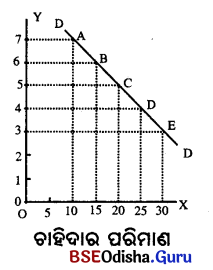
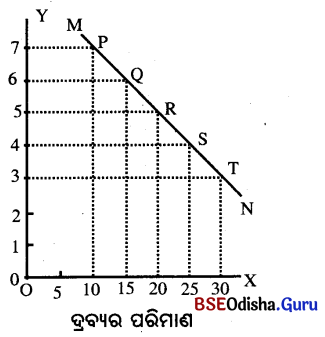
![]()
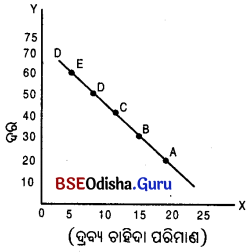
![]()
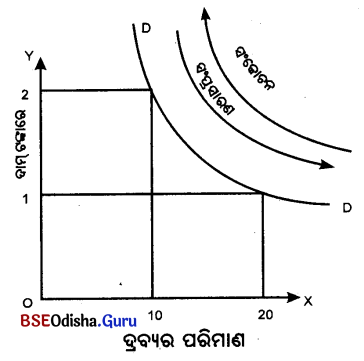
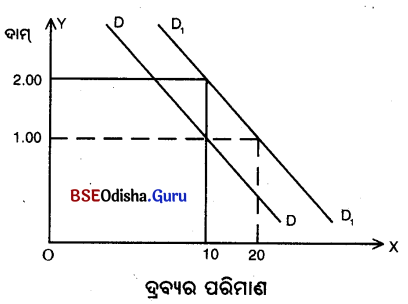
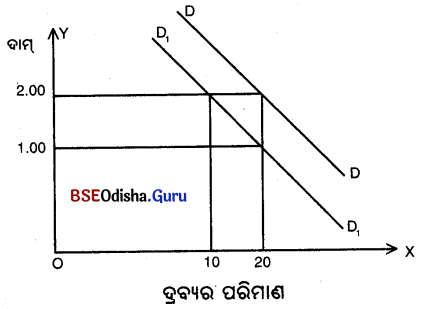
![]()
